








2023 Beef Quality Assurance Training ................................................................................... page 60
2023 South Carolina Sale Barn Cattle Receipts ..................................................................... page 35
2024 Clemson Bull Test Call for Nominations, by Dr. Steven E. Meadows .......................... page 58
A Message from the CEO — Making Ourselves Better, by Colin Woodall ...................... page 60
Alltech News ............................................................................................................................... page 80
Amazing Grazing — Touring Around Town, by Kendra Phipps ........................................... page 16
American Angus Association News ........................................................................................ page 32
American Gelbvieh Association News .................................................................................. page 40 American Hereford Association News .................................................................................. page 45
Animal Agriculture Alliance News .......................................................................................... page 74
Ashley’s Beef Corner — Pride in Agriculture, by Ashley W. Herring ................................. page 14
Beef Checkoff News .................................................................................................................. page 62
Beef Cuts and Recommended Cooking Methods ................................................................ page 54
Beef Tips — Culling to Cash In, by Dr. Steven E. Meadows .................................................... page 20
BioZyme News ........................................................................................................................... page 67
Carolina Cooking — Tangy Lime Grilled Top Round Steak ................................................. page 17
Cattlemen’s Beef Board Update
— Beef Producers Must Share Their Environment Stories, by John Ferry ................ page 55
Certified Angus Beef News ...................................................................................................... page 34
Corteva News
page 78
Director’s Report — Spring Awakening, by Travis W. Mitchell ............................................. page 3
E.B.’s View from the Cow Pasture
— Kids Are Smarter Today Than They Were 50 Years Ago, by E.B. Harris ........ ...... page 18
Federation of State Beef Councils — Celebrating 60 Years! ...................................... pages 62-63
Forage News — Incorporting Annual Summer Forages Into Livestock Systems, by Lilane Silva ........................................................................................................................... page 25
Harvey William “Red” Dunlap Passes ................................................................................... page 30
Have You Herd — New and Improved Beef Cuts
— It’s What’s for Dinner, by Maddie Kuwada ................................................................... page 28
Herd Management — Artificial Insemination — The Supplies You’ll Need, Plus Best Practices to Follow, by Tony Hawkins, DVM .................................................... page 26
High School Students from Across N.C.
Get a Glimpse of College Life at UMO AgFest .................................................................. page 14
John Deere News ........................................................................................................................ page 55
Livestock Marketing Association News ................................................................................ page 78
May is Beef Month in North Carolina! ...................................................................................... page 2
N.C. BCIP Bull Test 2023 Consignments ................................................................................. page 57
National Cattlemen’s Beef Association News ...................................................................... page 58
National Cattlemen’s Beef Association President’s Report
— Advancing for the Future, by Todd Wilkinson .............................................................. page 65
New NCCA Members for 2023 ................................................................................................ page 50
North Carolina Ag Mag ................................................................. pages 41-44
North Carolina Cattle Receipts, Trends, and Prices ............................................................ page 67
Organic Trace Minerals’ Impact on Reproductive Efficiency and Fetal Programming, by Laurentia Van Rensburg .................................................................................................... page 52
Pasture Managment Systems, Inc. Mile of Fence Program Update ................................. page 49
Ridley Block News ...................................................................................................................... page 39
Riomax News .............................................................................................................................. page 63
S.C. Charolais Association News, by Georgeanne Webb ...................................................... page 53
South Carolina Cattle Receipts, Trends, and Prices ............................................................ page 68
The Chaplain’s Corral — Saved From What?, by Skeeter Spaulding ................................... page 19
The Simmental Trail, by Jennie Rucker ..................................................................................... page 36
Understanding Carbon Credits for Beef Sustainability, by Emily Stackhouse ................. page 51 Valley Vet News ......................................................................................................................... page 56
Vytelle News page 80
You Decide!, by Dr. Mike Walden ............................................................................................. page 30
N.C. Cattlemen’s Association
President SCOTT WEST
489 Panacea Springs Road • Littleton, NC 27850
Vice Presidents
RYAN CLARK
5250 NC 772 Hwy. • Madison, NC 27025
BRANDON BOWMAN
2346 Ann Street • Claremont, NC 28610
JIM LEDFORD
260 Mulberry Lane • Otto, NC 28763
Immediate Past President
BURON LANIER
2877 Piney Woods Road • Burgaw, NC 28425
NCBA Regional Vice President (Policy)
FRED SMITH, JR.
NCBA Policy Division Director - JOHN LANGDON
N.C. Beef Council Director
RALPH BLALOCK, JR.
Beef Board Director - BRIAN WARREN
Secretary/Treasurer - EVERETT JOHNSON
Directors At Large
MATT POORE • NEIL BOWMAN • TODD SEE
Executive Director - BRYAN K. BLINSON
2228 N. Main Street • Fuquay-Varina, NC 27526
N.C. Cattlemen’s Beef Council
Director of Consumer Information
ASHLEY W. HERRING
Administrative Assistant - KIM BURDGE
S.C. Cattlemen’s Association
Executive Director - TRAVIS MITCHELL
P.O. Box 207 • Saluda, SC 29138
Phone: 803-609-2828
Email: twmitch@clemson.edu
Website: www.sccattlemen.wildapricot.org
Executive Committee
President - Timmy Benton
1st Vice President - Joe Oswald IV
2nd Vice President - Gene Crim
Secretary - Carol Hendrix
Treasurer - Eric Seymour
Past President - Roscoe Kyle
John Lews, Chester • Joe Oswald, IV, Allendale
Roscoe Kyle, Inman • Terry Kirkland, Batesburg
Lloyd Baxley, Georgetown • Joe Davis, Westminster
Michael Hall, Abbeville • Richard Sox, Lexington
Carol Hendrix, Westminister • Jamie Driggers, Hamer
Timmy Benton, Walterboro • Michael Bailey, Lancaster
Bonnie Cann, Abbeville • Ashley Mills, Blair
Drake Yon, Ridge Spring • Gene Crim, St. Matthews
Lee Haddon, Gaffney • Eric Seymour, Columbia
S.C. Beef Council
P.O. Box 11280 • Columbia, SC 29211
Phone: 803-917-1119
Email: scbeef@scda.sc.gov
Website: www.sccattle.org
Vol. 37, No. 5 MAY 2023
Sales & Publication Office 2228 N. Main Street Fuquay-Varina, NC 27526
Phone: 919-552-9111
Fax: 919-552-9216
Email: mail@nccattle.com
Website: www.nccattle.com
The Carolina Cattle Connection is printed on 30 lb recycled newsprint by BN Printing in Benson, N.C.
Manager, N.C. BRYAN BLINSON
Manager, S.C. TRAVIS MITCHELL
Editor & Advertising Director CASEY L. HINNANT
Assistant Editor & Proofreader KIM BURDGE
N.C. Circulation KIM BURDGE
S.C. Circulation TRAVIS MITCHELL
Material in The Carolina Cattle Connection is not to be reproduced in total or in part without the written permission of the Editor. All submissions become property of The Carolina Cattle Connection, but we make every effort to return items such as photographs and artwork as requested.
The Carolina Cattle Connection, the official publication of the N.C. Cattlemen’s Association and the S.C. Cattlemen’s Association is published monthly by the N.C. Cattlemen’s Association.
A complementary subscription is included with membership to each state’s association. Nonmember subscriptions are $30 per year.
All address changes for NCCA members to: The Carolina Cattle Connection 2228 N. Main Street • Fuquay-Varina, NC 27526
All address changes for SCCA members to: The Carolina Cattle Connection P.O. Box 207 • Saluda, SC 29138
American Brahman Breeders Association Executive Update, by Dr. Joe C. Paschal … page 4
American Brahman Breeders Association History … page 4
American Brahman Breeders Association News … page 7
Brahman History — Crossbreeding’s Common Denominator … page 6
Can Do Attitude Breeds Success at Morrison Farm, by Janen Jones Benson … page 12
Carolinas Brahman Breeders Association — Humble Beginnings … page 11
Standard of Excellence … page 13
The American Brahman — Breeding the Best … page 5
The Brahman F1 — A Solution for Southern Cattlemen, by Dr. David Riley … page 8
WHEREAS, according to the 2022 North Carolina Agricultural Statistics Book published by the N.C. Department of Agriculture and Consumer Services, there are currently over 785,000 cattle in North Carolina that provide a variety of food, leather, and other products to the citizens of this State; and
WHEREAS, according to the 2022 North Carolina Agricultural Statistics Book published by the N.C. Department of Agriculture and Consumer Services, North Carolina farmers raise cattle in all 100 counties; and
WHEREAS, because of cooperation between beef producers and the North Carolina Cattlemen’s Association, North Carolina Department of Agriculture and Consumer Services, North Carolina State University, North Carolina A&T State University, and allied industry, thousands of farms are flourishing across the State; and
WHEREAS, according to the 2022 North Carolina Agricultural Statistics Book published by the N.C. Department of Agriculture and Consumer Services, beef and beef products are naturally nutrient rich, providing Americans with a high quality source of protein, zinc, iron, and B vitamins, leading nine out of ten households to serve beef at least once every two weeks; and
WHEREAS, according to the 2022 North Carolina Agricultural Statistics Book published by the N.C. Department of Agriculture and Consumer Services, cattle farms generate more than $260 million in cash receipts each year making the beef industry yet another part of the total diversification of agriculture in this state;
NOW, THEREFORE, I, Roy Cooper, Governor of the State of North Carolina, do hereby proclaim May 2023, as “BEEF MONTH” in North Carolina and commend this observance to all our citizens.
IN WITNESS WHEREOF, I have hereunto set my hand and affixed the Great Seal of the State of North Carolina at the Capitol in Raleigh this thirtieth day of April in the year of our Lord two thousand and twenty-three, and of the Independence of the United States of America the two hundred and forty-seventh.

The spring season is always an exciting time in agriculture. Cattle producers can finally enjoy watching their cattle graze lush green grass and can begin preparing for the upcoming hay season. This spring particularly brings a heightened sense of optimism in the beef cattle industry. Prices paid for cull cows and calves remain strong and are forecasted to climb higher as we move into grilling season.
It has been great seeing so many of you at the various bull and female production sales and cattlemen’s association meetings held around the state this year. The numerous county Cattlemen’s Association meetings

I have attended this year have been well attended, and all have had a great educational program.
The Clemson Extension Livestock & Forages team hosted numerous cool season annual forage field days in March and April. Cool season annual forage plots were planted at local producer’s farms and research stations across South Carolina. Planted varieties included cereal grains such as rye, wheat, oats, and triticale. The demonstration plots also had legumes such as alfalfa and many different clover varieties. Producers who attended these field days could see which varieties performed the best.
Dr. Liliane Silva, Clemson ExtensionForage Specialist, attended each field day and explained the establishment and management procedures for each variety planted.
The S.C. Cattlemen’s Association will host a series of regional meetings again this year in late August. Plans are currently being finalized with the exact
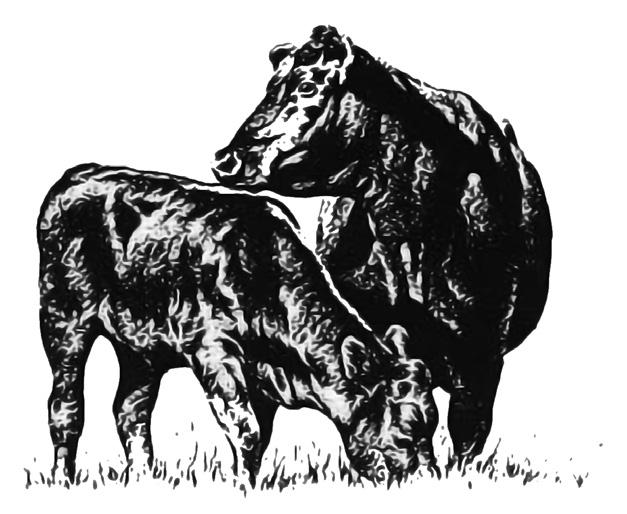
locations for these regional meetings.
In closing, I would like to thank you for your membership. Whether you are a member of North Carolina or South Carolina, your membership is appreciated. It allows us to work on your behalf to advance the cattle industry’s economic, political, and social interests.
Our breed Spotlight special sections are excellent forums to reach producers and cattle industry insiders in the Carolinas and throughout the Southeast. Advertisers also receive a special discount for placing their message in the Spotlight.
Dear ABBA Members, I wanted to catch you up on a few things. As I have related, this is my way of reaching out to each ABBA member to tell them what I am, or the staff is, doing and why. It might not all be of interest to you, but I want you to know so you can respond if you want. I’ll take it to heart, I promise.
A new slate of officers and directors was elected in Houston, and the staff and I look forward to working with all of them. Work here in the office is cyclical, much like ranch work. At certain times of the year, there are things that need to be done, and if you are prepared to do them and have the equipment to do them, it makes doing them much easier. It also makes things easier if you know what needs to be done and how to do it. Right now, those are the things I am learning in the office. Fortunately, I have a great staff that knows what needs to be done.
What is needed now is a larger viewwhere should the Brahman breed be in 5 or 10 years? I came from an organization that had frequent change for 40 years. That type of change wastes a lot of time, money, and effort. I want to see the Brahman breed and the association move forward towards some long term goals, bringing every member with it. I have asked President Mark Forgason to create a Long Range Planning Committee to do just that. In order to make the Association and office more efficient and effective, we need to have those goals and objectives outlined and planned to be accomplished in a timely manner.
I plan on working more closely with the committees as well. I would like to have each committee provide some objectives to work toward. An example of one thing that I would like to do is have a planned print advertising campaign that emphasizes the F1 Brahman cow, the F1 Brahman feeder calf (feeding and carcass value), the Brahman bull, and then the Brahman cow. We can develop the material which could be used by the membership. These ads could be used on social media and be the blueprint for promotional material for field days and cattle
conventions. They could also be translated into any language to suit ABBA’s needs.
As part of my long range plan for the office and ABBA, I am looking to have one person be responsible for all our junior activities and open shows, and another be responsible for communications and promotion. I know we have a special committee to look into how ABBA will interact with shows in the future, but I’ll not go into their deliberations. Regardless of the decision made, there is a huge need for someone to manage and develop the ABBA Junior Program (not just the AJBA All American) into an educational training ground for young leaders in the Brahman breed. Caydi Blaha was employed last December to work in all these areas, and she has done a terrific job, but I need her skills to be 100 percent focused on communications with you and the promotion of the Brahman breed.
Genetic Visions, the genomics company associated with S.T. Genetics, was voted on by the Board to be one of our three genomics providers about two years ago. A.J. Knowles and I have reached out to them and are working through the details of getting their results formatted for use in our programs. They join Zoetis and Neogen as our genomics providers with the same fees.
After Houston, the staff began final preparations for the 37 th 2023 ABBA National F1 and Brahman Sale, and considering this was the first sale for us, the staff was exceptional in its efforts to make it succeed. I want to thank the committee for all of their hard work. Terry Novak, O.W. Schneider, and the committee worked tirelessly to find consignors, buyers, and sponsors. I know we will continue to have the sale; plans are already in the works to make the 2024 sale even better.
ABBA has had its second genetic evaluation since I have been here. The correlation between the EPDs for the various traits (old versus new EPD) is in the high 90 percent range (97-99 percent). You expect them to change as new data is added. Some will increase, and others will decrease, but in all cases, the accuracy of
the EPD should increase. Animals with high accuracy EPD for a trait (more than 70 percent) should change very little. Those with low accuracy could change quite a bit with added information (their own or close relatives). If you see something that doesn’t look right, please let A.J. or me know.
Recently I was in the Dominican Republic and then Belize (on their dimes) promoting Brahman cattle. I have many friends in the Dominican Republic and most of them use Brahman cattle, red and grey, as purebreds but also in crosses. I had the chance to be introduced to and visit with their Secretary of Agriculture. I was also able to attend a cattlemen’s seminar. Last week I was in Belize with Judd Cullers, where I visited several ranches in a Mennonite community. They have about 100,000 head of cattle in Belize, and about 90,000 are owned by Mennonites and are mostly Nelore. But there is strong interest in Brahman cattle. I gave a couple of educational presentations to nearly standing (or sitting) room only crowds. There were a lot of questions about Brahmans.
ABBA had a booth at the Texas and Southwestern Cattle Raisers Convention in Ft. Worth. Idi, A.J., and Caydi were there to attend meetings, answer questions
about the Brahman breed, and interact with several breeders. We also gave a “performance package” as a raffle gift as part of the promotion of Brahman cattle. Our winner was Ariya Milyard!
I plan to travel across the Southeast and Texas this spring and summer. A.J. and I were in Florida to attend the Florida Brahman Association Field Day on April 20. A.J. and I also attended the STBBA Spring Meeting on April 29 in Kingsville. We will drive over and maybe see some of you there or on the way there and back. I want to try and get to as many of those types of events as possible. If you have a regional meeting, field day, state cattlemen’s convention, or a beef cattle short course, let me know, and we will try to be there. I believe that grassroots promotion, oneon-one, is one of our best approaches to promoting the Brahman breed!
There are many activities coming up, the ABBA Bull Gain Test begins on May 2, the Beef Improvement Federation will hold its annual meeting in Calgary, Canada, from July 3-5, and the Texas A&M Beef Cattle Short Course is August 7-9. If you are interested in attending or would like me to attend your event, let me know.
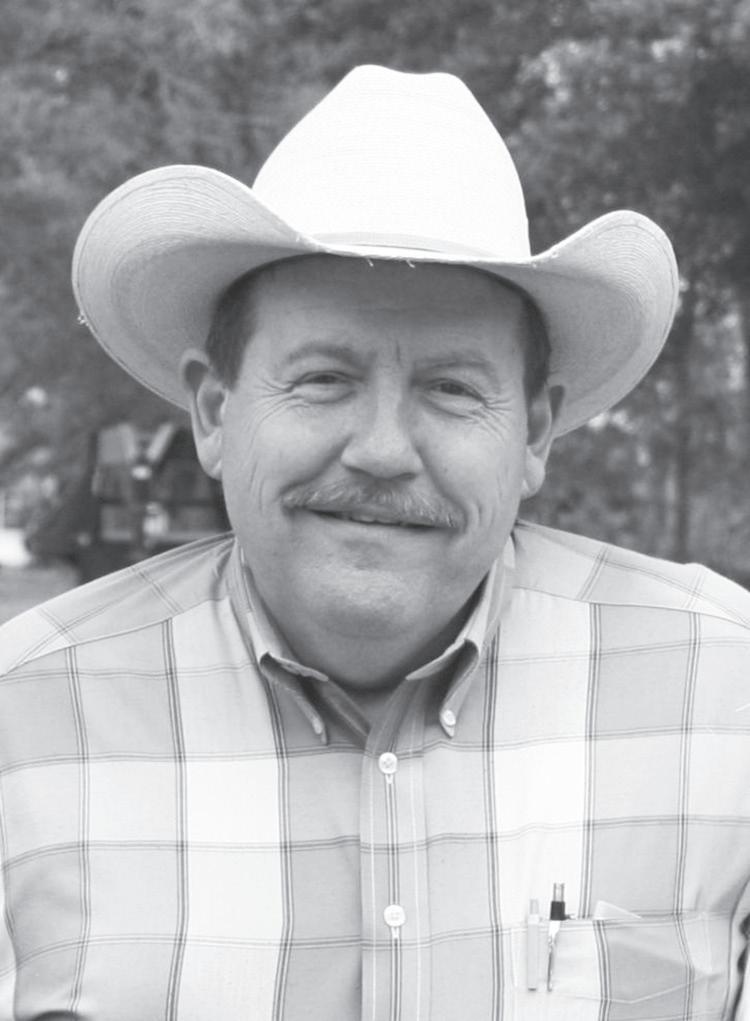
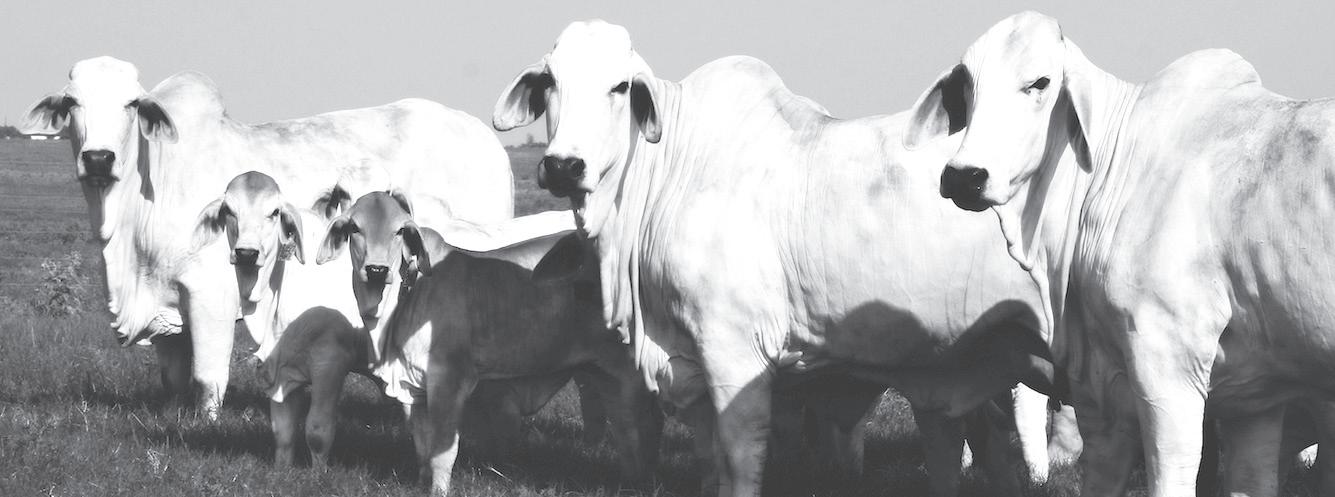
The American Brahman Breeders Association is the world registry for Brahman cattle, the #1 beef breed for efficiency, hybrid vigor, and environmental adaptability.
The ABBA was founded in 1924 as the official breed registry of American Brahman cattle in the United States. Its original mission was to maintain parentage and ownership records of American Brahman cattle; however, through the years, it has grown to provide an array of member services, educational opportunities, and programs. Internationally recognized as a leading beef cattle association, ABBA offers a wide array of programs to assist the profitability of its members.
The ABBA is a membership organization governed by an elected board of directors. Members of the board as well as other volunteers are assigned to committees that meet regularly to propose ideas of ways to better serve the members through programs, services, or activities. The ABBA staff and leaders are always looking for ways to improve the breed and the organization and welcome input from the membership.
The ABBA is based in Houston, Texas. Registrations, transfers, and F-1 certificates are processed in Kansas City, Missouri. For more information about the Brahman breed or the many opportunities offered by ABBA, please contact our office or visit our website at www.brahman.org
In the Southern United States, the cattle are still king, but so is the heat. Though it varies from coast to coast, the majority of the region spends almost a third of the year facing temperatures over 90ºF and almost half the year with temperatures over 85ºF — a climate uncomfortable to humans, but potentially deadly to livestock. Originating from several Indian breeds of cattle that thrived in regions where insects, disease, dry, harsh terrain, and the extreme temperatures were the norm, the Brahman is a true masterpiece of genetic design — a breed as easy to raise as they are to recognize.
A product of the Guzerat, the Gir, the Nellore, and the Krishna Valley breeds, the American Brahman was born of necessity for hearty beef and milk producing cattle that would not struggle amid the often cattle unfriendly climate. Similar in appearance to the Zebu (or Bos indicus) native to India, Brahmans feature a variety of colors (light gray, red, and black), but a well defined hump between the shoulder blades, longer ears, and heavy dewlap under the neck are the truly distinctive traits.
For Brahman, every aspect of their physique contributes to their productivity and resilience. To protect themselves from the sun’s rays and excessive heat, Brahmans have dark pigmentation encircling the eyes that helps prevent cancer eye, loose skin with thick, glossy hair that provides a thermal barrier,
and an increased size, number, and productivity of sweat glands that allow them to sweat freely.
Normally, where heat reigns, forage suffers. In addition, Brahmans better utilize low quality browse and require less water intake (resulting in reduced urination and nitrogen loss). Their digestive efficiency allows for superior muscle and tissue development even on low feed intake, as well as the ability to recycle nutrients through the bloodstream and saliva. Their cattle tick resistance stems from a sleek coat unfavorable for tick attachment, an immune response that prevents tick development and chemicals in the sweat that act as a repellant. Brahmans can also travel extensively and produce the maximum quality of beef and milk from minimal resources.
“What’s exceptional about Brahman’s is their low maintenance and adaptability,” said Cyana Briles, president of the Eastern Brahman Breeders Association. “These animals will survive in places where raising cattle was thought impossible, and the rate of their influence has expanded faster than any other breed in the world. Part of the priority of the EBBA is to educate breeders about these wonderfully diverse animals and the numerous benefits they bring to the ranching lifestyle.”
Alone, Brahman cattle offer a wealth of positive aspects, but when crossbred with European Bos taurus, the result is maximum hybrid vigor (heterosis). This
term refers to crossbred offspring who possess superior traits to their parents — a result most effective when breeds with differing traits are introduced.
For example, Bos taurus are known for their excellent muscle patterning and beef production but are highly susceptible to heat and disease. Bos indicus function well in rough climates, but are known for their hardiness and efficient beef production. American Brahmans marry the best of both parents, and when partnered with varying breeds, naturally produce high quality first cross (F1) offspring. Second to none in attaining this level of heterosis, this innovative crossbreeding results in offspring with superior weight, carcass efficiency, and reproductive performance.
F1 females possess an unprecedented maternal instinct. Born to nurture, the females have a lifespan that surpasses that of any European breed, an extended breeding window, often 50 percent longer than many other breeds, a fierce protective nature toward calves from predators, and the ability to produce high quality milk in vast quantities.

“In essence, an F1 female is unmatched. She has a higher bred-in environmental adaptivity, increased milk production, higher fertility, and heat and the disease resistance of her Brahman parent. These aren’t your regular cattle. They’re strong, resilient, and are highly regarded by commercial cattlemen as a maternal machine with no peers,” said
Briles. “And their offspring are a direct reflection of that quality.”
In addition, F1 steers have their own distinct set of attributes, including rapid growth, efficient gaining, and excellent beef quality. They produce high cutability carcasses with less excessive fat but still retain the exceptional standard of quality, flavor, and tenderness in demand worldwide.
Today, American Brahman genetics roam around the world in over 74 countries. From Mexico, Central and South America to Africa, Eastern Asia, and Australia, the American Brahman has excelled in every country it has been introduced and will continue to make a huge imprint in the world production of beef and increased milk production. When considering a breed known for exceptional production, maximum efficiency, and unparalleled versatility, Brahman is the choice for all the right reasons.
Not only is the American Brahman a great breed of cattle, but is backed by a great organization.
Founded in 2018, the Eastern Brahman Breeders Association is a promotional group of the American Brahman Breeders Association headquartered in Houston, Texas. The EBBA offers a number of membership, breed improvement, promotion, marketing, and educational programs. A few of the most exciting programs they offer are their annual consignment sale that will be held online this year (due to the COVID-19 pandemic) May 20-21, the Eastern Brahman Extravaganza Show that will be held at the N.C. Mountain State Fair, and the 4-H Heifer Lease Program.
“The EBBA is a really good organization that provides a wide range of services to its members,” said Travis McCutchen. “I chose Brahmans because they adapt so well to our environment, and there is a strong market for commercial breeders. I just like to breed the best!”
For more information on the American Brahman and the Eastern Brahman Breeders Association, please contact EBBA President Cyana Briles at 336-410-2126 (she really enjoys talking to folks about Brahman cattle) or by email info@EasternBrahman.com. Visit www.easternbrahman.com for more details.
As the first beef breed developed in the United States, the American Brahman has played an important role, not only in crossbreeding programs throughout the United States and beyond, but it has become a common thread among other American breeds developed in the last century. American Brahman influence in the beef industry is felt world wide, and their genetics are sought by cattlemen in every continent. Their development is a success story unparalled. Today’s cattlemen breed Brahmans for all the right reasons.

Originating from a nucleus of approximately 266 bulls and 22 females of several Bos indicus (cattle of India) types imported into the United States between 1854 and 1926. Today, the Brahman breed has achieved acceptance for their environmental adaptivity, longevity, mothering ability, and efficient beef production. Bos indicus cattle have been serving man for thousands of years. Throughout their evolution, they have endured famine, insect pests, diseases, and extreme temperature fluctuations. Thus, through natural selection, these cattle came to have the ability to survive and thrive where other types have failed. In their expansion, these cattle have improved beef production in every country in which they have been introduced, as they are mated to existing
native cattle. While some 30 defined breeds or types of Bos indicus cattle have been identified in India, only a few of these breeds were selected to develop the American Brahman.
The first importation of Indian cattle of any notoriety came in 1854, when sugar and cotton farmer Richard Barrow of St. Francisville, La., was presented with two bulls by the government of Great Britian for his services in teaching cotton and sugar cane production to British officials establishing these crops in the deltas of India. Their offspring, known as Barrow grade cattle, would achieve recognition, and their fame would soon spread around the globe. Later importations would see cattle brought from Brazil, where large numbers of these Indian cattle could be found.
The American Brahman Breeders Association was organized in 1924. J.W. Sartwelle of Houston was the first recording secretary of the Association, and it was he who proposed the word “Brahman” and so it was adopted as the name of the new beef breed. With strict selection, guided by the standard of excellence developed by founding breeders, the American Brahman has been recognized for its exceptional hardiness and physical stamina, its ability to profitably produce on marginal lands, to live twice as long as
normally expected, and with unequaled performance in weight per day of age.
As consumers shift to lean meat and lower calorie diets, Brahmans are perfectly positioned to fill the demand for a beef product which efficiently converts feed into high quality beef while producing a carcass free of excess fat.
The American Brahman excels in adding hybrid vigor to their offspring when crossed with other breeds, resulting in more money in your pocket as a beef producer. Hybrid vigor (or heterosis) is an animal breeding or genetics term that is achieved by crossing two different strains, varieties, breeds, or species. In the cattle world, maximum hybrid vigor is obtained by crossing totally unrelated animals, achieving the “best of both worlds.”
Because of this added hybrid vigor, the use of Brahman bulls with European or English breed cows is one of the most popular crossbreeding practices in the United States, with the resulting Brahman F-1 calf in high demand by cattlemen for replacement females or feeders in the feedlot.
Years of crossbreeding research has consistently shown that ranchers get higher levels of heterosis when you cross a Brahman with a British or Continental breed, compared to just breeding British
or Continental breeds to each other. Because of this, Brahman cattle are often referred to as crossbreeding’s common denominator. The Brahman F-1 cross is consistently superior to other crosses in weight per day of age and carcass efficiency. The Brahman F-1 is also very popular because these cattle display many important characteristics of their Brahman parent, such as drought resistance, heat tolerance, disease and parasite resistance, and increased longevity.
Queens of Cow Country
F-1 Brahman females are maternal machines. They have increased milk production, higher fertility, and wean faster growing calves with fewer inputs. Plus, she will have a longer productive life, raising more calves over her lifetime than other breeds. In the feedlot, Brahman hybrid steers remain healthier and make the most rapid, efficient gains while producing heavier, higher yielding carcasses that are free of excess fat, which today’s packer and health conscious consumer demand.
Environmental Adaptibility
Brahmans have dark skin pigmentation, which filters the intense rays of the sun as well as keeps the breed free of cancer eye. Other environmental adaptations which make the Brahman
breed so well suited to so many areas of the country include the ability to utilize lower quality feed, to travel longer distances for feed and water, and to resist insects and external parasites while withstanding vast climactic differences. They also have the ability to reproduce on a regular basis in a stressful environment. Brahman cattle show no effect from extremely high temperatures.
A factor which contributes to the Brahman’s unique ability to withstand temperature extremes is a short, thick, glossy hair coat which reflects much of the sun’s rays, allowing them to graze in midday sun without suffering. In severe winters, Brahmans grow a protective covering of long, coarse hair beneath which a dense, downy, fur like undercoat can be found. An abundance of loose skin, characteristic of the breed, also aids in its ability to withstand warm weather by increasing the body surface area exposed to cooling. In cold weather, the skin is contracted, increasing the thickness of the hide and density of the hair, which aids in retaining body heat. A special feature of the Brahman breed is their ability over other breeds to sweat freely, which contributes greatly to their heat tolerance.
of the country during hot, humid months when the feed efficiency of European and British calves and crosses decreases. The ability of these Brahman cross cattle to finish during warm seasons is a definite economic factor in their favor.
While efficiency is an important quality of the Brahman and its crosses, the carcasses are known for their high cutability, which results in a high yielding carcass with limited fat. In a recent study conducted by Texas A&M, Angus and Hereford cows were bred to Brahman bulls. The resulting steers were handled as calf feds going directly into the feedlot at weaning. The steers were fed for 180 days and slaughtered at 13-14 months. The first calf crops produced 89 steers, with no death loss experienced postweaning. Of those fed, 58 percent of the steers graded Choice, with the rest in the window of acceptability.
Tenderness readings using the Warner-Bratzler shear force test were taken at 0, 7, and 14 days. With this data, a rating of ten pounds or less is considered satisfactory for supermarket sales, while a rating of 8.7 pounds or less is desirable for steaks utilized in quality restaurants. Of the 89 samples, 84 were below the ten pound level at 14 days with the best rating being 5.7 pounds.

A.J. Knowles Joins ABBA as Director of Breed Improvement. Please join us in welcoming the newest member of the ABBA team, A.J. Knowles! Knowles joins the American Brahman Breeders Association as the Director of Breed Improvement.
A.J. has lived in numerous places inside and outside of Texas. He began his undergraduate degree at West Texas A&M before transferring to Texas A&M in College Station. He received his Bachelor’s in animal science and obtained a Master’s degree in animal breeding with Dr. Andy Herring supervising. Since then, he has studied at Virginia Tech and is in the process of completing a Ph.D. in animal science at the University of Missouri with Dr. Jared Decker, studying the genetics and genomics of beef cattle.
“I am excited to bring my research network, experience, and perspectives to the American Brahman Breeders Association, and I hope that together we can help the breed make great strides in genetic progress for a multitude of traits,” said Knowles.
A.J. can be reached via email at ajknowles@brahman.org
ABBA Seeks Youth Activities
- Show Coordinator. The American Brahman Breeders Association (ABBA) is seeking qualified candidates for the Youth Activities-Show Coordinator position. The position shall be responsible for the conducting of all show related events engaged in by the ABBA/AJBA and shall represent the Association at the direction of the Executive Vice President.

This position will be responsible for administrating the American Junior Brahman Association (AJBA) youth programs sponsored by the ABBA, coordinating and working closely with the ABBA Youth & Show committees, and performing all other duties properly ordered by the Executive Vice President or the Board of Directors, which usually pertain to the position of Youth Activities-Show Coordinator.
Brahman hybrid calves and those out of Brahman F-1 cows are noted for their fast gains, and it’s a fact that these calves consistently produce more weight per day of age than most other breed contemporaries. Brahman cross calves are more desirable to feed in many parts
Add more beef to your milk program with the American Brahman! The American Brahman is known the world over for their crossbreeding excellence; however, many dairy producers in the southern United States and South and Central America also utilize the American Brahman in crossbreeding with dairy breeds. These dual purpose animals are the future of the cattle industry in the tropics. Using American Brahmans in the tropics will result in adaptability, fertility, disease resistance, and longevity. American Brahman genetics give you heavier weaning weights, more quality beef, and more salvage value at production termination. They also add additional butter fat content and protein, as well as increased production and net income.
Recent crossbreeding reports from South America have shown the American Brahman to be an ideal cross with a variety of dairy breeds including Holstein, Jersey, Brown Swiss, and more.

His work has been variable, beginning with studying immune response and breed-of-origin effects in Bos indicus–Bos taurus crossbred steers challenged with Bovine Viral Diarrhea (BVD). Since then, his work has focused primarily on genetic evaluations and genotype-byenvironment interactions. In his time at Virginia Tech, he composed a program that compiles the National Aeronautics and Space Administration’s satellite weather data and attached weather events to cattle, which will eventually allow for the integration of weather data as an effect in models. More recently, however, he has worked closely with the American Angus Association to re-evaluate their current fertility traits, as well as investigate the heritability and model accuracies of potential new traits for their evaluation.
For more information, including responsibilities and qualifications, visit brahman.org/wp-content/uploads/2023/04/ Youth-Activities-Show-Coordinator.pdf. If you have any questions in regard to the position, please contact the ABBA Office at 979-485-5528. All applications must include a cover letter and professional resume and can be emailed to cblaha@brahman.org. All applications will be kept strictly confidential and will be accepted until a suitable candidate is able to fill the position.
About the American Brahman Breeders Association. The American Brahman Breeders Association is the world registry for Brahman cattle, the #1 beef breed for efficiency, hybrid vigor, and environmental adaptability. ABBA provides an array of member services, educational opportunities, and a wide array of programs to assist the profitability of its members. For more information about the American Brahman breed or the many opportunities offered by the ABBA, visit www.brahman.org

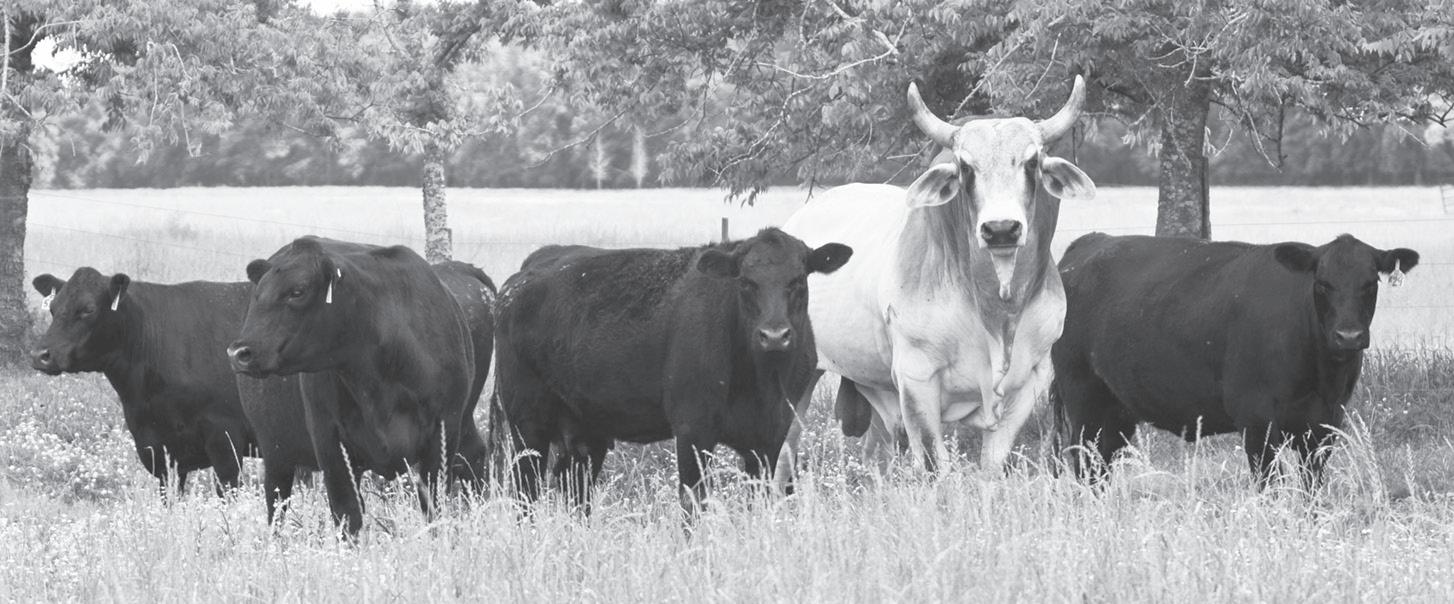 By DR. DAVID RILEY Texas A&M University
By DR. DAVID RILEY Texas A&M University
Across the United States, the makeup of commercial cow herds varies to fit various environments. In the South, increased heat and humidity require cattle that are able to perform in these conditions. The ability of Brahman cattle to withstand these conditions allowed the breed to become a staple of commercial cattle production in the Deep South. In particular, the use of Brahman in crossbreeding, primarily with British breeds, to produce extremely popular F1 offspring is perhaps the most common source of influence on the commercial cow herd of the Southeast. While the F1s are most noted for their superior reproduction and maternal ability,
there are other redeeming qualities of F1s to consider. The ability of these cattle to grow and perform to weaning outshines crossbred calves solely of British and Continental breed origin. In the feedlot, F1 Brahman calves are able to successfully grow and convert feed to pounds of product in the proper environment. However, the importance of the F1 female as an elite brood cow in the South can’t be overlooked.
When a vast majority of the commercial cow base is British and Continental influenced, using Brahman bulls presents the opportunity for added offspring performance due to heterosis. Heterosis, or hybrid vigor, is the added
performance of crossbred individuals over the averages of their straightbred parents. The greater differences between the two breeds result in greater effects from heterosis. It has been documented and widely known for over 50 years that crossing Brahman, a Bos indicus breed, with a British or Continental breed (Bos taurus ), results in much more heterosis than crossbred cows of any other breeds.
Added Growth and PerformanceHeterosis affects performance traits, such as weights and growth rates. Brahman F1 calves exhibit as much as a five percent increase in weaning weight over the average of purebred parents due to heterosis. If the average weaning weight for two parent breeds was 500 lbs, an F1 Brahman cross calf would be expected to weigh 525 lbs at weaning. In today’s market, that’s approximately a $65 increase in calf value due to the added performance of heterosis.
In the right environment, Brahman

influenced feeder cattle can perform as well as their Bos taurus counterparts in gain. F1 Brahman steers often out gain straightbred calves of the parent breeds in feedlots in warmer climates or seasons. Feeders in the southern Great Plains realize the ability of these cattle to grow while handling the harsh temperatures. Half blood Brahmans have the ability to produce carcasses that meet industry standards.
The perception that Brahman and Brahman influenced cattle do not produce high quality retail product is a bit of a misconception. In a Texas A&M study in the 1990s, Brahman sired steers out of Angus and Hereford cows were placed into a feedlot at weaning and fed for 180 days. At approximately 14 months, the steers were harvested. Almost 60 percent of the carcasses graded USDA Choice, comparing favorably to industry wide averages for percentage of Choice cattle. Over 90 percent of carcasses tested with

acceptable ratings for tenderness using the Warner-Bratzler Shear Force test. Traits such as carcass weight, dressing percentage, and yield grade are another area that Brahman cross feeder cattle excel in. Heavier carcasses with a high dressing percentage and less backfat are common. Brahman steers with average carcass weights over 800 lbs, with dressing percentages approaching 65 percent (accepted industry standard is 62 percent) were part of a recent American Brahman Breeders Association (ABBA) Carcass Evaluation.
The F1 Female - The biggest impact of Brahman cattle on commercial cattle production is through the influence of the F1 female as a brood cow in the South. Half blood Brahman cows are highly regarded for their ability to thrive in hot, humid environments like the Brahman.
The influence of heterosis on traits that are not easily improved with selection programs is what distinguishes the F1 female as a superior performer. Traits such as pregnancy rate, calving rate, and weaning rate are always greater in F1 females than in straightbred or Bos taurus cross females. Studies conducted in Florida in the early 2000s have shown the superior performance of Brahman-Angus females over both parent breeds. Pregnancy and calving rates in both Angus and Brahman sired F1 females (93 percent) were 11 to 16 percent greater than the purebred Angus (82 percent) or Brahman (77 percent). Weaning rates were also 15 percent higher than the weighted average of the parent breeds. The increased pregnancy, calving, and weaning rates of F1 Brahman females result in more calves for producers to market and a greater impact on an operation’s bottom line. In addition, F1 Brahman influenced cattle have increased longevity compared to purebred counterparts. A 1988 research project in Texas showed that Brahman sired F1 cows out of Angus and Hereford dams had an average lifespan of almost 14 years, compared to a ten year average lifespan of the parent breeds. Another study from Nevada reported that F1 females with Brahman inheritance had more calves over their lifetime than Bos taurus F1s and purebred Bos taurus, as well as a greater portion of the females stayed in production longer.
The most common breeds to cross
with Brahman for producing F1 females are Angus and Hereford. Breeding Brahman cattle to Herefords results in the very popular “tiger stripe” cow. To allow commercial producers to buy F1 females with confidence, the ABBA established the F1 Certification Program ( www.brahman.org/f1/f1-certification ).
The program includes Golden Certified F1, in which both parents are registered with respective associations, and Certified F1, where the sire must be registered with its respective breed registry and dams are purebred commercial females that have been inspected for their purity by an association representative. Since the program’s inception, over 95,000 females have been enrolled in both ABBA Golden Certified and Certified. While the program enables buyers to have an outlet for verified replacement females, producers marketing the Golden Certified and Certified F1 females receive a premium price. At the Houston Commercial Female Sale, Golden Certified and Certified F1 females average as much as $200 more than other females in the sale over a 17 year period. The offspring of these females are eligible for the F1 Plus Program, creating additional marketing avenues for these cattle.


Brahman’s Influence - In the Southern United States, utilizing Brahman genetics in commercial crossbreeding systems provides heat tolerance, durability, and maximum heterosis throughout the entire production cycle. The added growth of calves preweaning gives cattlemen additional pounds on the scale at market, and these calves can gain and produce quality carcasses through the feedlot and harvest. In the regions of the country where hot, humid summers are an annual fixture, no cow works better in these conditions than the F1 Brahman crossbred. These females can handle the tough conditions
while successfully breeding, calving, and weaning a healthy calf. The added longevity of the F1 Brahman female gives cattlemen a cow that stays in the herd longer, raising more calves over her lifetime. Overall, the influence of
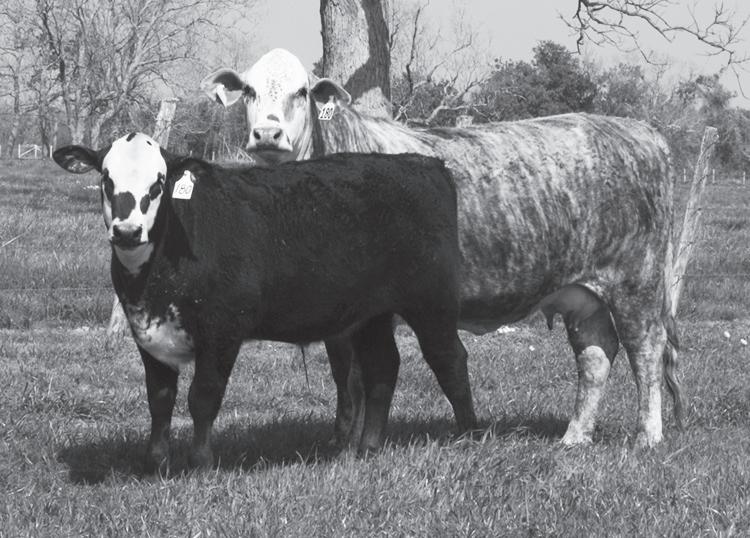
Brahman on commercial cattle production in the South is extremely important. Brahman influenced cattle, especially F1s, carry many productive advantages that help them thrive in the warmer climate of the region.
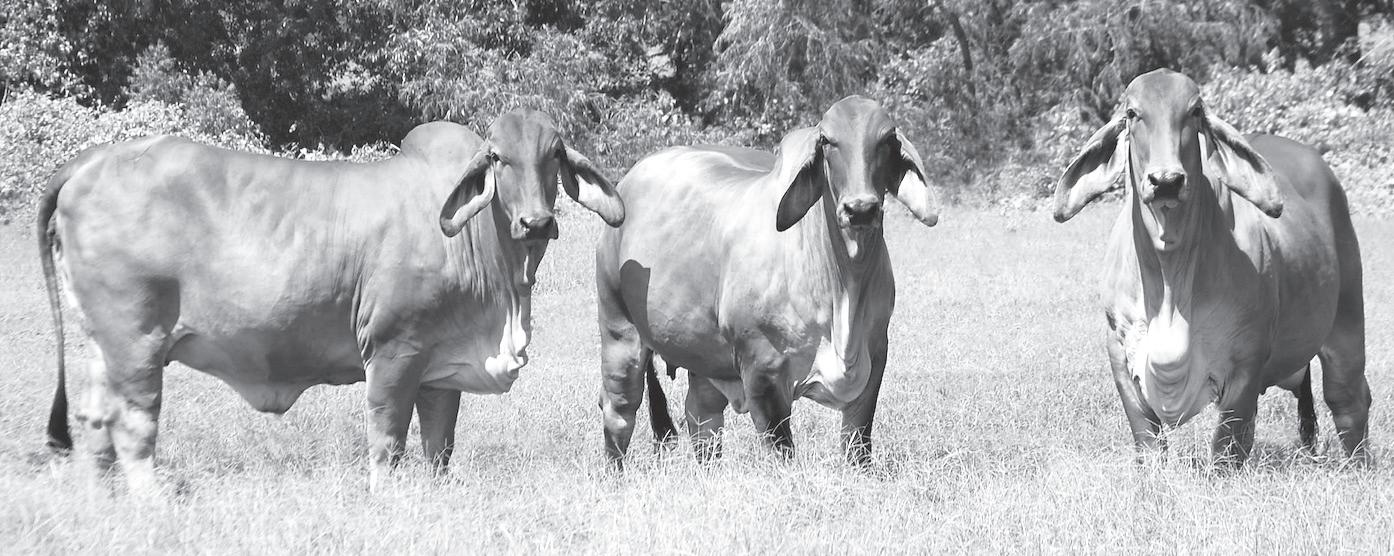

In 1980, a group of Carolina Brahman Breeder Association members got together in Lugoff, S.C., to hold the first CBBA sale day. Forty years later, this sale is still going strong.


Like most organizations, the CBBA started from humble beginnings.
The CBBA began in Concord, N.C., in the front yard of Lewis Patterson’s house when several ranchers gathered to start an organization to bring quality Brahman cattle to the Carolinas. After meeting a few more times, the group decided to create a sale day to bring in new bloodlines and help ranchers create the best herd possible.
yard that day. She was at the first sale and has only missed one over the last 40 years. She has been able to see the sale grow without losing the purpose of providing good quality cattle.
“I think we have done exceptionally well, bringing in cattle that are good cattle to this sale. We don’t worry so much about pedigree as we do about quality.” Morrison said, “What we need is good quality cattle that will keep our herds around here working.”
looks forward to is the Friday Night Fun Auction, created during the 25 th anniversary of the sale. This auction helps raise money for the two scholarships the CBBA offers to college of agriculture students attending Clemson and North Carolina State University. The secretary/ treasurer of CBBA and granddaughter of Patterson, Ann Shaughnessy, has helped with the auction since its start and looks forward to it every year.
“We have had great luck with the auction,” Shaughnessy said. “People enjoy the items that are brought, and it gives everyone a focal point to come together to enjoy each other’s company.”
An event happening for the first time at the 40th CBBA Sale is the CBBA All Star Spectacular Show, which is a show inviting all juniors from across the United States as a kickoff for the All American
show. The All Star Spectacular will start the Thursday before the sale with the junior bull, showmanship, and F-1 show and continue on Friday with the junior female show. This event will allow for more youth to get involved with the sale and create a larger awareness for CBBA.
This sale means more than just looking for new bloodlines to add to their herd for a lot of the ranchers and breeders attending the event. It is a place where they can come together to continue the betterment of the Brahman breed through fellowship.
President of CBBA and auctioneer of the sale, Philip Gilstrap, started attending the sale at just a few months old and has seen firsthand, not only the improvement of the cattle that are brought to the sale, but also how the sale brings people together.

“A group of consignors bring the very best they have to offer from their ranch and are excited to come spend the weekend in a family atmosphere with old friends while meeting new friends,” Gilstrap said.
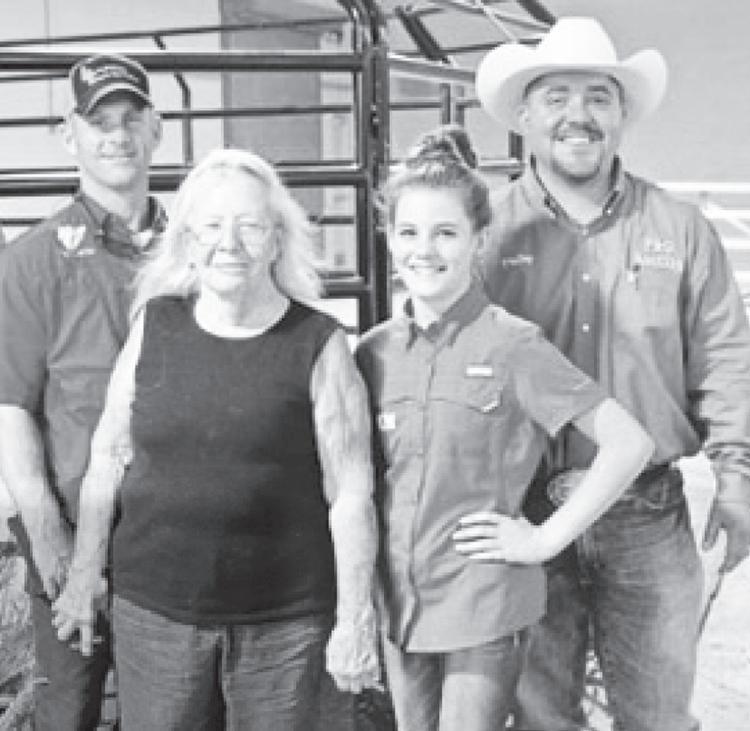
In the beginning, the sale involved people from the Carolinas, Virginia, Georgia, and a few from Tennessee. Now that group has grown, and on sale day, you will find breeders from all over the USA attending the sale.
The founding members put sweat, blood, and tears into making sure the sale happened, no matter what, and this attitude of persistence can still be found in the CBBA directors and officers of today.
North Carolina CBBA Director Myra Morrison, of Morrison Farms out of Rockwell, N.C., is one of the first members who gathered in Patterson’s
The sale grew so much over the years, that over the past 14 years, the sale has been held at the T. Ed Garrison Cattle Complex in Pendleton, S.C., to better fit the size. Clemson University offers a fantastic modern facility that allows the sale to flow smoothly.
“The staff at the barn accommodates us any way possible,” Vice President of CBBA and great grandson of Patterson, John Cline said. “We appreciate everything they do and look forward to working with them every year.”
As the sale has grown, some new additions to the weekend have been created. One event that everyone
This year the CBBA event will start June 11, with the All Star Spectacular and end with the sale on June 13. To learn more about how to get involved with the sale or how to enter the junior shows, you can contact Philip Gilstrap at 864-506-0463.
Reprinted from the March 2020 issue of The Brahman Journal

When Myra Neal Morrison arrived at Morrison Farm, her mother thought it was for a two week visit. That was over 40 years ago.

“She didn’t want me to do it,” Morrison recalls, adding that some people didn’t think she could do it. When she was a teenager, the uncle who managed the farm for her father died; Morrison asked to run it. By 1965 she was doing just that.
Today, she runs a purebred herd of 45 Brahman and 200 Simmental, along with 100 F-1 (Simmental/Brahman cross) steers raised for freezer beef, on 1,050 acres on the Rowan and Cabarrus county lines.
“Unlike a lot of (farmers), I row crop, run purebred cattle, and feed out my cattle using my own grain,“ Morrison said. “I’m just different; I’ve got it all.”
“I feed corn silage five months of the year, starting in January,” she said.
“The silo holds 650 tons.” She hires 150 acres of corn planted each year, using her John Deere eight row planter. She brings in help for spraying, fertilizing,
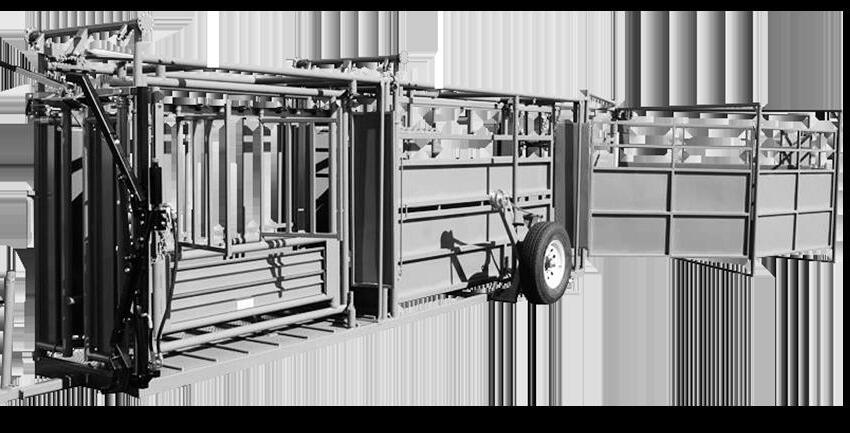
cutting, and combining, although she maintains her own equipment.
“This saves on costs and gets it cut in two or three days,” she added.
The farm also produces barley, hay, and soybeans.
The herd is fed daily at a feedlot, where they circle by in groups of 50 before returning to 30 acre pastures. They have free choice access to high magnesium minerals and synthetic protein on the feedlot.
Thanks to record breaking rainfall in North Carolina this year, hay is so abundant that Morrison is now putting bales out on the pasture. But, several previous years of drought led her to revise her water resources.
“Until the summer of 2002 I was using a creek and just had one well,” she said. “Then I got worried and added another well.” Both wells use electric pumps and most herds have automatic waterers available at all times.
Morrison’s certified and accredited

herd is tested for brucellosis and TB annually. Vaccinations and worming are done at the same time.
“Nobody quite understands why I don’t need to do it (worming) twice, but I don’t,” Morrison said.
“A lot is the condition of the cattle and small pastures, and when I worm at test time in June, it cleans all the pastures out.” She uses Ivomec and Eprinex from Merck.
Morrison breeds year round, using her three bulls, which she prefers, as well as artificial insemination. Maintaining her own tank, she purchases serum from ABS, Select Sires, and at sales.
“(With these sources) you don’t often get anything you don’t want,” she said.
“I breed these cows to the best bulls in the A.I. books. For the Brahman, I try to get the best semen I can afford. Generally, I buy at sales where I know the people and can get them to sign the certificate.”
“With the Simmental cattle, the traits are all there. They’ve got good disposition, good feet, good backs; it’s all there,” Morrison said.
“(With) the newer Simmentals, the solid reds and solid blacks, the disposition kind of (got) knocked out. I prefer the red and whites. I look for good growth, not excellent birth weight. But my half bloods can be 120 to 130 pounds at birth. The Simmentals run 80 to 100 pounds and the Brahman 70 to 85, and here I get these 130 pound calves due to cross breeding. “A disadvantage of the halfbloods is their disposition,” Morrison said.
“They will eat you for breakfast,” she said, adding that they’re not wanted at stockyards.
But she solved that problem, finding that she can feed them out in 15 months and sell them herself.
“They grow out better than purebreds, dress out better than purebreds, and take a third less feed than purebreds. Weather doesn’t matter; they’re tough cattle. I dress 62-64 percent on average.”
Calling the freezer beef market “just crazy,” she sells to anyone and prices on hock hanging weights.

Morrison feeds out on her own farm
and sells bulls at 1,100 to 1,200 pounds to get full price. Simmentals are sold around 18 months of age.
“I don’t sell Brahmans to anyone until they’re two years old,” she said, explaining that they grow until the age of five and that females shouldn’t go in heat until they’re two.
Bulls not sold for herds go to stockyards, where they’re primarily used for red meat and hamburger.
Morrison began computer based recordkeeping in 1987. Today, she uses Microsoft Excel and Access databases she developed herself to track complete herd records, including vaccinations, breeding, and tag numbers.
She is on the board of the N.C. Simmental Association and is one of the few Easterners on the American Brahman Breeders Association Board.
“It’s rare for Easterners to run, since the meetings are out west,” she said.

“My attitude is why I made it (in the cattle business),” Morrison said.
“So much depends on weather, luck, a hundred things. To realize you’ve done what you set out to do for 38 years and don’t regret it, that’s as happy a thing as you can have, I guess.”
For more information, contact the N.C. Simmental Association at 336-4681679 or www.ncsimmental.com . The American Brahman Breeders Association may be reached at 713-349-0854 or www. brahman.org
a) Size and Weight (10 points) –Well developed according to age. Bulls 1,600-2,200 lbs at maturity in good flesh. Cows 1,000-1,400 lbs. Body frame should have ample depth, width, and length regardless of condition.
b) Form (8 points) – Massive, long, broad, moderate depth, balanced, straight back with a slightly rounding rump. Any appreciable dropping off from hips to region of crops or hump is undesirable. Bottom line straight except for sheath in bull and navel in cow.

c) Quality (4 points) – Hide soft and pliable, of medium thickness, hair of medium texture, soft. Bone ample in substance, clean cut strong. Muscling long, well defined.
a) Shoulders and Chest (8 points)
– Moderately oblique, smooth, broad on top, and covered by hump. Brisket not prominent. Chest wide and deep, good width on floor.
b) Body (17 points)
1. Back and Ribs (9 points) - Ribs well sprung from backbone, arched, with ample length to give moderate depth to body. Symmetrically joined to loin and crops. Excessive depression behind
shoulders objectionable. Short middle and excessive depth of rib not desirable. Back and loin uniformly wide and gently sloping to the sides when viewed from rear. Well covered with thick natural muscling. A sharp angle of back between and extending above hooks objectionable.
2. Loin (8 points) - Broad, thick, level and firm, blending smoothly into back and rump.
c) Hindquarters (16 points)
1. Rump (8 points) – Long, wide at pins, and slightly rounding toward tail head. Smoothly joined to loin (Steep slope serious discrimination). Tailhead smooth.
2. Hooks (1 point for females only) –Slightly below level of back, medium in width, well laid in.
3. Round (8 points) – Broad, thick, full, and deep, extending well down to hock.

d) Feet and Legs (7 points) –Moderate length, straight, and squarely placed. Bone with ample substance, strong, and clean, tapering into well formed, dense joints. Hind legs perpendicular when viewed from rear but slightly inclined forward below hocks; muscular above hocks. Strong moderately sloping pasterns. Toes uniform, ample in size and straight heel deep. Walk straight, strong and active.
e) Muscling (7 points) – Animal should show indications of superior
muscling: front legs set wide, shoulder thick, forearm and stifle well muscled. Rounding over top. Rounds thick and full with widest point halfway between rump and hock when viewed from rear. Animal should stand square, walk with hind legs set well apart while traveling true. Good length from hook to hock and from pin to stifle. Bone relatively heavy.
III. Breed and Sex Characteristics (17 points for male/16 points for female)
a) Color – Grey or red of varying shades predominate. Brindle, gruella and true white (albino) are disqualifications. Muzzle, hoofs and switch black. Horns dark.
b) Head (4 points) – Sex should be expressed by the head. Bulls masculine and females feminine. Face moderate in length, muzzle full, nostrils wide and open, lips dark. Eyes mild and full with good width between them. Horns set wide at base, thick and medium in length. Horns of cows should be thinner than those of bulls.
c) Neck and Throat (2 points) –Neck moderately short, muscular in bull; neat in cow, blending smoothly into shoulders. Throat clean on sides, but with moderate development of dewlap.
d) Hump (2 points) – Bulls should possess hump of ample size, located directly on top of shoulders, moderate in thickness, somewhat resembling a bean in shape, and extending backwards.
Females should show hump of moderate development, more oval in shape, and located on top of shoulders.
e) Sheath and Navel (3 points for male/2 points for female) – Sheath should be a medium size and closely attached, not pendulous. Excessive development of sheath or navel objectionable.
f) Tail (3 points) – Set above pins and neatly attached to body on a level with top line or slightly below. Moderately long.
g) Sex Character (4 points) – Bulls should possess pronounced masculinity. The scrotum should contain two testicles, well developed, of equal size. Abnormal testicles serious discrimination. Females should show characteristics of refinement and femininty. Udder should be ample in capacity, extending well forward in line with belly and well up behind; not fleshy. Teats moderate in size and squarely placed under each quarter.
h) Environment Adaptation Traits (2 points) – Hide densely covered with hair of medium texture, oily to the touch and capable of movement along sides. Well developed dewlap with soft, pliable skin arranged in folds extending from lower jaw to chest floor. Moderate development of loose skin under belly.
IV. Temperment (6 points)
Alert but docile.
TOTAL POINTS - 100
I got a great buy in the Classifieds in The Carolina Cattle Connection! Check out the expert A.I, superior genetics, fine purebreds and terrific farm supplies offered!

I always liked the old Pride in Tobacco posters because they made everyone feel a bit of pride about a commodity synonymous with our state. I think we could update it to include all of agriculture. Lately, there’s plenty of pride in agriculture going around, and we are glad to share in it.
The 2023 N.C. Beef Field Day at the Butner Research Farm had a great turnout on a chilly day. Research was shared, producers had a chance to see it firsthand, and a great meal was enjoyed.

The University of Mt. Olive’s AgFest was the largest they have hosted! Around 2,000 students and their teachers visited exhibitors to learn all about the number one industry of our state. The enthusiasm for agriculture was everywhere! Young men and women visited with agriculture departments in the UMO College of Ag and Biological Sciences, employers, commodities, services, and more to learn about opportunities. Perhaps many will pursue a degree and career in our industry. Imagine what we can accomplish in the coming years with this potential!
N.C. Choices, an initiative of the Center for Environmental Farming Systems, hosted a meat workshop at the N.C. A&T State University Farm Pavilion. A special beef cutting demonstration focused on the chuck and how to cut Denver steaks. Presentation topics included “On the Hoof Strategies for Maximizing Carcass Quality and Profitability” with Dr. Jennifer Martin of Colorado State University, “Navigating the Customer Journey: From brand position to shopping cart” with Craig McAnsh, and “Developing Great Strategies for Successful Team Management’ with Oliver Mincey.
The topics were timely and helpful for many folks in their endeavors to sell beef direct to consumers. The event was held at the university farm, which is a great location for learning. N.C. A&T University’s 492 acre farm provides students with hands on learning opportunities as well as helping small farmers in the community.
The N.C. Beef Ag Mag is here! A year long process for Stokes County art educator Lisa Atkins of Stokes County has resulted in a phenomenal resource for our
schools. Ms. Atkins visited several farms in our state, getting hands-on experience working cattle alongside farmers and veterinarians. Additionally, she participated in the Nebraska Beef Tour, which enabled her to see the entire beef production system from the start on our cow/calf farms to the feedyards and processing plant.
This project was made possible by the Kenan Fellows Program. Kenan Fellows are outstanding teacher leaders who partner with mentors in local industries and research settings to build bridges between the classroom and North Carolina educators and their communities with the goal of preparing every student for their chosen
career path. N.C. Farm Bureau’s Ag in the Classroom partners with a Kenan Fellow to bring agriculture into the programs.
The N.C. Beef Ag Mag can be found on pages 41-44 . It is also available by emailing ashley@nccattle.com
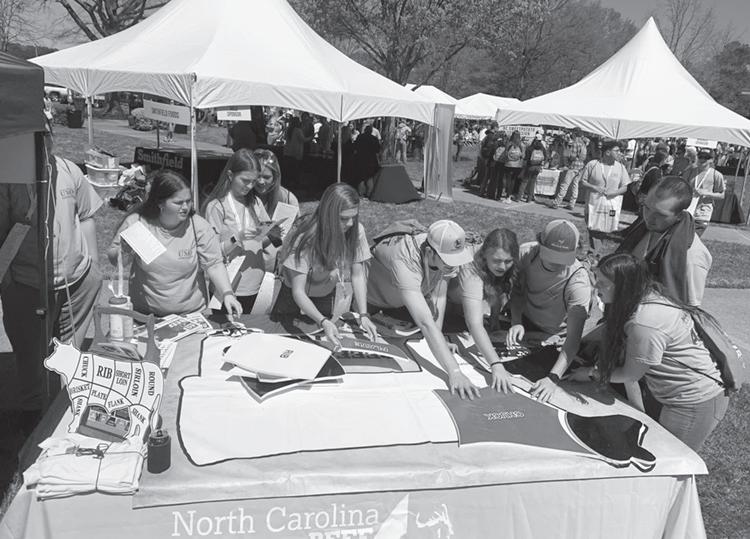
More than 1,800 high school FFA and 4-H members from across North Carolina recently flocked to the University of Mount Olive (UMO) for the eighth AgFest. The event promoted and celebrated awareness of agriculture and other academic opportunities at UMO. Students came from as far east as Pamlico County, as far west as Iredell County, as far north as Alamance County, as far south as Marlboro and Chesterfield, S.C., and all areas in between. The attendees represented 81 different schools.
Buses began rolling onto the Mount Olive campus around 11:00 a.m. After a quick photo of each school in attendance, students had the opportunity to visit nearly 100 different educational booths representing all sectors of agriculture and an array of other educational fields and careers.
As music filled the campus grounds, participants sat on the lawn, enjoyed a bit of line dancing, and competed in some friendly games of corn hole, spike ball, and chicken slinging bingo. Some four legged farm friends proved to be a crowd favorite with lambs from the UMO Kornegay Student Farm and horses from the Wilson County Mounted Search Team - Horseback Heroes and the N.C. Troopers Association Caisson Unit.
High school students had the chance to test their skills in archery, bull riding, log rolling, virtual welding, and on a zeroturn lawnmower course. An afternoon concert featured country music artist Drake White, with opening acts Paige King Johnson, Chandler James, and 2022 National FFA Talent Show Competition Winners Boone and Church.
“This, by far, has been our biggest
and best AgFest to date,” said Dr. Sandy Maddox, Dean of the School of Agriculture and Biological Sciences. “The purpose of this event is to introduce FFA members and advisors to what the University of Mount Olive has to offer academically and to what the agriculture industry has to offer in regards to career opportunities. By all measures we checked every box! It is very rewarding to see so many of our returning Ag educators come back to AgFest year after year and bring their FFA chapters. AgFest is a celebration of not only agriculture, but also of community and connections.”
The University partnered with multiple sponsors, including Food Farm Home of the Original Piggly Wiggly, Got to Be N.C., and Smithfield Foods, as well as other agribusinesses and commodity groups, to allow students to come to campus and enjoy a day of educational and fun activities, eat great food, and enjoy a country music concert at almost no cost.
“Many of these students have never been on a university campus,” said Edward Olive, Director of the Lois G. Agribusiness Center. “Our UMO students in the School of Agriculture and Biological Sciences and other departments across campus enjoyed hosting these high school students and sharing what life is like at UMO. We could not do this without the wonderful sponsors, committed FFA advisors, and volunteers that help us make it possible!”
About the University of Mount Olive. UMO is a private institution rooted in the liberal arts tradition with defining Christian values. The University is sponsored by the Convention of Original Free Will Baptists. For more information, visit www.umo.edu

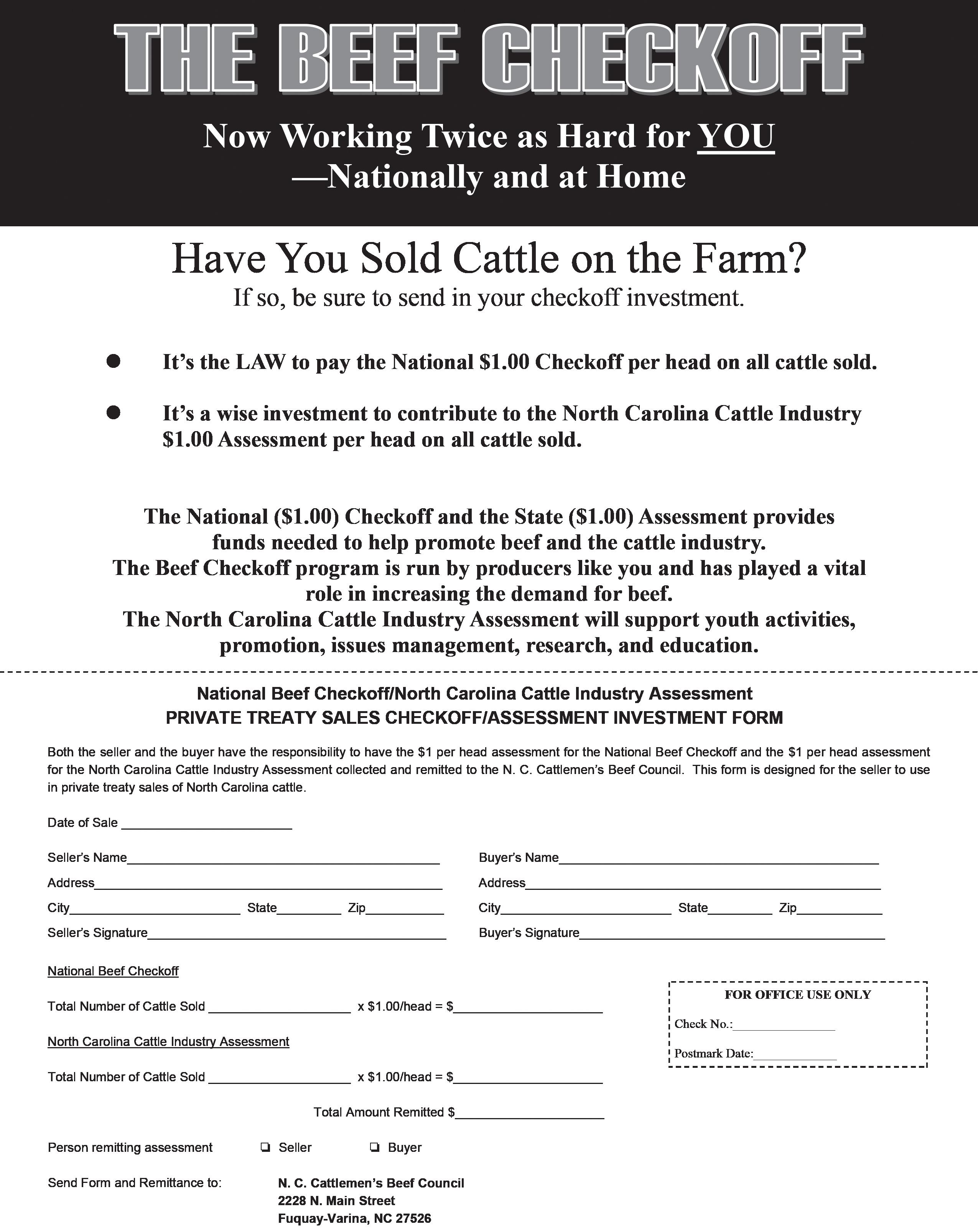
In 2018, N.C. Cooperative Extension Livestock Agents had made plans for annual out-of-state producer agriculture tours until 2024. The 2018 and 2019 tours happened, but unfortunately, the COVID-19 pandemic changed even the best laid plans. In February of 2023, the first of these tours post-pandemic took North Carolina producers through Virginia, West Virginia, and Kentucky to visit several farms and agricultural related businesses.
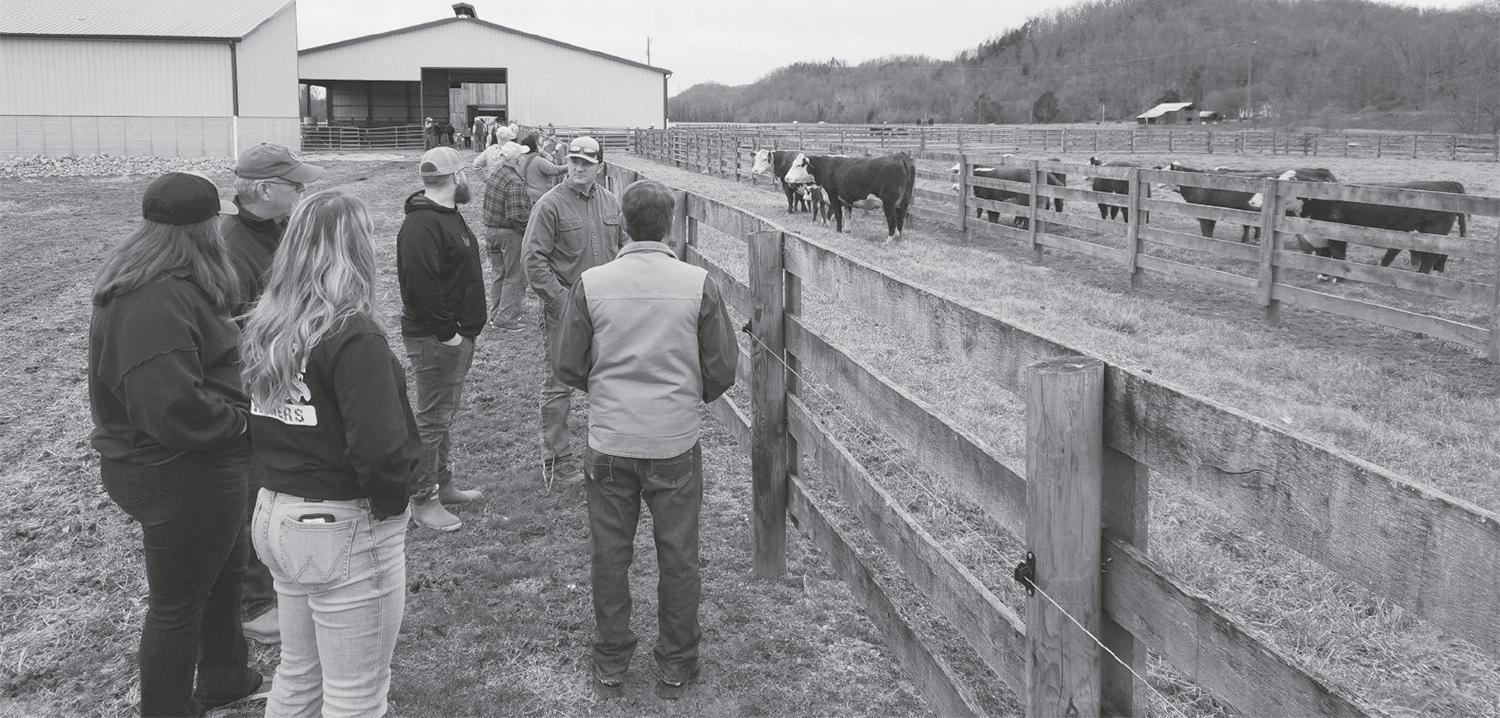

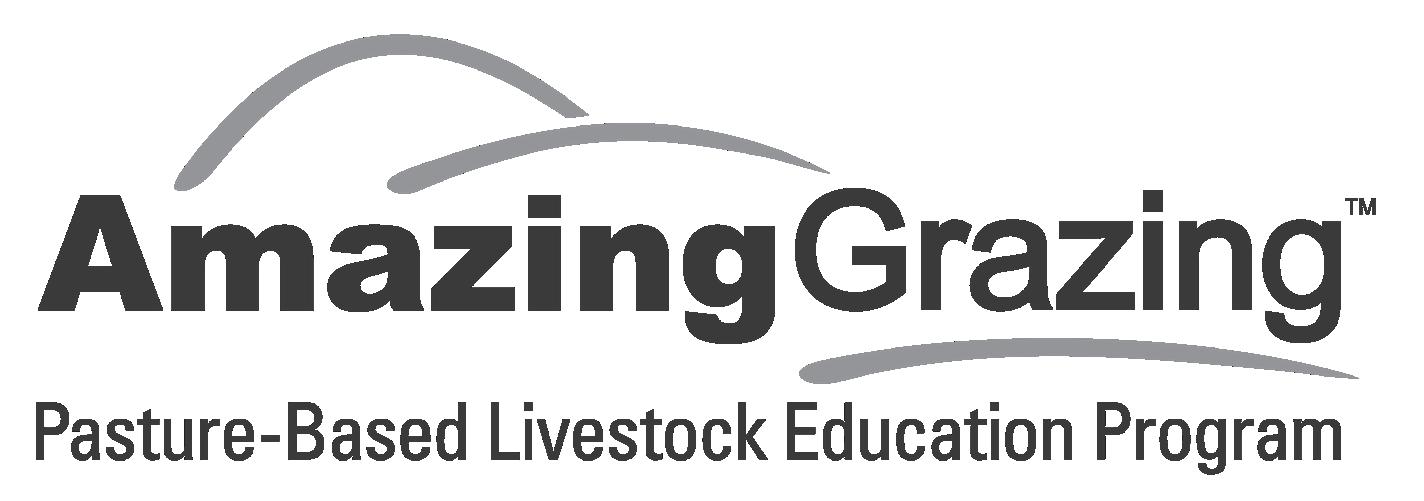
Producer interest was the driving force for this tour’s comeback. Several producers approached them after COVID-19 settled down, requesting another opportunity and promising their support if one was organized. Sara Drake and April Bowman invited Dr. Deidre Harmon and me to join their team, and the planning began with the theme of “Cattle: The Ultimate Upcyclers.”
The tour began at Virginia Produce Company Inc. in Hillsville, Va., which was started and has been operated by the Beamer family since 1955. Virginia Produce Company supplies several major grocery chains, including Harris Teeter and Food Lion, with a variety of produce year round. They source produce from Virginia, surrounding states, and
throughout the southeast, and own and operate several farms in the area as well. Beef cattle producers in the area benefit from Virginia Produce Company’s cull vegetables and sweet corn shucks throughout the year. These byproducts provide economic supplementation for cattle producers, especially during the ‘summer slump’ of forage production and hay feeding. We continued our first day by visiting the Southwest Virginia Bull Test in Wytheville, where we learned about the history of the test and the protocols used. Producers attending discussed the differences between the North Carolina bull tests and the Southwest Virginia test and viewed the bulls on test. The final stop of our first day was Grassy Run Farms in West Virginia, where they raise Hereford cattle that “they are proud to put in the front pasture.” Through selective artificial insemination and embryo transfer, they have built their herd to include high quality donor cows and herd sires. They also host a bull sale annually. We rounded out the evening at our hotel in Georgetown, Kentucky.
Our second day was packed with education and fellowship. We began with a tour of the Kentucky Beef Network’s Eden Shale Farm in Owenton, which
was arguably the most popular stop of the tour. Eden Shale operates as a demonstration farm in collaboration with Dr. Stephen Higgins of the University of Kentucky. Through this collaboration, the team identified common issues in Eden Shale’s day-to-day operations and implemented creative solutions. These solutions are then assessed for feasibility to be used on farms across Kentucky and the Southeast. Practices that participants found particularly intriguing included the large automatic hay feeder, rainwater harvesting, and mud management in pasture and heavy use areas. Evaluations for this tour resoundingly indicated Eden Shale is a preferred stop for future tours.
the production of distiller’s grains but also provided insight into the importance of spirit production to the Kentucky economy.
On Thursday, we began with an extremely rainy drive to the Alltech World Headquarters in Nicholasville, Kentucky. We were welcomed to the headquarters with a brief history of the company, toured the research laboratories and meeting spaces, and briefly viewed the butterfly garden because of the weather. The design and architecture were awe inspiring, with each space being designed to reflect each of the countries that house an Alltech headquarters. Pearse Lyons, founder of Alltech, was an Irish
After lunch on day two, we visited Robert L. Conley Livestock in Georgetown, Kentucky. We visited with Bob, a large order buyer and backgrounder who frequently purchases North Carolina cattle and received numerous pearls of wisdom. This conversation included how to increase the desirability and value of North Carolina cattle to order buyers, as well as a discussion of the agriculture industry overall. Day two was rounded out by a visit to Buffalo Trace Distillery. Kentucky is nationally and internationally recognized for bourbon production, and with this comes plenty of distillers grains, which are an invaluable feedstuff for cattle. Touring Buffalo Trace Distillery not only gave attendees perspective on
native. Much to our surprise, there was an entire space in the building designed as an Irish pub for this reason! We also learned that Alltech owns the Lexington Brewing and Distilling company, whose products are available at this pub during company functions. After a visit to Alltech’s research farm, we headed to Appalachian Abbatoir in Charleston, West Virginia.
Appalachian Abbatoir is a project of Buzz Food Service and was created as a project of the Abandoned Mine Lands Pilot Program by the West Virginia Department of Environmental Protection. Appalachian Abbatoir opened its doors in 2022 as a full service, USDA inspected processor. They also offer USDA grading at no additional cost. The three pillars of their business are animal handling (they

worked with Dr. Temple Grandin while designing their plant), worker safety, and food safety. Animals sourced for Buzz Food Service are primarily from the Appalachian region, which made my Alleghany County heart proud. Particular interest was shown in their involvement in establishing the Mountain State Ground Beef Program. This branded ground beef program uses market mature cows from farmers across West Virginia, meeting requirements, which include
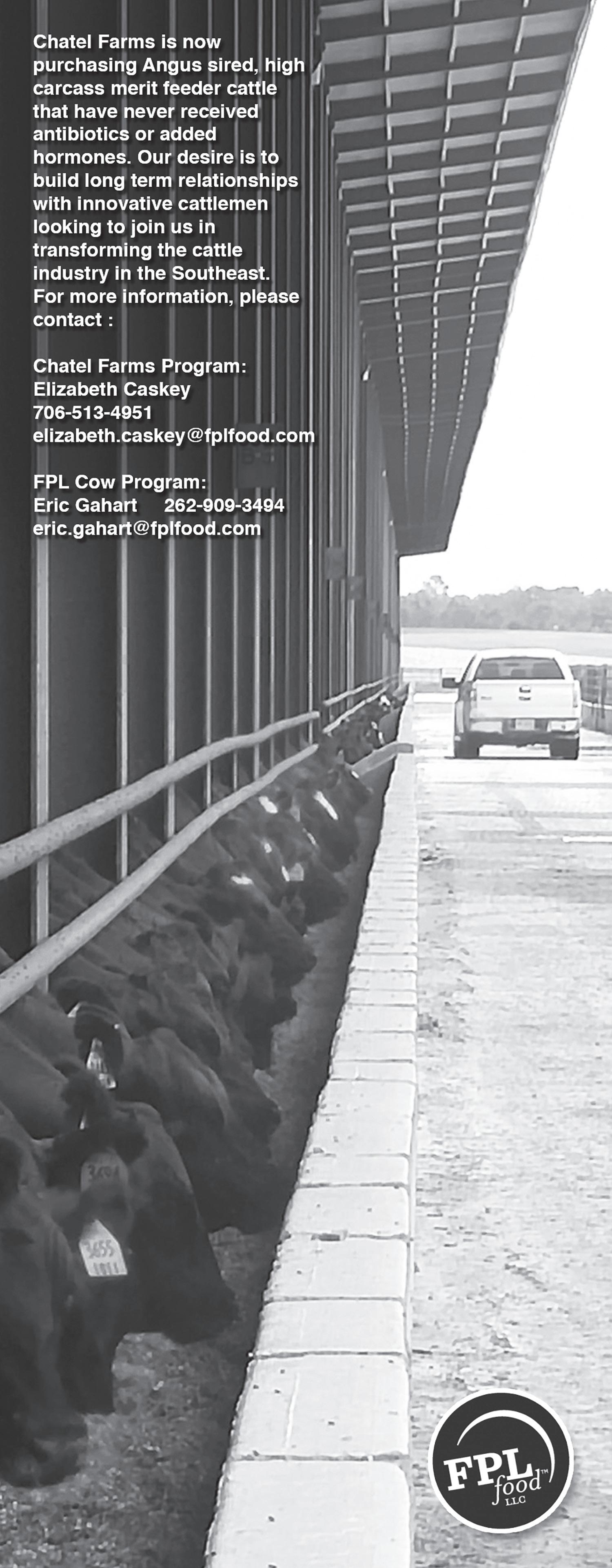

being BQA certified.
We are extremely thankful to all of the sponsors and cooperators that made this tour possible. April, Sara, and I grew in our perspective and knowledge of how North Carolina beef cattle fit into the big picture. We are thankful to the 26 people from 11 North Carolina counties who attended the tour for being great participants! We have already begun discussing a 2024 tour, so stay tuned for more information.
Total Time - 25 minutes
1 beef top round steak, cut ¾ inch thick (about 1 pound)
¼ cup fresh lime juice
2 tablespoons brown sugar
2 tablespoons vegetable oil
1 tablespoon Worcestershire sauce
3 large cloves garlic, crushed Salt and pepper
Combine juice, sugar, oil, Worcestershire, and garlic in a small bowl. Place beef steak and lime mixture in food safe plastic bag; turn steak to coat. Close the bag securely and marinate in the refrigerator for six hours or overnight, turning occasionally.
Remove steak from marinade; discard marinade. Place steak on grid over medium, ash covered coals. Grill, covered, 10-11 minutes (over medium heat on a preheated gas grill, times remain the same) for medium rare (145°F) doneness, turning occasionally. (Do not overcook.)
Cook’s Tip: To broil, place steak on a rack in a broiler pan so the surface of the beef is 2-3 inches from heat.


Broil 12-13 minutes for medium rare (145°F) doneness, turning once. (Do not overcook.)
Carve steak into thin slices. Season with salt and pepper, as desired. Makes 4 servings.

We keep a set of heifers close to Shane’s house at what we call the Old Place Farm. Gemma and Wesley, who is two years old, spend time with them. Gemma will name each one of the heifers. Some of the names are Tubby, Stubby, Tuffy, Star, and Heart. She likes cattle that are colored, which is fine. As long as she is interested, I will support it.
We raised a bull sired by Santa Gertrudis out of a Texas Longhorn cow. He was marked up red and had lots of white patches, which goes back to his
mama – she is white with red specks. We turned him out thinking he might be a bull for breeding heifers. He was thin made and weighed about 60 lbs when he was born. He grew fairly well and had good confirmation to him. He was about two years old when we carried him to the Old Place Farm to breed heifers. Gemma was four years old at this time.

After 90 days of breeding, we took him out. In the time frame of about nine months, the bull had been gone five months. Gemma had given him the name
Due to increased printing costs, the price of the books have increased to $7.00/each this year. We would like to thank Performance Livestock & Feed Company and Carolina Stockyards for again sponsoring this book.
The 2023 version is now available to help cattle producers effectively & efficiently record daily production efforts, which can help enhance profitablity and reduce stress levels. In addition to Beef Quality Assurance (BQA) best practices and proper injection technique information, it has more than 100 pages to record calving activity, herd health, pasture use, cattle inventory, body condition, cattle treatment, A.I. breeding records, and more. It also contains a calendar and notes section.
Simply return the order form below, along with $7.00 for each book to: N.C. Cattlemen’s Association


2228 N. Main Street
Fuquay Varina, NC 27526

You can now order them through our website at www.nccattle.com/resources/merchandise/red-book-order-form. You can also call our office at 919-552-9111 or email us at kim@nccattle.com
Fred while he was at the Old Place Farm. One of the heifers, ½ Gert and ½ Hereford, just had white blotches on her face and red everywhere other than a white underline. Gemma had named her Tuffy. Shane got the word late one evening that it was time for Tuffy to calve. On the way home, he checked on her and thought she needed a little more time to make her nest.
Around 10:00 p.m. that night, he went back to check, and he decided she was going to need some assistance. He got her caught and tied off to the tree. Morgan, Gemma, and Wesley were riding with him in the gator. It was not a hard delivery. Just a few pulls, and Shane had the calf on the ground. You know how new baby calves blow the mucus out of their nose and shake their heads. Gemma was standing there looking at the calf. After a few minutes, she said, “Daddy
that calf’s daddy is Fred.”
You tell me how many five-yearolds can look at a newborn calf and tell who the sire is. Maybe by the time she is of age to start keeping books and records, she will have it all in her head or something other than a laptop. I do know that each crow thinks his baby is the blackest, but I do think that kids today are a lot smarter than we were in the ‘50s. It just amazes me how a five year old can stand there and determine the daddy of a calf. Maybe it’s being raised on a farm that she gets her smarts from. I will say that Gemma and any other kid raised on a farm is privileged. My granddaddy, Ernest Linwood Harris, always made the statement that every youngin needed a kid goat to grow up with. Now that goat can be any animal – lamb, calf, or chicken. Something they can care for and watch mature.
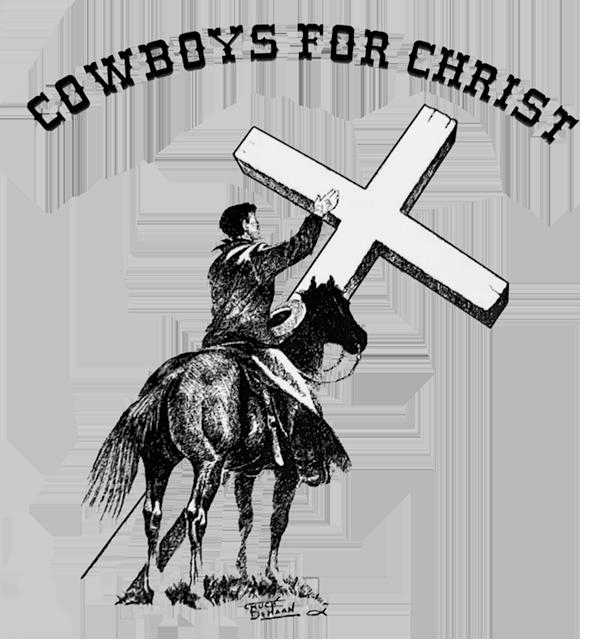
What does it mean when the Bible says we need to be “saved”? Saved from what? If it’s important enough for the New Testament to be built on it from beginning to end, we need to explore its meaning. And what does the Old Testament have to say about it as well? We will explore a glossary look at both the Old and New Testaments to find the answer.
Let’s begin with the New Testament, where we find the Apostle Peter addressing the Jewish religious leaders because they arrested him and the Apostle John for several reasons. They healed a crippled man and began teaching that there is resurrection from the dead. So, let’s read Acts 4:11-12 - “This Jesus is the cornerstone that was rejected by you, the builders, which has become the chief cornerstone. And there is salvation in no one else, for there is no other name under heaven given among men by which we must be saved.”
The end of verse 12 is the word “saved,” which comes from the Greek word “sozo.” It means to save, deliver or protect, heal, preserve, do well, and be made whole.
The Apostle Paul wrote in Ephesians 2:4 - “But God, being rich in mercy, because of the great love with which he loved us, even when we were dead in our trespasses, made us alive together with Christ, by grace you have been saved.”
What this is telling us is that we are saved from being “dead in our trespasses.” The trespasses are how each of us has fallen so short of the magnificent holiness of God. All of us would honestly admit to the fact that we are not perfect people. That means we are sinful.
The Old Testament is equally important to the salvation that is described in the New Testament because Peter quoted Psalm 118:22 when referring to Jesus as the chief cornerstone.
The most famous New Testament verse known all over the world is John 3:16 - “For God so loved the world, that
whoever believes in him should not perish but have eternal life.”
To get a complete overlook of our subject, we should always drop back a verse or two on what we are studying. So, keeping in that fashion, let’s read John 3: 14-15 - “And as Moses lifted up the serpent in the wilderness, so must the Son of Man be lifted up, that whoever believes in him may have eternal life.”
We see starting back a couple of verses we find once again a reference to the Old Testament, all the way back to Moses. Jesus quoted this concerning himself to Nicodemus, who came to Jesus under the cover of darkness.
When Moses held up the serpent back in Numbers 21:8-9, it was a picture of believing in Jesus Christ to rescue us from sin. “And the Lord said to Moses, make a fiery serpent and set it on a pole, and everyone who is bitten, when he sees it, shall live. So Moses made a bronze serpent and set it on a pole. And if a serpent bit anyone, he should look at the bronze serpent and live.”
We are justified, forgiven, and adopted into God’s family by believing in Christ, as John stated in John 1:12. But to all who believed in him and accepted him, he gave the right to become children of God.
The idea concerning the death, burial, and resurrection of Jesus Christ did not start in the New Testament. Our Heavenly Father had a plan of redemption for us. It is a “buyback plan” with eternal consequences. It cost Him everything (His one and only Son) by providing Jesus as the substitutionary sacrifice for the payment of my sin and yours.

Now this next passage says it all about our lost condition without Christ. Romans 5:6-11 - “For while we were still weak, at the right time Christ died for the ungodly. For one will scarcely die for a righteous person - though perhaps for a good person one would dare even to die - but God shows his love for us in that while we were still sinners, Christ died for us. Since, therefore, we have now been
justified by his blood, much more shall we be saved by him from the wrath of God. For if while we were enemies we were reconciled to God by the death of his Son, much more, now that we are reconciled, shall we be saved by his life. More than that, we also rejoice in God through our Lord Jesus Christ, through whom we have now received reconciliation.”
Starting with the realization that we each need a personal Savior is just the first step in our walk with Christ. This is what John 10:9 says. “I am the door. If anyone enters by me, he will be saved and go in and out and find pasture.” This is Jesus talking about himself. He is the door to salvation. Have you walked through that door? Have you trusted in Christ for a right standing with a Holy
God? If you have, it will enable you to go in and out and find pasture (peace and safety). That pasture will have just the right grass (guidance and strength) you need for a meaningful life through the mountains and valleys of life.
If you have not believed in Christ, you can pray this or something similar from your heart.
“Dear God, I have sinned against You. Please forgive me for my sins and cleanse me. I believe Jesus is Lord, and He is risen from the dead. Help me to walk away from my sin, and please walk with me. Help me be what You want me to be. Thank you in Jesus’s Name.”
All scripture is taken from the English Standard Version (ESV)
Most of the breed associations in North and South Carolina have stepped forward and renewed their contracts for Spotlight sections in The Carolina Cattle Connection for 2023. If your breed is not featured as a Spotlight section and you would like to inquire on any open months please feel free to contact me. Below is the tentative schedule for the upcoming year.
Utilize weaning time as an opportunity to cash in on current salvage value by identifying problems in the cow herd. In the southeast, many herds are now preparing for weaning or will be coming up in early fall. Weaning fences and corrals are being “beefed” up to get ready for the big event. Many will send calves straight to the stockyard, while others will do a 45 -60 day post weaning preconditioning program. Producers who do a preconditioning program are often rewarded for a little extra work, but when you do, make sure your facilities will hold them. Regardless of how you choose to wean and market your calves, one more management step should be the same for all cattlemen. Weaning is the perfect time to evaluate the cow herd for next year’s potential production. The slaughter
market is at an all time high, and there hasn’t been a better time to consider a few management options outlined here that should add money to your operation in the short term and long term!
Calving and weaning are two great times to evaluate your cow herd, but in my opinion, weaning time is the best as you can evaluate her calf’s performance and mama while everything is in the catch pen. All cows should have a calf at side, but if not, it’s time to market nonproductive animals. Let me warn you, it’s easy to make excuses here as to why a cow did not wean a calf or is open, and I’ve seen it done for a lot of years only to be a problem down the road again!
It’s your money you are wasting, so the choice is yours. If she did not bring a weaned calf home, she needs to leave.
Given that, now is a great moment in the production cycle to look the cows over closely for additional problems that may be present or arise soon, costing unnecessary expense to the operation. Some of the big things I recommend looking at now are disposition, feet, eyes, udder, and performance of the cows’ calves (lifetime production). Addressing these problem cows now will enhance future production and profitability as well as free up grazing for the summer if needed.
As the calves are pulled from the cows, take just a few extra steps and run all cows in the herd through the chute. Evaluate body condition of cows currently. If some are thin and pulled down from winter, check some physical traits to see if that is the problem.
Some cows may be thinner at weaning, and it can be due to their age and teeth condition. Mouth the cattle at this time to see if the teeth are smoothing out close to the gum line. This is not necessarily stress free for you, but it is fast to look in her mouth and assess the situation. Cows that are smoothed mouth are getting old and need to be shipped because they will only continue to be hard doing during tough grazing conditions. Let me emphasize, however, that some thinner cows may be the result of being younger or just having higher milk production and weaning a heavy calf. Don’t confuse the two, as there can be cattle in good condition that weaned a below average calf that need to be culled. Always look at the production levels of the cow first and then look at age, feet, etc., moving forward. Just because a cow looks good, does not make her good! Heavy weaning weights pay the bills, not fat, slick, pretty cows, which most likely aren’t giving ample milk.
Also, remember to ship the cows you noticed at calving who had bad udders. For example, did you have to milk her at calving, are all teats functional and problem free? If not, let her go because keeping her leads to more labor and aggravation. When you notice problems with the udder at calving, mark her down as she will get worse. Pendulous udders, where the suspensory ligament has broken down, are indicative that the cow is nearing the end of her productive life. Cows with large/balloon teats at calving get worse with age. Also, a quick and profitable management step is to check the eyes on the cows. Check for the presence of abnormalities. Small ulcers, wart like growth on the eyeball, horn shaped growth on eyelids, and small ulcers on the lid can all be the start of precancerous growths that can cause real problems fast and should be addressed at
this time. Any of these problems indicate that the cow needs to be shipped soon. Some of these conditions can be treated by a large animal veterinarian, and a consult may be necessary to determine the longevity of the animal. Every producer should have a good working relationship with their local large animal veterinarian.
In addition, while in the chute, check her feet. Are the toes growing long? Do they curl? Are there corns between the toes? If this is noted, cull these animals now. Many will try and trim the feet, but they will grow back. Even worse is that this trait is genetic if keeping their heifers. Bad footed cattle need to be eliminated from the herd regardless. The inability to walk long distances for grazing and water is paramount to production. Therefore the cow should be able to travel with ease. If she is in pain from foot problems, she will not get out and graze like she should and will only lose weight, which you can avoid by sending her to the market. Again, slaughter cow prices have never been better, so don’t hesitate to let her go.
While in the chute, take the opportunity to pregnancy test the breeding herd. Check all cows and heifers exposed to the bulls and palpate to determine pregnancy status. Any open females should be culled! The margin of return in the beef business is too narrow to allow a cow to freeload for another year, especially at the current cost of fertilizer, feed, etc. Either her calf or the cow must pay the feed bill. Replace her with a good open or young bred female that can calve at the beginning of your calving cycle. If you sell all your calves at weaning, consider buying your replacement females off the farm from a good reputable herd.
The last thing that I will mention is probably the most obvious. What did my cows produce on an individual basis? Most producers have scales or access to scales to weigh their calves at weaning. With these calf weights in hand, you need to determine which cows did a good job of weaning a calf that pays the bills and which are freeloading. If you have cows that produce calves that are significantly below average annually, it is time to replace her. Most producers, on average, will cull around 15-20 percent of the herd each year nationally.
To improve your cow herd’s performance, it is a must to continually apply pressure so you can identify cows that are making money and not freeloading. If you need help recognizing or evaluating these traits mentioned in the article, I encourage you to contact your Area Livestock Extension Agent or University Beef Specialist for more information or help. Here’s to a profitable year!
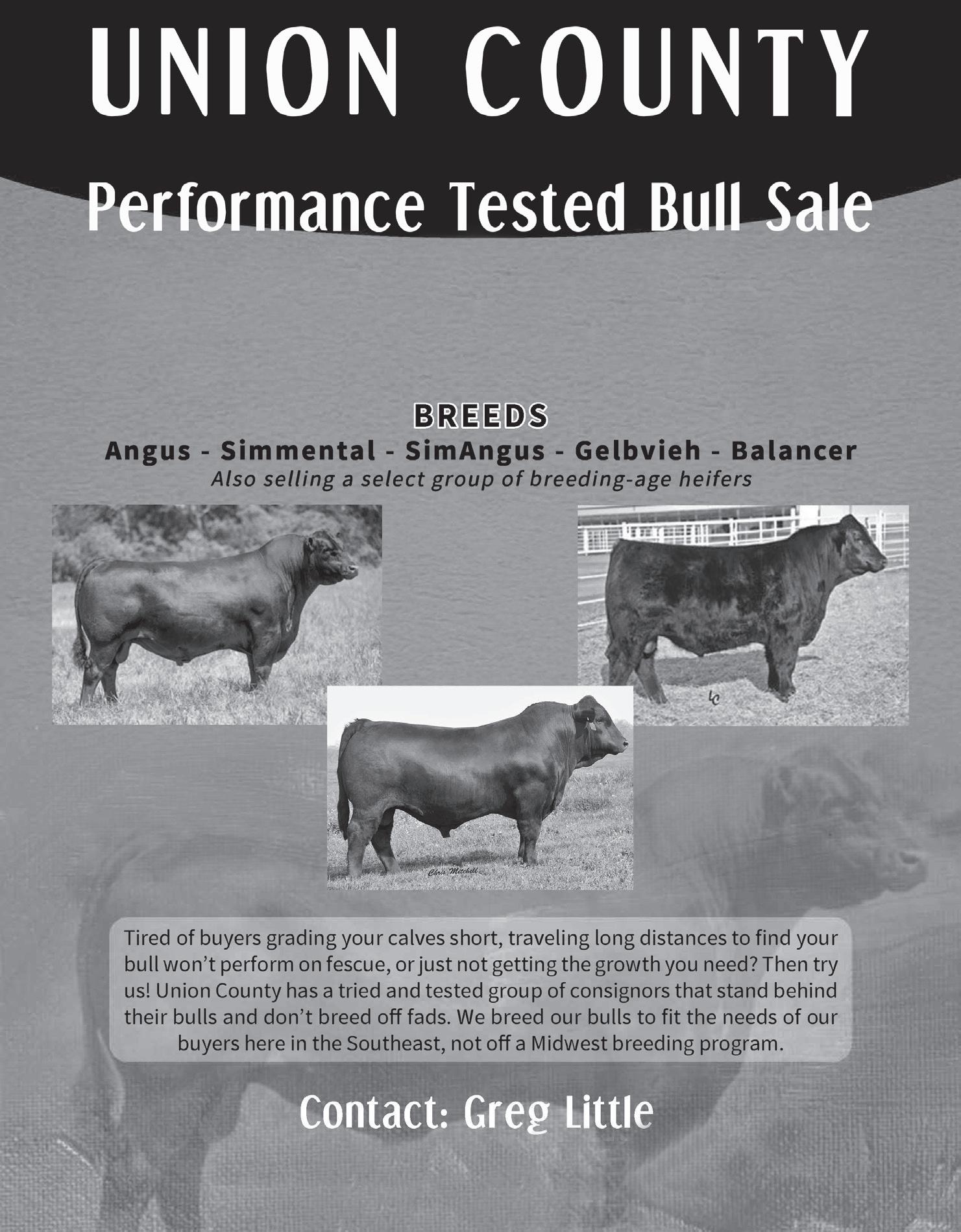










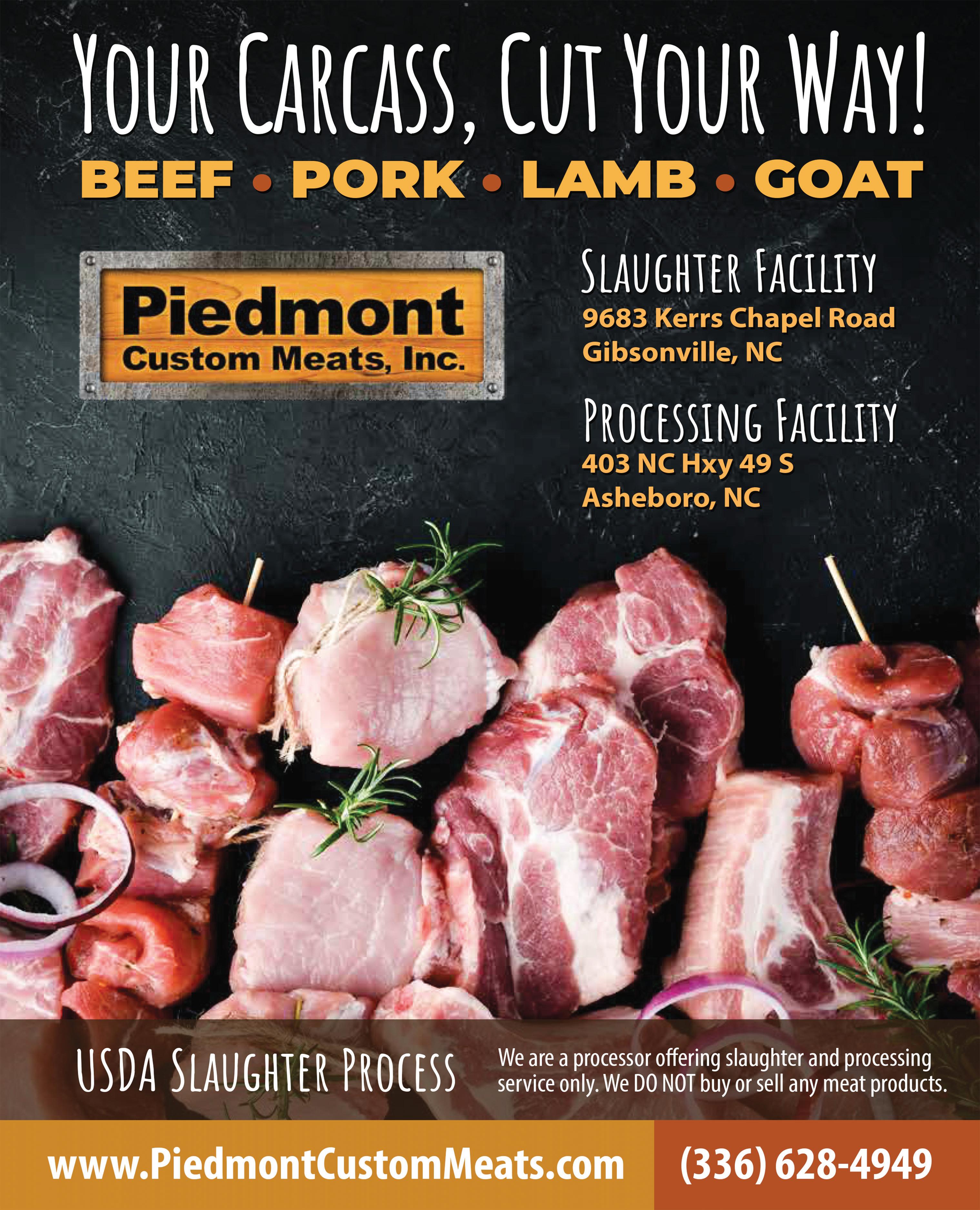

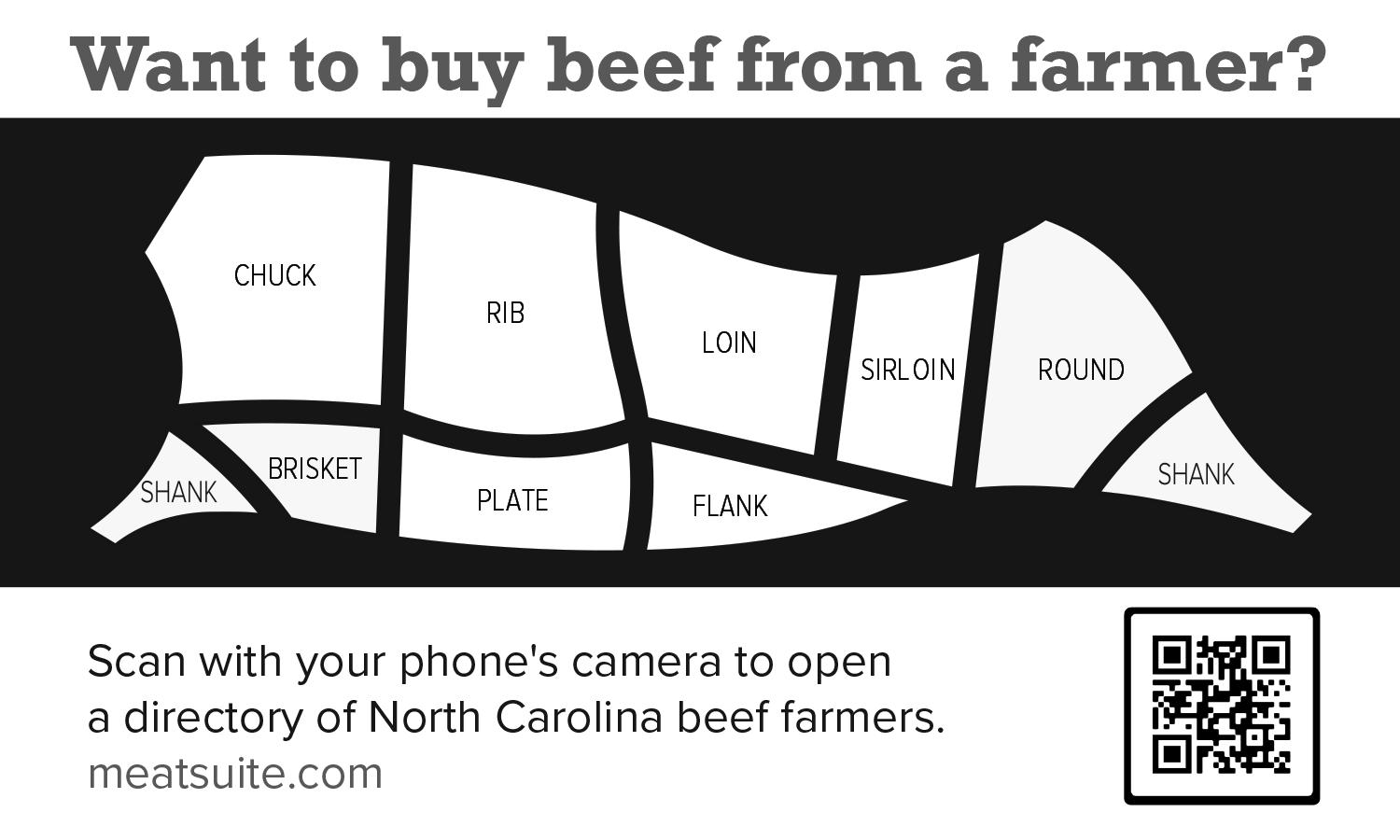
In the Southeast, most forage systems are based on perennial grasses, such as tall fescue and bermudagrass. Annual summer forages are high quality, fast growing forages that can supplement forage production and improve the quality to support animal performance. They can be planted in the spring when the soil temperature reaches 65°F (4 inch soil depth) through July and can be managed under grazing or baleage production. These forages are good options to support higher nutritional requirements of diets for replacement heifers and stockers, for example. These forages can also help fill the gap in forage production when tall fescue stands are dormant or when unforeseeable weather conditions drastically impact forage production. Generally, they can accumulate high forage mass quickly and be ready for grazing in 45-60 days.
when drought or frost events occur. When a killing frost is broadcasted, livestock should be removed for up to two weeks from areas containing forages with the potential to accumulate prussic acid. Sugarcane aphids can occur in sorghum and sorghum-sudangrass plants, and controlling insects when needed is critical to avoid yield and quality losses.


meet higher nutritional requirements of livestock categories and allow for some flexibility in grazing sources within a forage-livestock system. Always rely on measuring forage mass on paddocks to adjust the stocking rate and fine tune your rotation plan. A pasture ruler or

grazing stick (Figure 3) is recommended to determine forage height and estimate grazeable forage mass. Contact your local Extension agent for help identifying the best forage species and management practices to be implemented in your operation.
Several forage species and varieties of warm season annual forages are adapted to the region. The most used grasses are crabgrass, pearl millet, sorghum, sorghum-sudangrass, and for legumes, cowpea, and sunn hemp. Crabgrass is productive, with crude protein around 15%, and can be managed for reseeding at the end of the season. This practice helps to reduce the cost of establishment in the following year. Pearl millet is high yielding with a crude protein concentration of around 14% and has higher drought tolerance than sorghum/sorghum-sudangrass.
Sorghum and sorghum-sudangrass are high yieldings with about 16% crude protein. They require proper grazing management to avoid issues with prussic acid poisoning or nitrate toxicity, mainly
Incorporating legumes into grass based stands helps add organic nitrogen to the system, improving forage quality and soil fertility. Both cowpea and sunn hemp are viable options for mixtures with annual summer grasses (e.g., pearl millet). Adjusting seeding rates and management practices when using forage mixtures is crucial. These legumes tolerate grazing and should be managed under rotational management to allow proper resting time for plants to recover and regrow. Sunn hemp can tolerate drought, and grazing should start around 45 days after planting, when plants are around one to three feet tall. For mixtures containing cowpea, it is vital to use proper stubble height to avoid damage to the meristem allowing the plants to regrowth after each grazing event. Incorporating summer annuals into a forage system can help
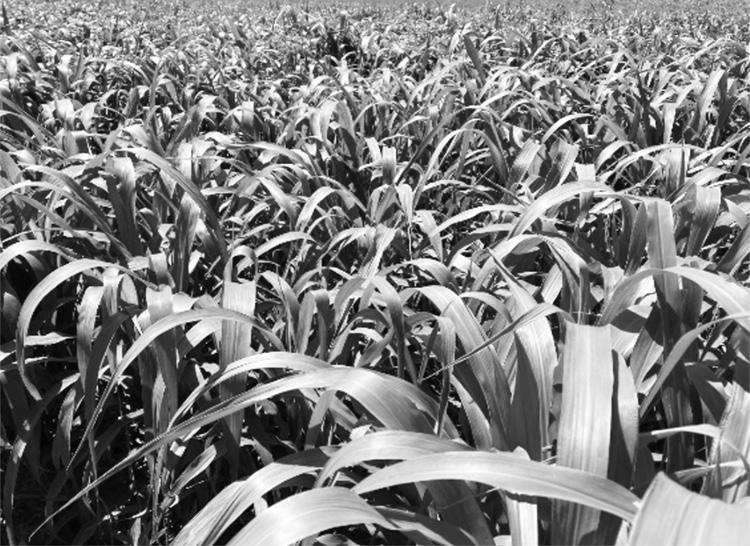

Artificial insemination (A.I.) gives producers access to high powered genetics for their operation’s goals. Let’s look at the supplies you’ll need and best practices for the most success.
If you’re interested in beginning an A.I. program in your herd, I suggest first speaking with your veterinarian to help identify a Bovine Artificial Insemination Training Course that would be right for you or to connect with a trained specialist. When considering sire selection, I recommend that producers speak with their herd health veterinarian about the following:
• Goals for your calf crop
• Desired expected progeny differences (EPDs), detailing anything from calving ease to carcass traits, maternal traits, and more
• Which animals they plan to A.I., whether just heifers or both cows and heifers
• Considerations for a clean up bull
Proper insemination technique and the selection of synchronization protocols are really important. Another important factor is nutrition. Make sure to keep the heifers in a good state of nutrition
– a poor plane of nutrition can affect her fertility. The heifers and cows need to be in a positive energy balance and gaining weight – or at a very minimum, maintaining weight. Receiving high protein levels and an excellent trace mineral program will also increase chances for success.
Supplies Needed to Build a Basic Insemination Kit
• Stainless steel A.I. gun
• Straw cutter or scissors
• Non-spermicidal lubricant
• Thermometer
• Thaw unit (water bath or wide mouth thaw thermos)
• Disposable items, including split plastic sheaths, sanitary covers, plastic palpation gloves, and paper
• Hemostats (for use instead of tweezers)
• Disposable sheath protector tubes to minimize contamination
Be sure to clean and disinfect the items in the A.I. kit both before and after use. Clean the items with warm water and soap to make sure all residue is rinsed off. Then, disinfect using Chlorohexidine. Beware that disinfectants can be
spermicidal, so producers should rinse well so they don’t affect the fertility of the semen sample.
Producers may also want to consider their options for timed A.I. or heat detection, of which there are many options on the market today.
Best Practices for Handling the Storage Tank, Thawing Straws, and Proper A.I. Technique
Handling the storage tank
• Frozen semen should be kept in a liquid nitrogen tank. The storage tanks have a handle with a cup; that’s where the semen straws are kept. Always ensure skin never comes in direct contact with the inside of the tank or contents within it. Use an oven glove or an insulated leather glove, and use either a hemostat or tweezers, to pick up the straws to avoid direct contact with skin.
• Be as quick as possible. Having good organization will help producers avoid keeping the tank open too long (risking damage to the sperm). A good way to avoid this issue is by knowing their inventory and having different compartments for the different bulls.
• Maintain a proper temperature in the tank, which is -184ºF. Also, maintain 3” of liquid nitrogen on the bottom of the tank. The best way to monitor the level of liquid nitrogen is by using a wooden yardstick. If the tank ever loses its seal, producers will notice some frost. This will indicate it’s not maintaining the proper temperature inside, and if the semen doesn’t stay at that perfect temperature, it will lose fertility.
Thawing the straws
• Improperly thawing the semen will
“As president of the Duplin County Cattlemen’s Association and a fellow cattleman, I encourage you to take five minutes of your time to speak with Donna Byrum. She introduced me to a program that I knew nothing about, and within six months she was on my doorstep with a check. The PRF program has been a blessing amid the changing climate and different extremes that all our farming operations have experienced.”
 ~ Joey Carter
~ Joey Carter
DONNA BYRUM
First Choice Insurance
252-792-1189 • fcipllc@gmail.com
For all your crop insurance needs!
Visit us online at cattleandhay.com
decrease the fertility of the sperm. Warm water thawing is the industry standard, and cattlemen can do that by using either a commercial thawing unit, like a water bath, or an insulated thermos.
• The industry standard temperature is 90-95ºF water; thaw the straw for 40 seconds. Use a thermometer and a timer. Different semen suppliers may have different recommendations for thawing; follow their recommendations.
• Thaw straws individually. Cows need to be inseminated within 15 minutes of thawing. A best practice is to thaw a straw after the cow is caught, then inseminate her.
• After thawing, don’t allow the straws to cool off at all. Keep the straw in a shirt pocket to stay at that core body temperature. If the sperm are cold shocked, it will affect sperm motility or even kill them. Also, keep in mind U.V. sunlight is harmful, too.
Pointers on proper A.I. technique
• Sanitation is significantly important during insemination to avoid carrying any bacteria into the uterus, which could cause infection. Using paper towels, wipe off any feces near the lips of the vulva and inside the visible vaginal wall before inseminating. Avoid using any disinfectants; those can be spermicidal.
• During insemination, the easiest way to minimize contamination and advance the straw is with some help from the producer’s arm that is in rectally. Put some downward pressure on that arm to spread apart the lips of the vulva. When inserting the straw, go at an upward angle of about 30ºF.
• When advancing the straw and there is any resistance, using the hand that’s in rectally, take the cervix and push it forward to straighten out the vagina.
• Getting the straw through the cervix can take some practice, but there are some ways to make it easier. It’s common to experience some difficulty here because there is a pouch all the way around the cervix called the fornix; it’s easy to get stuck in this blind pouch. When advancing the straw, make sure to be in the middle of the cervix. And rather than pushing the straw through the cervix, hold the straw firmly, and then with the hand that is rectal, grasp the cervix and pull the cervix over the straw.
• The last point is to avoid going too deep into the uterus. If the straw gets into one of the horns of the uterus, instead of staying in the body, there is risk of unsuccessfully inseminating that cow because they ovulate from only one side. So, if she is inseminated from the wrong side by accident, the sperm simply will not get to the right side in which she is ovulating.

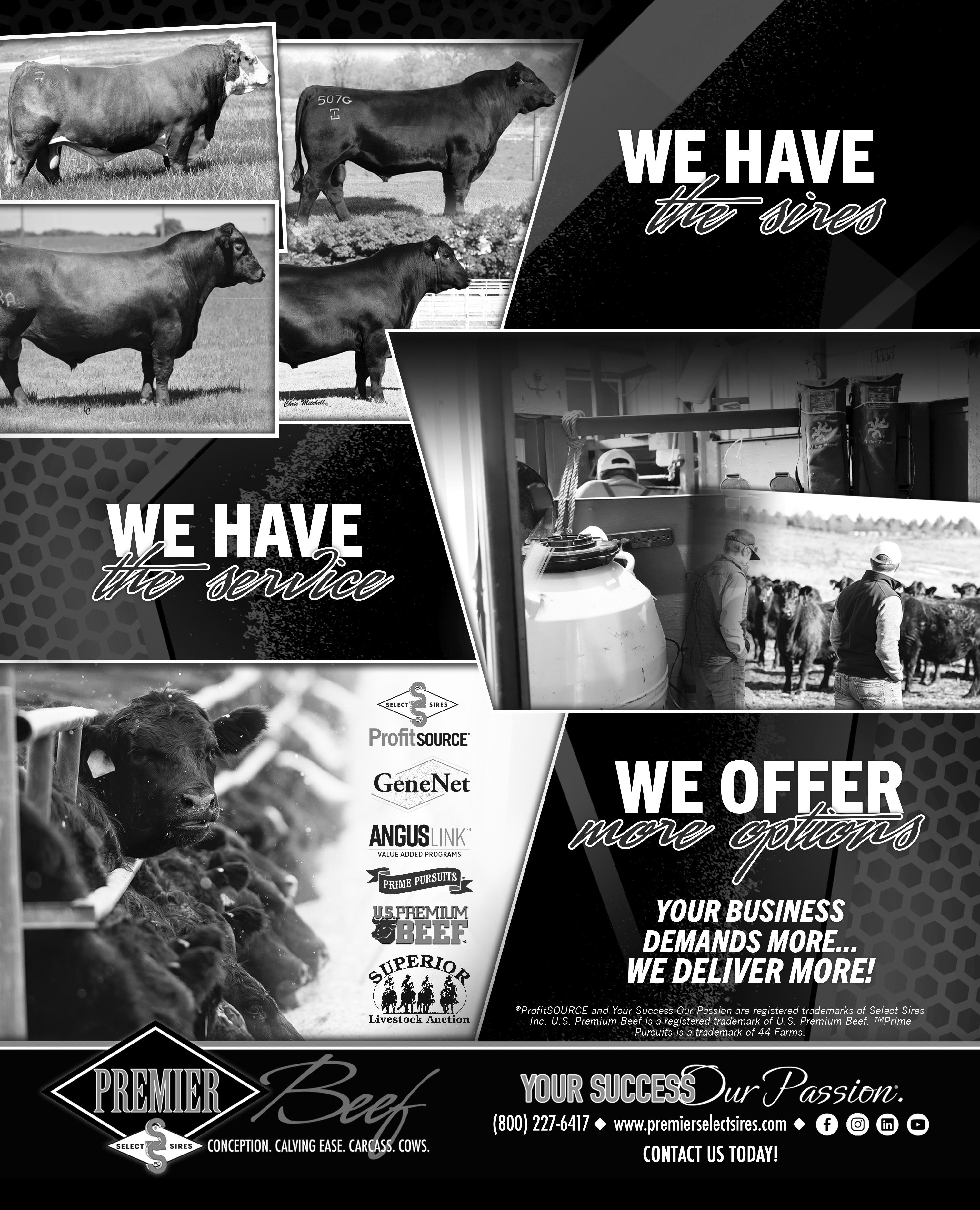

Many methods of increasing the profitability of beef occur on the management and husbandry side of the cattle industry. However, one incredibly important area with huge potential to benefit both beef consumers and producers is the development and popularization of new cuts of beef 1 The invention of new beef cuts out of primals that are normally used for cheap roasts and hamburger will allow for the overall value of a beef carcass to increase3. Over the past 10-15 years, meat research has been focused on trying to identify muscles that could produce more profitable cuts3. When looking at a carcass
breakdown, 33 percent of a beef carcass consists of low value bone and fat, up to 25 percent consists of meat that will be ground into hamburger, and only 10-12 percent of the carcass goes to high value steaks3. Based on these numbers and the fact that anything that is run through a grinder will lose value, any advancements to market beef as valuable whole cuts will significantly impact the value of the carcass2. While these new cuts have been out on the market for some time, the impacts of COVID-19 have caused a rise in popularity. Due to shortages during the pandemic, traditional cuts of beef would often sell out, forcing consumers to
consider buying new and unfamiliar cuts3. The increased popularity of innovative cuts would benefit consumers during a time when meat prices are on the rise because these more unfamiliar cuts are often more affordable than traditional, popularly bought cuts.


Many of the innovative beef cuts that are growing in popularity were identified through a muscle profiling research study at the University of Nebraska and the University of Florida1 This study looked at over 5,600 muscles in the beef carcass, evaluating them for their tenderness and juiciness. The new cuts identified in this study resulted in an increased value of market cattle by $50-70 per head1. The initial need for
investigation of new meat cuts came from a 20 percent consumer decline in buying chuck and round roasts in 1980. The chuck and round are two primals from the beef carcass that make up the shoulder and hind leg and are considered major muscles of locomotion (Figure 1). Therefore, they are traditionally viewed as tougher cuts that are not good for hotfast cooking, such as with steaks on a grill. Traditionally these cuts were sold as large roasts that could be cooked under low heat and for a long period of time. Recent trends in consumers have made these cuts less appealing, as consumers now value more convenient meals and smaller portion sizes due to smaller family sizes 4 . The chuck and round


primal cuts make up 73 percent of the beef carcass weight, so the decrease in demand for these cuts had the potential to decrease the value of carcasses and live cattle significantly4. Thankfully, the results from the research at the University of Nebraska and the University of Florida resulted in discovering valuable cuts out of the chuck and round. Beef processors today will fabricate the chuck and round primals very differently than they did prior to this study.
steak, a retail cut out of
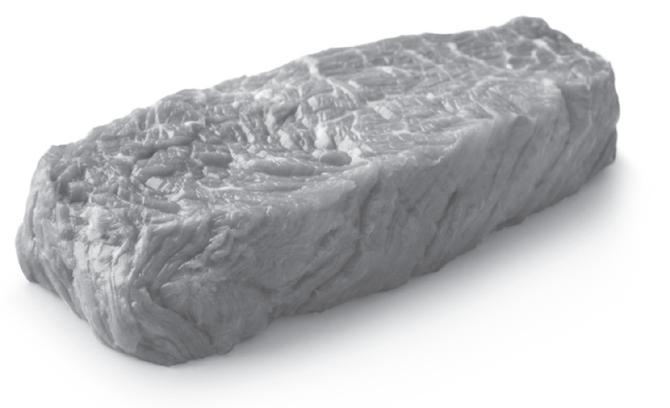
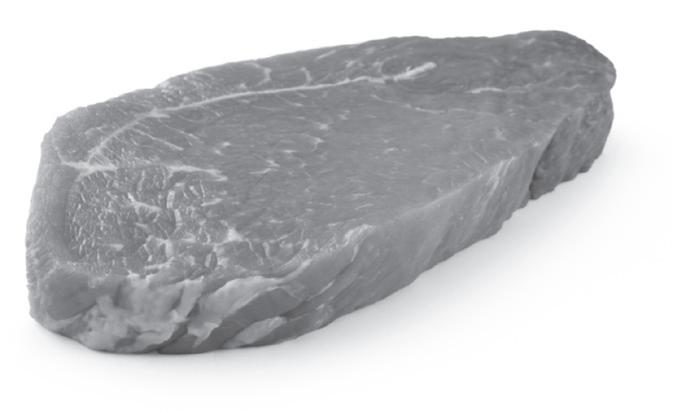
The greatest success story from this research study is the discovery of the flat iron steak, a cut of beef identified out of the chuck primal (Figure 2). The flat iron steak is the second most tender cut of meat from a beef carcass, with only the tenderloin being more tender than this cut4. This may seem incredibly surprising because it originates from a primal (the chuck) that was often considered to be one of the toughest cuts from a beef carcass. Not only is the flat iron steak incredibly tender, but it is also valued for its high marbling and strong flavors. Prior to this study, this muscle was often ground into hamburger because it is located deep within the chuck primal. Now that it has been identified as being flavorful and tender, the flat iron steak is the fifth highest selling steak in the nation4. While the flat iron steak is one of the most successful innovative beef cuts, there are still some difficulties associated with fabricating this cut. Not only is the flat iron steak located deep within the shoulder, which requires more labor when cutting up a carcass, but there is a strip of connective tissue that runs right through this muscle. The muscle that makes up the flat iron steak needs to be fileted open when processing in order to cut out the tough connective tissue4 This is one downside to this innovative cut, as it takes a skilled butcher to seam out this steak, and it took researchers in Nebraska and Florida years to develop ways that processors could efficiently cut it out. Even with the extra labor costs of seaming out the flat iron, it is still more affordable than cuts such as the tenderloin. It rivals the tenderloin in terms of tenderness, flavor, and an enjoyable eating experience.
Two other cuts identified from the Nebraska and Florida study include the Denver steak (Figure 3) and the ranch steak (Figure 4). The Denver steak also comes from the chuck primal and is also considered to be tender and moderately well marbled. The ranch steak originates from the chuck but is considered a very lean cut that is still good for grilling. The Sierra steak is another new cut that is very similar to flank steaks and is valued around the same amount. However, it is also from the chuck (and is actually nicknamed the chuck flank steak) 2 The chuck isn’t the only primal being processed differently to maximize its value. The sirloin primal used to be cut up in a way to make whole sirloin steaks, but research has shown that the fibers within the different muscles that make up the sirloin run in different directions. Now processors are utilizing the sirloin in a more innovative way by taking the different muscles apart and creating steaks out of each separate muscle in the sirloin2
you can either have steaks cut out of the chuck, such as flat iron steaks or Denver steaks, or you can keep the chuck intact as a roast. However, if consumers who have their own animals processed are not educated about the different cuts and what cuts they desire, they may be disappointed or confused about why an animal is processed a certain way.
The success of marketing new cuts seamed out of traditionally low valued primals leaves the beef industry optimistic that there are more innovative cuts to be found. Even if beef has been consumed for thousands of years, with the meat research and technology we have today, there is promise in inventing new ways to fabricate beef carcasses. By pursuing the discovery of flavorful and tender muscles out of low valued primals, the industry will continue to add value to beef carcasses.
References
1 Calkins, C. (n.d.). New Beef Products Research. UNL Beef. Retrieved
March 3, 2022, from beef.unl.edu
2Ledbetter, K. (2020, October 8). Retail beef market embraces changes, new cuts. AgriLife Today. Retrieved March 3, 2022, from agrilifetoday.tamu. edu


3Radke, A. (2020, October 13). New beef cuts are a win-win for producers & consumers. Beef Magazine. Retrieved March 3, 2022, from www.beefmagazine. com
4Researchers say new steak’s a hit with consumers. University of Florida News. (n.d.). Retrieved March 3, 2022, from news.ufl.edu

5Innovative beef cuts. Beef. (n.d.). Retrieved March 3, 2022, from www. beefitswhatsfordinner.com
Have You Herd articles written as a portion of the ANS 402 Beef Management course requirement at N.C. State University Department of Animal Science. The opinions of Maddie Kuwada are not necessarily those of N.C. State University or Dr. Carrie Pickworth.
The discovery of flavorful and tender cuts such as the flat iron steak, Denver steak, and Sierra steak have suggested that there is promise for discovering more valuable cuts out of primals such as the chuck. Further research to identify new cuts out of traditionally lower value primals will not only increase profit for the beef industry but also decrease prices for the consumer. One aspect to consider when thinking about innovative new cuts, especially for those who raise their own beef and have their own animals processed, is that processing primals differently will require consumers to decide which cuts they want 2. For example, when cutting up a carcass,
You Decide: Where’s The Job Market Headed? Jobs are a crucial part – some would say “the” crucial part — of the economy. People take jobs to earn money. They spend the money on products and services to support their living. Businesses create jobs to make the products and services people buy.
One important feature of the job market is that it never stands still. As the economy changes and the products and services people buy change, so, too, do jobs. Jobs that exist today may not be around tomorrow. At the same time, jobs that don’t exist today could be part of tomorrow’s economy.
Developments in technology are a key reason why jobs are both created and destroyed. A good example is farming. When tractors replaced mules used for plowing, the number of acres a farmer could cultivate soared. As a result, farm jobs declined, but jobs in manufacturing tractors rose.
In the 21st century, there have been big advances in technology, such as computers, cell phones, and data storage. Consequently, there have been ongoing changes in jobs.
About a decade ago, two British economists predicted almost half of the jobs would be gone by midcentury. This conclusion came after a detailed analysis of how emerging technology would change the nature of jobs, allowing technologies like digital programs and robots to handle more tasks.
With the economy changing so rapidly — especially after the pandemic — can we still use predictions made even a few years earlier? Indeed, robots are becoming more capable, and a new technology, artificial intelligence, is just starting to be used.
Fortunately, last year the federal Bureau of Labor Statistics (BLS) released a new analysis of how jobs might change in the future — especially which jobs are expected to decline significantly. Before examining the new forecasts, let me review how much the job market has changed in just the last decade. BLS calculates that between 1999 and 2018, 15 percent of all occupations experienced job declines of 25 percent or more.
Looking ahead to the decade of 2019 to 2029, BLS expects several occupations
to lose jobs. Included are housekeepers, tax preparers, reporters, cashiers, customer service reps, travel agents, and computer programmers.
Interestingly, these are occupations with different salary levels. So, what do they have in common?
Most are occupations where the tasks now done by humans can likely be accomplished in the future by technology. Much of housekeepers’ work can be — and already is in some cases — performed by robots. Tax forms can now be prepared by online computer programs. In supermarkets, cashiers are being replaced by scanners. Customer service reps, travel agents, and even reporters, while still including “real” people, are having more of their work provided by online websites.
But – you might ask – why are computer programming jobs projected to decline? Aren’t STEM (science, technology, engineering, and math) professions expected to be fast growing?
In general, more STEM jobs are projected to be added through the end of the decade. BLS estimates STEM occupations will increase by 8 percent from 2019 to 2029. Computer aided software and artificial intelligence technology are forecast to replace many computer programmers.
Overall, total jobs are expected to increase by 4 percent for the ten years from 2019 to 2029. Notice that the starting year of 2019 is prior to the pandemic, so some of this increase reflects the rebound in jobs after the COVID-19 recession of 2020.
Which occupations will have the largest increases this decade? At the top of the list are nurses, renewable energy technicians, cooks, statistical and data scientists, and physical therapists. A look at this list reveals two driving forces: our aging population (nurses and physical therapists) and technology (renewable energy technicians and statistical and data scientists). Cooks are among the top categories probably because people are eating out more frequently, and we like good meals. All of these categories are expected to have job growth rates at least five times faster than the increase in total jobs.
Although they are not among the expected fastest growing occupations, it is important to mention another occupational
category: the “skilled trades” like carpenters, electricians, plumbers, and bricklayers. Many of the tasks performed by skilled trades are not suitable for technology. The problem is that retiring workers in the skilled trades are not being completely replaced by younger workers. To meet the 4 percent growth rate expected in the skilled trades during the current decade, more effort will be needed to attract qualified workers.
In the years ahead, look for substantial “job churning,” meaning some jobs will almost disappear while others surge in numbers. Will we be ready to accommodate the shifts? You decide.
You Decide: What Makes North Carolina Popular? Almost every week, we see another positive comment or ranking about the North Carolina economy. For example, recently, North Carolina surpassed five million people in the labor force, which includes people
working plus people looking for work. Our state now has the ninth largest labor force among all states, and we’re just behind the eighth largest state, Georgia.
It wasn’t always like this. Historically, southern states struggled in the late 19 th and early 20 th centuries as the national economy shifted from an agricultural base to a manufacturing base.
In the last half century, North Carolina has remade its economy. Sectors like technology, pharmaceuticals, and finance have surpassed the traditional mainstays of tobacco, textiles, and furniture. A potential new energy sector is in the making.
The state’s success can be seen in the numbers. Economists’ go to measure of economic growth, the annual increase in real gross domestic product – translated, the increase in the value of all goods and services made or provided after removing inflation – has been greater in North
June 15, 1938 - April 11, 2023
Harvey William Dunlap, known by his friends as “Red,” passed away peacefully on April 11 following a long illness. Red was born in Walnut Cove, N.C., on June 15, 1938, to George William “Willie” Dunlap and Hattie Smith Dunlap. He grew up in Liberty, N.C., and attended Liberty Elementary School and Alamance School.
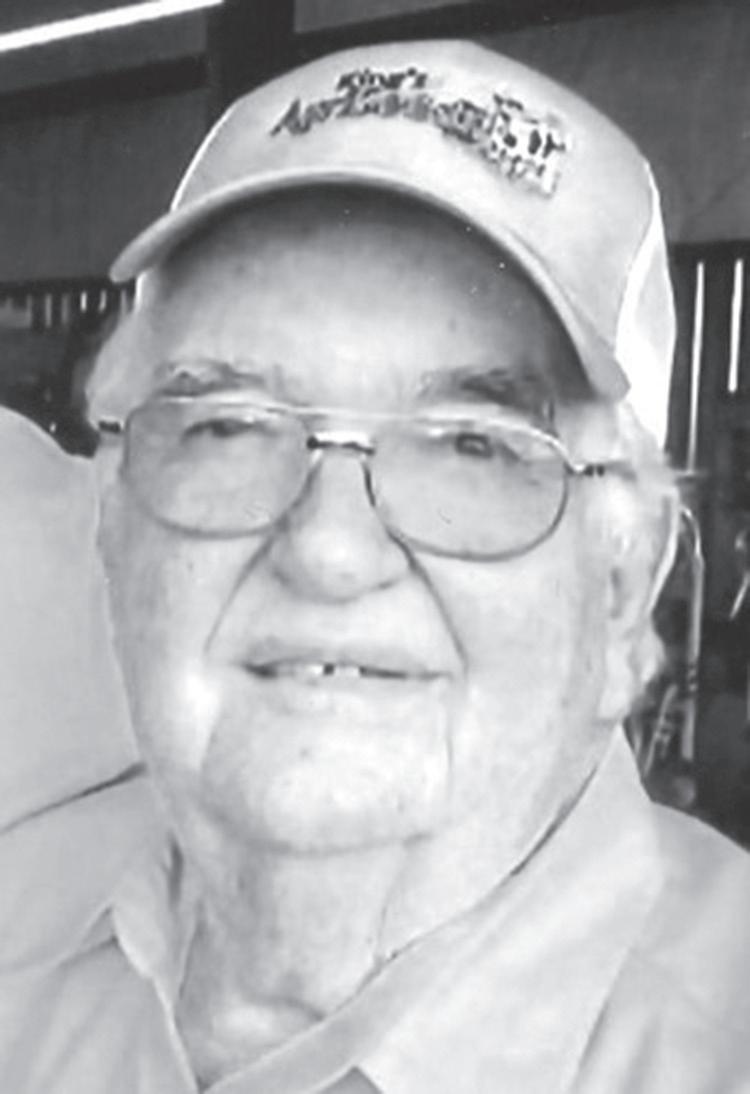
Red left school early to help support his family, and thanks to a few lucky games of pool and the mentorship of local cattlemen, including his father-in-law K.M. Sharpe, Red got his start in the cattle industry. With the help and support of his partner and wife, Ann, Red subsequently enjoyed a 70 year career as a successful order buyer, livestock dealer, and cattleman. He loved traveling throughout America, visiting stockyards and farms, listening to live country and bluegrass music, and attending auctioneering contests. Red had a talent for turning strangers into friends and loved spending time and sharing meals with friends, old and new.
Red is survived by his wife of 61 years, Ann Sharpe Dunlap, sister Marie Dunlap Petty (Don), daughter Laurie Dunlap Scotton ( David), son Benjamin Dunlap (Jamie), grandchildren Emily Scotton, Daniel Scotton (Guin), Savannah Dunlap Coffey (Ryan), Sage Dunlap, and great grandchildren Waylon Coffey, Georgia Coffey, and Swayze Coffey, devoted friend, and sidekick Pablo Salazar, and many cherished extended family members and friends. He is preceded in death by his parents and great grandchild, Bexlee Coffey.
A celebration of life will be held at Red and Ann’s Siler City Farm on June 11, beginning at 12:00 noon for all who knew and loved him. Further details will be announced.
In lieu of flowers, donations can be made at www.heifer.org to Heifer International, which provides livestock to families around the world as a way of addressing economic disparities and hunger.
Carolina than in the nation for most of the last 45 years.
What has made North Carolina such a popular state for growth minded businesses in search of a location and for out-of-state workers and families looking for a new home? There are several factors, some of which are well accepted. Others can spark debate.

Let’s begin with the noncontroversial factors. North Carolina has a wonderful natural geography and amenities. One side of the state has spectacular mountains, and the other side has the ocean and beaches. While summers can be toasty and humid, the state usually avoids long and cold winters.
North Carolina also has good access to markets, especially on the East Coast, via several interstate highways. Interactions with global markets have also improved in recent decades with many new direct international flights, particularly from Charlotte Douglas and RDU international airports.
It’s also less expensive to live in North Carolina. The latest data from the federal government show average prices
are 6 percent lower in the state than in the nation. Some interstate comparisons show even bigger differences – for example, average North Carolina prices are 19 percent below California prices and 16 percent less than New York prices.
North Carolina benefits from its geographic location. The southern part of the country, starting at the Atlantic Ocean and going west to Arizona, has for decades been attracting retirees seeking sun, businesses desiring bigger sales, and households seeking new starts.

Of course, businesses want a well trained workforce. When it comes to higher education, including community colleges and universities, North Carolina has one of the best bargains in the nation. Due to the generous state financial support of North Carolina’s public colleges and universities, North Carolina ranks very high among states for the affordability of those public educational institutions. For businesses, North Carolina’s higher education public institutions are known for developing specialized programs for emerging economic sectors.
Now I’ll dive into the more
controversial factors, which revolve around K-12 education and worker pay.
North Carolina ranks low among states for per-pupil spending in K-12 schools. Although North Carolina compares reasonably well on national reading and math test scores compared to the nation, our scores still rank below proficient.
This has caused an ongoing debate about whether the state’s tax rate reductions in recent years – while attractive to businesses and many earners – may be hurting North Carolina’s competitiveness in the future. One side says the answer is yes, and they want to reverse some of the tax rate reductions, while the other side says numerous nonmonetary factors are important to student success. This debate will likely continue.
North Carolina has a low minimum wage and deters unionization by being a “right to work” state. While these policies may be good for businesses that benefit from lower labor payments and greater control over workers, critics say these benefits sacrifice worker well being. Both average per capita yearly income and average hourly earnings in North Carolina are lower than in
the nation, even after accounting for the 6 percent lower cost of living in the state.

Of course, the state could raise the minimum wage and eliminate the “right to work” provision, and many are in favor of these moves. Significant economic research over several decades suggests these moves could not only deter some new business locations and start ups but might also motivate existing firms to use less labor and more technology for their tasks.
One alternative option would be to reinstitute an earned income tax credit (EITC) in North Carolina. The EITC is a program that refunds some, all, or even all of a worker’s income tax payments plus additional funds, providing more money to increase the worker’s standard of living. The federal government has an EITC, and more than half the states have an EITC for state income taxes. North Carolina had an EITC until 2014.
North Carolina’s economy has been on the move for several decades, and there appears to be no let up in this trend. Several factors are behind this success. But are there downsides to some of those factors that need to be addressed? You decide.
Join the celebration of 150 Years of Angus in historic Victoria, Kansas. Kansas Angus Association to host celebration event May 20. In 1873, George Grant transported four Angus bulls from Scotland to the Kansas Prairie to fulfill his vision of American agricultural success. When crossed with the Texas longhorn cows native to the Plains, the bulls sired calves well-suited to the region. These results demonstrated the Angus breed’s initial value in the United States. The legacy continues to be built today by Angus breeders across the nation.
Angus enthusiasts will celebrate the bulls’ arrival – 150 years later – on May 20 at the George Grant Memorial Cemetery in Victoria, Kansas. The commemoration, hosted by the Kansas Angus Association (KAA), will feature Angus camaraderie, food, education, and more.

“We are excited to welcome all Angus and history enthusiasts to this event,” said Anne Lampe, KAA manager and secretary. “The field day will not only commemorate our 150 year legacy, but will also celebrate the success of the Angus breed and its people as we continue our quest to remain the seedstock and beef industry leader.”
The celebration, set to take place from 11:00 a.m.-3:00 p.m., marks one of many celebrations of this lasting legacy. Attendees will enjoy a Certified Angus Beef brand smoked brisket lunch and be able to view Angus cattle on display in addition to these attractions:
• Educational presentations from Tom Burke, American Angus Hall of Fame; Lindsay Graber-Runft, director of producer communications at Certified Angus Beef (CAB); Rick Pfortmiller, bovine genomics territory manager at NEOGEN; and Kelli Retallick-Riley, American Angus Association
• Bagpipe entertainment performed by Haxton Hoffman
• Wreath Laying and Re-dedication of the George Grant Monument
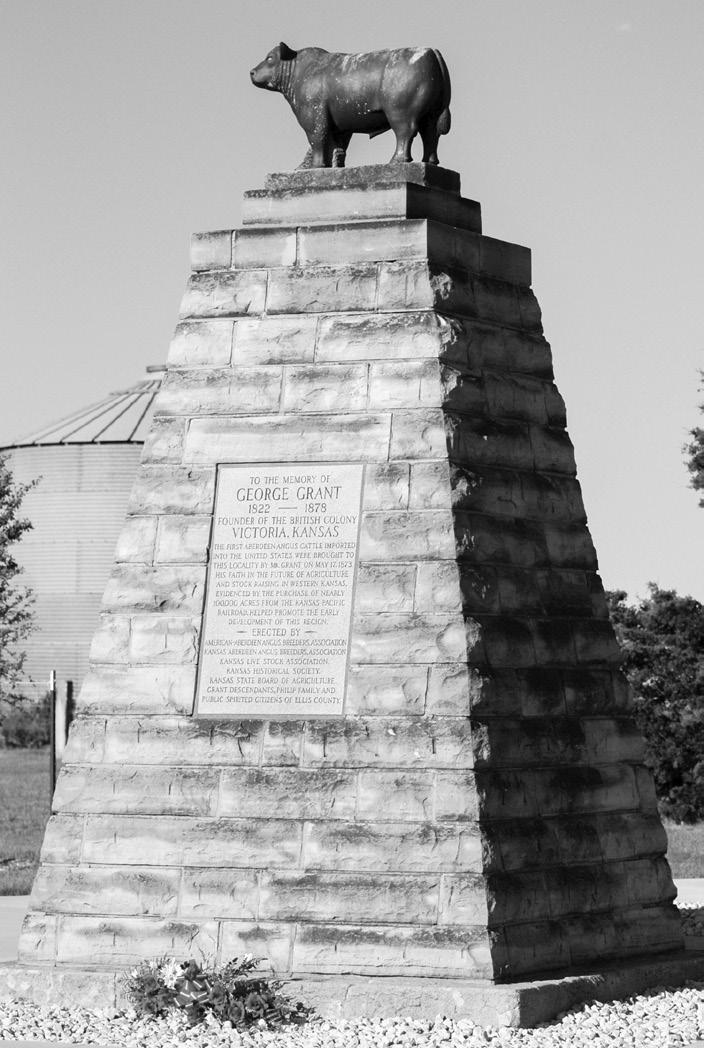
• Viewing of the George Grant Villa and Monument
Additionally, a silent auction will take place during the event, featuring vintage Angus collectibles, a CAB kitchen block knife set, and more. All proceeds of the silent auction will benefit the KAA to support its mission, including the KAA Young Angus Producer Scholarship.
How grazing management can propel your profit. Latest Angus University webinar discusses key grazing management strategies. Grass — vital to producers’ cattle and their profit. With factors like stocking rates, input costs, and soil vigor all playing a part in pasture management, how do cattlemen decide where to place their focus?
“We’re not going out there trying to change what you’ve already got,” said Hugh Aljoe, director of producer relations with the Noble Research Institute. “We first need to make good use of what exists, and then, and only then, cost effectively fill forage gaps of quantity and quality.”
During the Angus University webinar, Gear up for Grazing, held March 28, Aljoe explained how to make better use of existing ranch resources and improve overall grazing practices.
Two factors in grazing management are stocking rate and carrying capacity, and they regularly get confused. Stocking rate measures forage demand or the number of animals grazing, while carrying capacity is the amount of forage supply being grown, Aljoe said. What’s needed is a balance between the two.
“The number one rule of grazing management is to actively manage the stocking rate at or below carrying capacity,” Aljoe said. “What this does is maintain a measure of flexibility within
our operation.”
Aljoe explained that for every year a pasture sits overstocked, typically due to fluctuating rainfall, it takes about two years to recover. He proposes the solution of setting a stocking rate for approximately 80 percent of average rainfall — leading to a more manageable overstocking of about one in six years.
“If you’re doing a really good job with your breeding program, a good job with your nutrition program, and you like the livestock you have, you can carry your own calf crop later into the season to find a better economic marketing opportunity,” Aljoe said.
While the simple solution to a depleting forage supply may be to supplement with hay, this turns into an expensive practice. Aljoe recommends providing intentional grazing allocations to prolong the grazing season.
“We can be a lot more effective if we give them allocations for a day, several days a week at a time,” Aljoe said. “Then we’re more efficient, not only with our land resources, but also managing those allocations further into the year.”
To dive deeper into Aljoe’s presentation, visit bit.ly/40KiyHl . To learn more about Angus University webinars and other educational resources, visit www.angus.org/university
Angus juniors gather for 2023 Raising the Bar conference. National Junior Angus Association members visit South Carolina for annual leadership conference. The 2023 Raising the Bar conference was held in Greenville, S.C., on March 30–April 2. There were 86 National Junior Angus Association (NJAA) members from 24 states gathered for the event, making it the largest Raising the Bar conference to date. Attendees explored college and career opportunities at Clemson University, learned about the region’s agriculture, and participated in activities to enhance their leadership skills and engage with Angus peers.
Each year, NJAA members visit a university with a strong agriculture
program to gain insight into the institution, helping prepare them to determine their future plans. Attendees also network with peers from around the country, participate in personal development workshops, and visit industry relevant attractions in the area.
“The Raising the Bar conference exposes Angus youth to educational opportunities around the country,” said Madeline Bauer, senior events coordinator at the American Angus Association. “NJAA members get to experience college campuses while forming strong relationships with their peers and developing as young leaders.”
The conference began with juniors hearing from a representative from Front Porch Housing, a local supportive housing program for families in need. Through the Angus Impact program, focused on NJAA members serving communities, juniors bring donation items for a local charity to numerous NJAA events throughout the year. Juniors also welcomed keynote speaker and past National Junior Angus Board member Ann Blumer, who now leads Michelin’s material handling for agricultural tires in the United States and Canada.
On Friday, conference attendees arrived at Clemson University for a day exploring campus and learning about opportunities available through the College of Agriculture, Forestry, and Life Sciences. Juniors heard from both faculty members and students around campus before visiting the Allen N. Reeves Football Complex.
Saturday was focused on agricultural tours, starting with a visit to Hickory Hill Milk in Edgefield, South Carolina. Attendees’ next stop was Titan Farms, the largest peach grower on the east coast, located in Ridge Spring, South Carolina. Juniors stayed in Ridge Spring, heading to Yon Family Farms to hear about their Angus operation. In addition, attendees learned about the family’s pecan business, The Nut House and Country Market. That evening, juniors were joined by past National Junior Angus Board members
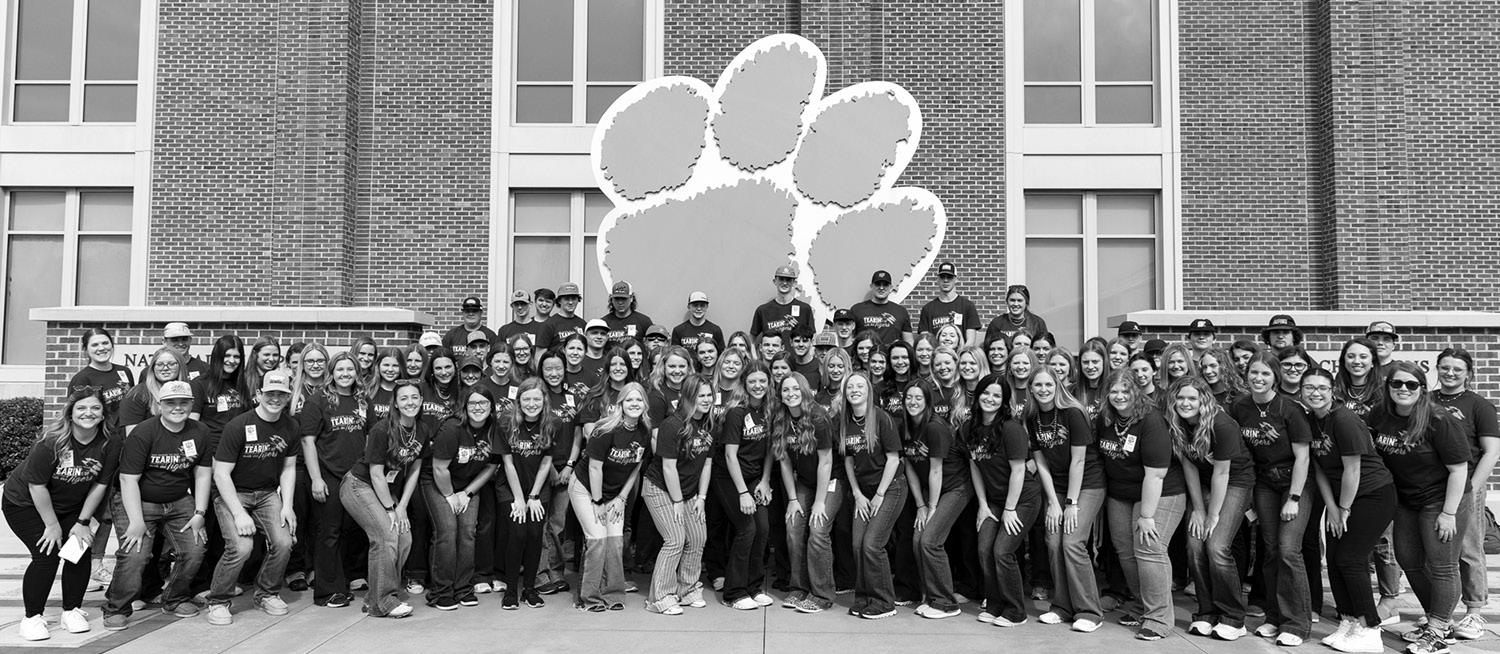
Sally Harrison, Daniel McFarland, and Clay Williams to gain perspective on how their NJAA experiences influenced them beyond their time in the organization.
The conference concluded Sunday morning with a devotional led by McFarland and Williams, followed by personal development workshops from the National Junior Angus Board.
“I enjoy Raising the Bar because I get to see some of my closest friends from around the nation, and I gain so much knowledge from each workshop I attend,” said Lauren Phillips, an NJAA member from Iowa. “Attending Clemson has not only given me a glimpse of the college life, but also a few possible career paths that I may end up going into.”
After 15 years, Raising the Bar continues to foster the development of Angus youth by hosting events in regions across the country. The Angus Foundation makes the conference possible with support from the Angus Fund, which provides unrestricted dollars to further the Foundation’s mission of enhancing education, youth, and research for the breed. To learn more about the Raising the Bar conference, visit njaa.info.
Angus Foundation to host 22 nd annual golf tournament. Sponsorship opportunities and registration now available for the July 4 event. The Angus Foundation invites all golf and Angus enthusiasts to enjoy a day on the green at its annual golf tournament, held in conjunction with the 2023 National Junior Angus Show in Grand Island, Nebraska. The event, which benefits the Foundation’s mission of supporting Angus education, youth, and research, will be held on July 4 at the Indianhead Golf Club in Grand Island. Registration will begin at 6:30 a.m., with a shotgun start at 7:30 a.m.
The 2023 event will be held in memory of William “Bill” Davis of Belgrade, Montana. Davis, who passed away on May 5, 2022, after a three year battle with pancreatic cancer, was a passionate Angus breeder and avid golfer. With the support of Davis’ family and friends, the golf outing will be sponsored in his honor.
“We are fortunate to host the 22 nd Annual Angus Foundation Golf Tournament in honor of Bill Davis,” said Jaclyn Boester, Angus Foundation executive director. “This event always serves as a great opportunity to enjoy Angus friendship while supporting a worthy cause.”
Sponsorship options are available for state and regional Angus associations, individuals, businesses, farms, and ranches. There are promotional opportunities at eight sponsorship

levels: luncheon, beverage/player cart, tournament prizes, clubhouse, hole-inone, tee box, hole, and flag. Sponsors will be recognized in the tournament program; tournament luncheon; post event news release; Angus Journal ; and the Angus Foundation website. The sponsorship deadline is June 3.
Player registration remains open until June 20. Adult registration is $100, and National Junior Angus Association member registration is $75. Players receive 18 holes of golf, golf cart rental, continental breakfast, and Certified Angus Beef brand lunch. Mulligans will be available at the course for $10 each, with a limit of one per player. After the registration deadline, adult player registration will be $110, and junior members will be $85.
For player registration, sponsorship opportunities, or more information about the golf tournament, contact Kris Sticken with the Angus Foundation at 816-3835100, or visit AngusFoundation.org
About the Angus Foundation. Established as a 501(c)(3) organization in 1980, the Angus Foundation remains focused on its mission to support Angus education, youth, and research. The organization has distributed more than $3.9 million in youth scholarships since 1998 and has also invested more than $1.3 million in beef cattle research in the past decade. For more information, contact the Angus Foundation at 816383-5100.
Angus Means Business. The American Angus Association is the nation’s largest beef breed organization, serving more than 22,000 members across the United States, Canada, and several other countries. It’s home to an extensive breed registry that grows by more than 300,000 animals each year. The Association also provides programs and services to farmers, ranchers, and others who rely on Angus to produce quality genetics for the beef industry and quality beef for consumers. For more information about Angus cattle and the American Angus Association, visit www.angus.org
Backed by the world’s largest and most reliable genetic evaluation program. Registered Angus genetics deliver better calving ease, more growth, and superior marbling.
455 GORE FAMILY ANGUS Mark & Lori Gore Tabor City
702-401-8005 • 455goreangus@gmail.com www.455farms.com
4K FARMS/TARHEEL ANGUS Richard D. Kirkman, DVM Siler City 919-742-5500 • rdk.cefa@gmail.com
BACK CREEK
Joe & Robin Hampton Mt. Ulla
704-880-2488 (Joe); 704-880-3572 (Robin) robinbackcreek@att.net
Facebook: Back Creek Angus
BILTMORE ESTATE
Kyle Mayberry - Manager Asheville
828-768-1956 • livestock@biltmore.com www.biltmorelivestock.com
CARSON FAMILY FARM, LLC
John, Callie, Isaac & J.R. Carson Laurel Springs 336-818-9087 • carsonfamilyfarm@gmail.com
CHAPMAN CATTLE COMPANY Bryant Chapman Taylorsville 828-514-0526
FOUR S FARMS
Kim & Connie and Jason & Robin Starnes Luther Lyerly - Manager Salisbury 704-640-5875 • kim-4sfarms@carolina.rr.com
GENTRY HOMEPLACE ANGUS Howard & Donna Gentry King 336-413-6698 • whgentry@windstream.net
GRAGG FARMS
Paul, Chris & David Gragg Boone 828-268-4136 (Paul); 828-268-4137 (Chris) 828-268-4135 (David) gragg_farms@hotmail.com
H&H FARMS
Buddy & Jennifer Hamrick - Owners Bly Hamrick - Manager Boiling Springs 704-472-1912 • jennham@bellsouth.net
HI-LO FARMS, LLC

William & Kate Reichert Fuquay-Varina 919-812-0435 • hilofarmsblackangus.gmail.com
Cortney Holshouser NCAA Executive Secretary 919-796-2346 ncaa.sec@gmail.com www.ncangus.org
HILL ANGUS FARM
Dr. Gary M. Hill Hendersonville 229-848-3695 • gmhill@uga.edu
JACK KNOB FARMS
Karl, Janet & Logan Gillespie Franklin 828-371-2220 • karl@jackknobfarms.com www.jackknobfarms.com
JENKINS ANGUS FARM
Jaime & Christy Jenkins Marshall 828-206-1345 • jenkinsangusfarm@gmail.com
KNOLL CREST FARM
The Bennett Family Red House, VA 434-376-3567 • knollcrestfarm@knollcrestfarm.com www.knollcrestfarm.com
LANE ANGUS
Roger & Bundy Lane
Bundy Lane - Manager Gates 252-398-7705 (Bundy); 252-398-7719 (Miranda) 252-357-1279 (Office) bundylane@hughes.net; laneangusbeef@gmail.com www.laneangusbeef.com
PANTHER CREEK FARMS
John C. Smith, Jr. Pink Hill 252-526-1929 • johnsmith3982@embarqmail.com
S&J Farms
Steven & Julie Lung Nathan Lung - Manager Carthage 910-947-3414 • sandjfarms2013@gmail.com
SMITH CREEK ANGUS FARM
Marty & Lynne Rooker Norlina 252-213-1553 • mrooker@mrookerlaw.com
SPRINGFIELD ANGUS Phil Goodson Louisburg 919-880-9062 • philgoodson2@gmail.com www.springfieldangus.com
TRIPLE LLL ANGUS Greg Little Monroe 704-219-1294 • greg.little@atimetals.com
VANDEMARK ANGUS Keaton & Janie Vandemark Spring Hope 252-885-0210 • keaton@vandemarkfarms.com

WINDY HILL FARMS, LLC
Michael A. Moss Will Moss - Manager Ramseur 336-460-7451 • windyhillfarmsllc@gmail.com
WINSLOW GENETICS Ben & Kathleen Winslow Halifax 252-578-5487 • bensbulls@gmail.com
WOOD ANGUS FARM, LLC Russell Wood Willow Spring 919-275-4397 • rwood4400@gmail.com www.woodangus.com

Letters to the editor are welcome and we appreciate your input. HOWEVER, letters that are not signed will not be considered for publication.
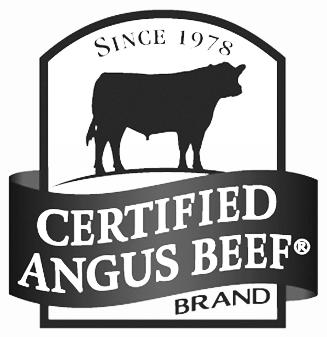
In Tough Times: Minimize Waste, Maximize Genetics through Management. An investment in superior genetics and prioritizing nutrition could pay dividends for the cattleman. Ranching brings rewards, but it’s not all “sunshine and rainbows.” With drought and high input costs in the balance, it takes sharp management decisions to keep black ink on the bottom line.
Knowing what to cut back or keep doing was the focus for Dusty Abney, beef cattle nutritionist for Cargill Animal Nutrition, during his Cattlemen’s College session at the 2023 Cattle Industry Convention.
“It’s easy to just walk out there and say, ‘What can I cut?’ And in this environment, with the kind of production that we demand from these cattle and the money we spend on genetics, I think
that’s a grave mistake,” Abney said.
Even with increasing prices at the meat case, consumers continue to purchase high quality beef. That’s why he cautioned against decreasing the bull budget. Investments in superior genetics could still pay.
When buying bulls, added carcass value helps increase your calf crop’s Certified Angus Beef (CAB) acceptance rate, which has proven to add premiums. To assist in bull selection this sale season, Angus bull buyers can look for the Targeting the Brand™ logo in sale catalogs. The logo signifies that a bull has a minimum expected progeny difference (EPD) for marbling of +0.65 and an Angus Grid Value Index ($G) of +55 or higher.
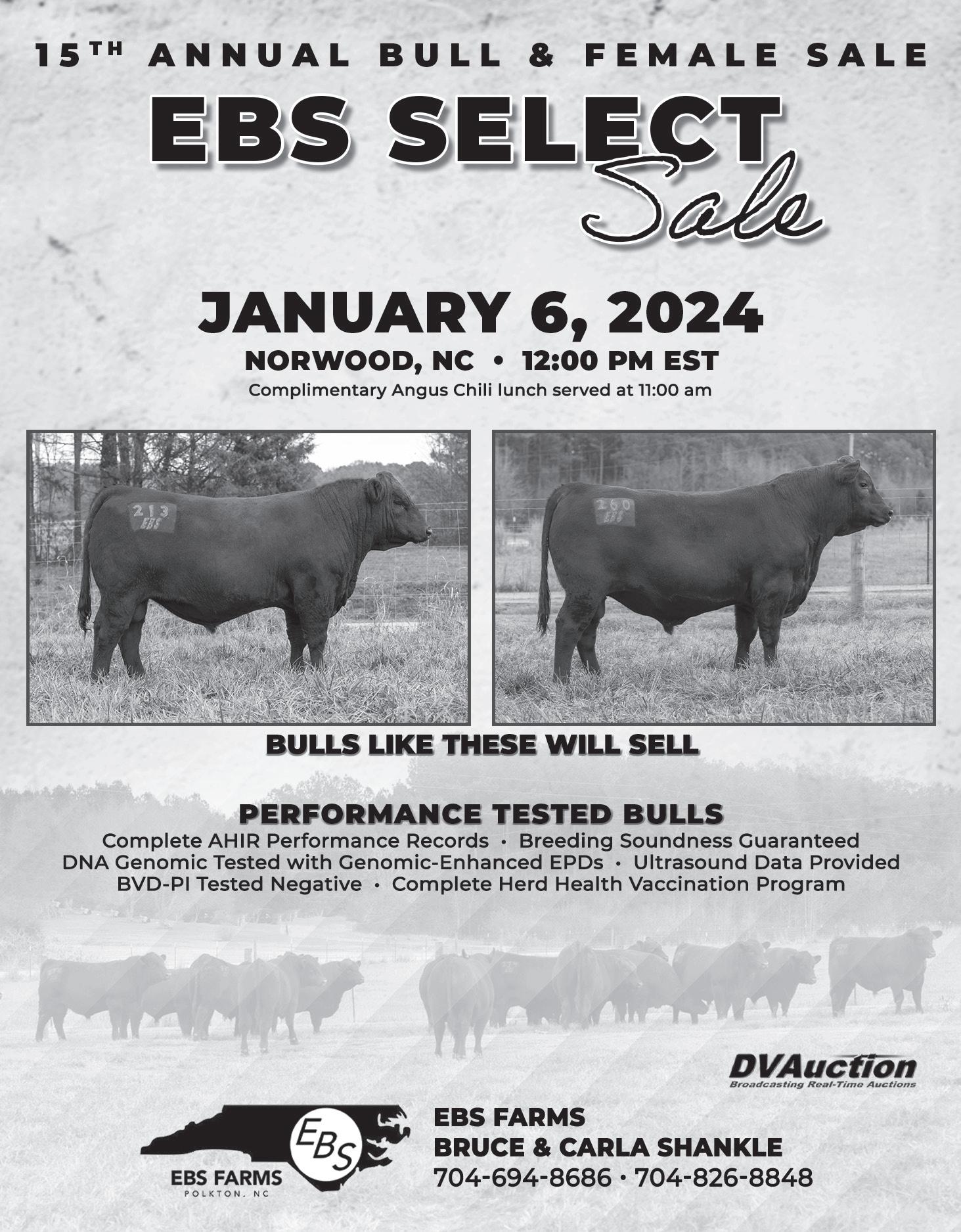
The proof is in the data.
Sire identified carcass data from more than 8,600 records in the American
Angus Association database, showing those EPD values are minimum thresholds to achieve an average of 50 percent CAB acceptance. But those numbers alone won’t get it.
“If you invest in genetics and don’t invest in your nutritional program, your animals will never express their full genetic potential,” Abney said.
Make Nutrition a Priority - From a bull purchased during this bull sale season to calves born and heifers retained this year, nutrition should be at the top of the list for management.
“Doing what you have to” in times of high operating costs makes sense, Abney said, but it should not turn into an excuse. Fetal programming implications say nutritional decisions on bred females affect a cow herd in the short and long term.
“If you short her, she will short you,” Abney said. “A cow never gets a day off, and what we provide that animal from a supplementary basis and from our forage base affects her and her calf.”
What and how you feed a cow matters, so Abney suggests building a nutrition plan. Consider ingredient sourcing, infrastructure, and the balance of nutrients against requirements. Then look at the feeding process - quantity, time, and method for feeding. Nutritionists can provide key advice on the “what and how” to achieve targeted gains, improved herd health, and overall profitability.
Looking at a drought scenario specifically, Abney noted the first step of understanding what’s available for cows to consume. To keep rumens operational, cows need more than one percent roughage on a dry matter basis. Supplement that with energy, such as corn, distiller’s grains, or whole cottonseed, based on nutritional requirements.
Meeting those protein and energy needs is essential to rumen function.
“If the rumen ain’t happy, ain’t nobody happy,” Abney said. “So, we’ve got to keep those bugs (rumen microbes) happy so they’ll feed the cow.”
Rising input costs on the ranch bring the temptation to buy the cheapest hay available. If you do, make the best of it by ordering a forage quality test to learn the crude protein percentage and relative feed value. Then, supplement if required.
High quality beef production requires mineral supplementation. But through a drought, that supplement can vary greatly. Forage test results and other feed evaluations can show where to adjust mineral inputs for a better bottom line.
Wondering where it could make sense to cut back on the spending? If feed and forage tests show a compelling financial reason, it may be okay to opt out of ionophores and implants on calves
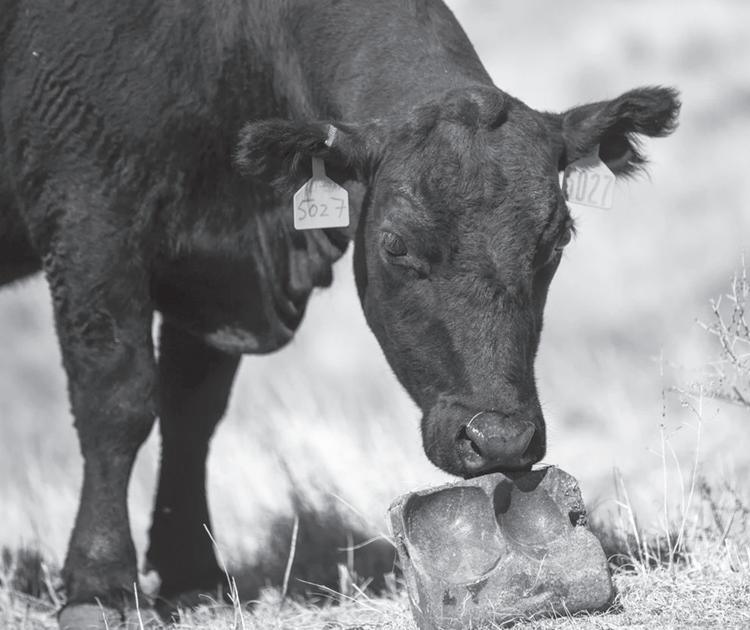
and yearlings. Aside from skipping those typically recommended technologies, remember that basic herd health practices, such as vaccinations, deworming, and fly control, should be continued and prioritized.
Minimize Feed Waste - A better option could be examining what’s going to waste. Abney said well run operations can suffer from 5-10 percent feed waste daily, depending on the type of ingredient and how it is fed.
Feed/ingredient cost - $300/ton 15% shrink
Feed/ingredient actual cost is ~$352.94/ ton
$300 ÷ 0.85 = $352.94
Beyond feed delivery, Abney suggests looking at hay waste, including feeder type.
A 2015 University of Missouri study into fescue hay waste by bale feeder type found a 19.2 percent loss for open rings, 13.6 percent for those with a bottom sheet, and 8.9 percent for cone designs.
Correct hay storage helps reduce waste, too, Abney said. Ensiled forages are susceptible to loss from poor fermentation or exposure to air after fermentation.
Through a drought, cattle producers should evaluate mineral supplements based on forage quality tests and other feedstuffs available.
Planning for the WorstDetermining how and what to feed while reducing waste requires a plan. That doesn’t stop at feeding, Abney said.
Build an overall plan for high stress situations like drought and high input costs, he suggested. By managing what can be managed and examining the consequences of decisions made, you can best target positive results.
“We have to make sure that we’re not giving into analysis paralysis where we just wait for something else to happen,” Abney said. “Not making a decision is still a decision.”
Navigating tough decisions while managing resources to meet your herd’s nutritional needs at least takes focus. When those things are complicated by conditions
outside of our control, sharper management can still find the rewards in ranching.
On the other hand, a lack of focus on profit near the top of the cattle market cycle will make a greater impact later in that cycle.
“If you make wasteful decisions and those decisions come back to haunt us,” Abney said, “it’s not going to be in a time when prices are good.”
Connecting the Culinarian and the Rancher. Certified Angus Beef hosts student event that connects the next generation of ranchers and chefs. A chef and a rancher have more in common than one would assume: long hours, sometimes grueling environments, and a rewarding day’s work.
Five young Angus ranchers gathered alongside five Johnson & Wales culinary students for the inaugural Certified Angus Beef (CAB) Connecting the Culinarian and Rancher event, where they had the chance to learn from each other and then break bread together.
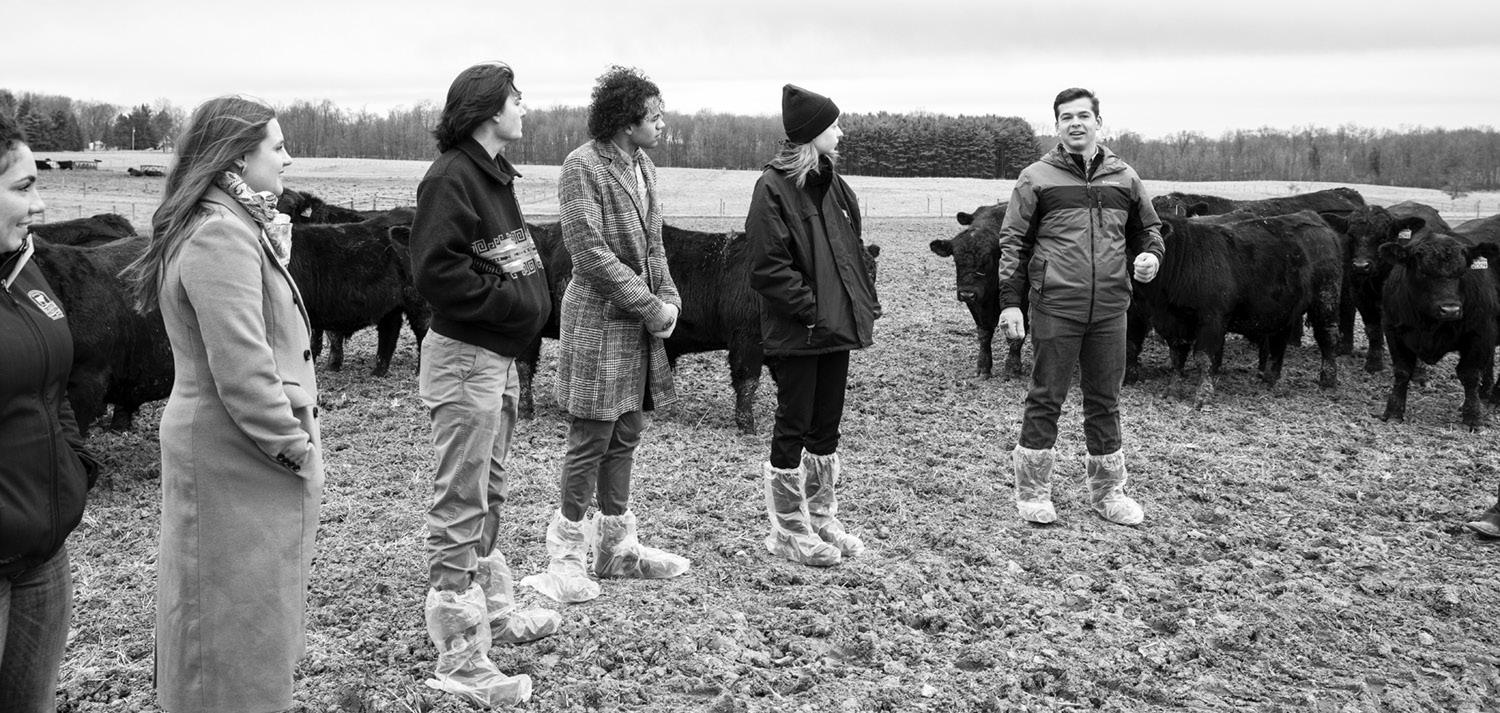
“We saw this as an opportunity to bring the young generation of ranchers and the young generation of culinarians together in one space to have conversations about the who, why, what, and ‘How can we do this better?’ of both raising cattle and serving beef in a restaurant,” says Ashley Breneman, CAB executive chef. “This also gave these students the chance to establish lifelong relationships at opposite ends of the beef supply chain.”
The day started with introductions and backgrounds of where each of the students got their start and what they are studying in college. Everything from sustainable food systems to livestock genetics, these ten students brought unique perspectives to the table from around the country.
Johnson & Wales University students attending were Elijah Smith of Rhode Island, Ben Morris of Rhode Island, Aidan Kincaid of New Jersey, Lydon Olivares of California, and Aroura Hammond of North Carolina . Ranchers at the event were Jace Dickerson of Kansas, Mia Encinias of New Mexico, Lauren Gilbert of Missouri, Colter Pohlman of Texas, and Garrett Ulmer of South Carolina
The students spent the morning at Chippewa Valley Angus Farm, where the young ranchers each discussed topics related to raising cattle. Animal nutrition, Angus breed characteristics and genetic selections, animal care and handling, sustainability, and live cattle marketing gave insight to the culinary students about what it takes to produce a high quality steak.
“Even though we come from different backgrounds and totally different ends of the country, we all end up having the same end goal,” says Mia Encinias, West Texas A&M animal science student. “As ranchers, our goal is to create the best product possible, but the chefs’ is to serve it. Without one another,
we wouldn’t be able to do what we do.”
Once the students were back at the Certified Angus Beef Culinary Center, chefs Ashley Breneman and Peter Rosenberg led a taste panel for the students to taste the difference between grades of beef. Then, they shared their tips for cooking the perfect steak as chef-rancher teams paired up to put their grilling skills to the test.
“I was paired up with a young rancher, and we cooked our steaks together,” says Aroura Hammond, culinary student. “I utilized techniques that I’ve learned in culinary school, and it was really cool because, at the ranch, I didn’t really know anything. Behind the grill and countertop, they didn’t really know anything. The script was flipped.”
Hammond, a bachelor’s culinary student at Johnson & Wales University, had never spent any time on a cattle farm before visiting Certified Angus Beef and Chippewa Valley Angus in Wooster, Ohio. After spending a day with peers who’ve grown up on farms and ranches across the country, she was astounded by the similarities between being a farmer and a chef.
“From what I’ve learned so far, and I’ve just barely scraped the surface, ranchers work long hours and they truly care about the product they are producing,” she says. “They’re not the ones cooking it, but it’s years and years of hard work, genetic development, and care for the cattle that leads to the production of this dish and these steaks that we serve.”
She went on to share how long hours in the kitchen and years of hard work to develop the skill necessary to make a great product that guests desire and keep coming back for is challenging, yet that’s her goal.
“I think that there are a lot of similarities between us, and the shared passion and love for the product has been really cool to experience,” Hammond says.
Beyond the hands-on education, conversations about the students’ experiences were shared with each other. Everything from stories from the kitchen and the ranch to the swapping of movie
recommendations and notes of accuracy in movies like Ratatouille and Temple Grandin.
“Oftentimes, we talk about the disconnect as producers, but it was really eye opening to see that these people want to know what we do and how we do it,” says Lauren Gilbert, University of Missouri agriculture business student. “We can do a better job of sharing what we do on the farm, and one way to do that is to establish these relationships and keep in touch.”
The culinary students felt similarly after the event.
“This experience has just been a really unique opportunity,” Hammond says. “I didn’t know anything about Certified Angus Beef or where my product was coming from. So to experience these young ranchers, meet them face to face, and hear them tell stories about their families, it’s been really cool to break bread and share our skillsets, our experiences, and connect over things that I had never even anticipated or expected before.”
Leaving the event with new friends and fresh perspectives, the students took their experiences back to their campuses and family ranches with nimble hands, open minds, big ideas, and a newfound responsibility to consider the opposite end of the supply chain when making business decisions down the road.
More importantly, these students learned they will always have a seat at each other’s tables no matter where life takes them.
Who is Certified Angus Beef? At Certified Angus Beef, we know people want to put great meals on the table. Our employees work across the beef supply chain to ensure chefs and home cooks find and prepare the best Angus beef. Led by our culinary, beef, and marketing experts, our team provides consultation, marketing materials, training, market insights, and tools that help businesses like grocery stores and restaurants thrive. Our team is also dedicated to sharing the story of family farmers and ranchers who supply the brand.
ASA Names Leading Breeders. The American Simmental Association has named the leading breeders by each state. In North Carolina, Fred Smith Company Ranch in Clayton is once again the top Simmental producer with the most registrations. FSC Ranch is followed by Benjamin Winslow from Halifax, his first time in the top five listing. Massey Farms in Burlington, High Ridge Farms in Albemarle, and TX Enterprises in Winston-Salem round out the list of Top Five in North Carolina.
For South Carolina, the top Simmental producer is once again Yon Family Farms in Ridge Spring, followed by Baxley Farms in Georgetown. A new
By JENNIE RUCKER Executive Secretary N.C. Simmental Association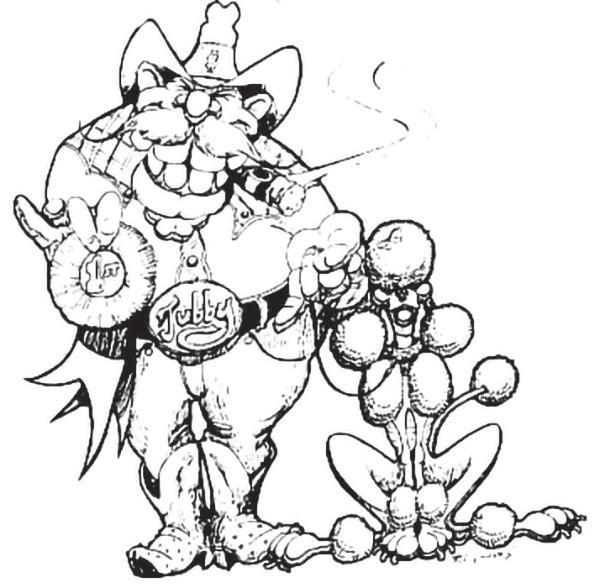

name, Equity Trust Custodian FBO N Dinkel, is third, followed by Longview Farm in Anderson, and Nickle N Dime Farms in Six Mile.
The state of Virginia’s top Simmental producer is McDonald Farms in Blacksburg. Shenandoah Valley Simmentals in Quicksburg moves down to second in the top five listings, followed by Edgewood Angus in Williamsburg, Smith Reasor of Rural Retreat, and Virginia Tech in Blacksburg.
Most Used Bulls. The American Simmental Association has published the most used bulls by the number of progeny registered in 2022. This year the number one bull with 1,626 progeny registered
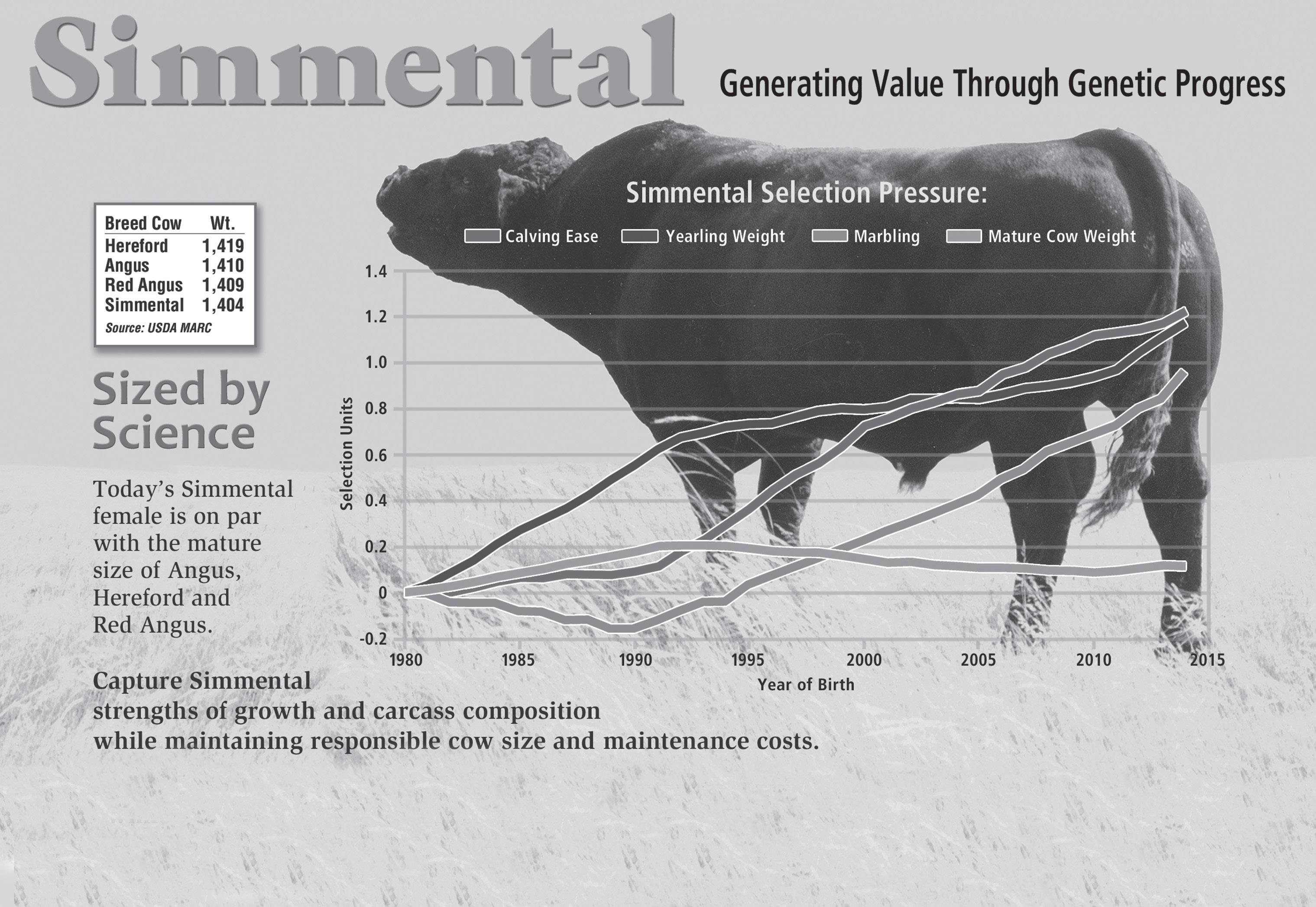
was a ¾ blood SimAngus, Hook’s Eagle 6E, a son of Hook’s Black Hawk 50B. The top five bulls are three purebreds and two percentage Simmental bulls. The first red Simmental to appear is IR Imperial D948, who occupies the number 30 position, down from his number 21 position last year. IR Imperial has 380
progeny registered.
This year a purebred Angus, SAV Rainfall 6846, makes an appearance in the number 33 position with 363 progeny registered. Another purebred Angus, Tehama Tahoe B767, also makes an appearance in the number 49 position with 268 progeny registered.
Our advertisers are “Champions” too.
For expert A.I., superior genetics, the best in purebreds and outstanding farm supplies, check the Classifieds in this issue!


Crystalyx Mineral and Goldilocks. While minerals are a relatively small portion of an animal’s diet, they control many vital functions, such as the reproductive system and nervous system, and contribute to other economic production traits, such as feed efficiency and overall herd health. Animal mineral requirements fluctuate throughout the year depending on the stage of production; however, year round supplementation is vital to maximizing performance.
Supplementation is the best method to “bridge the gap” between cow requirements and what is available in the forages being consumed at any given time. Crystalyx mineral supplements are an effective way to provide the necessary nutrients throughout the year. Here’s why:
Cattle consume it - When selecting the perfect supplement, we often get drawn into what the tag says, but while the mineral levels and trace mineral forms are important, the first step in providing a mineral is to choose one that cattle will actually consume! While that may sound obvious, it really is the first step in making sure your cows get what they need.
Research out of Montana State University tracked the percentage of cows consuming a conventional dry mineral with cows consuming Crystalyx. Results show that whether cattle are grazing or being fed harvested forages, 86 percent or more will consume a Crystalyx mineral supplement compared to 55–63 percent consuming a conventional dry mineral.

(Rangeland Ecology & Management 60(1), January 2007)
Consistent, controlled intake - We can think about mineral intake in terms of the story of Goldilocks. Too little won’t deliver the necessary nutrients to reach peak performance, but too much can become very costly for the producer’s pocketbook. Right down the middle, with consistent and controlled intake, at the recommended level the mineral is formulated for, is “just right.”
When mineral supplementation is in the Crystalyx low moisture block form, the hardness of the block controls intake while the molasses content improves the palatability of otherwise less palatable mineral ingredients. The sweet taste entices cattle to visit the supplement, but they need to lick at it to consume it, as it is hard enough that it cannot be bitten or chewed. A 4 oz. intake of Crystalyx mineral options such as Crystal-Phos or Blueprint 6% Phos, or an 8 oz. intake of Mineral-lyx, gives excellent results at a low cost per head per day.
Delivery, equipment, and weatherization - When compared to other supplement forms, Crystalyx wins at the ease of use and lower labor and equipment requirements. Simply place barrels where you want cattle to graze (more on that at www.crystalyx.com/ grazing-and-environmental/grazingmanagement-using-gps), with no feeders or other equipment necessary. Want to take it one step further? Feed Crystalyx in the BioBarrel with WeatherAll Protection, eliminating the need to pick up empty
barrels or tubs.
The weatherization of Crystalyx also makes it a foolproof mineral supplement option. After spring rains, for example, cattle will remove the moisture from the top of the barrels and go on to consume the product with no waste.
Multitasking - Crystalyx is made with multitasking in mind. All Crystalyx mineral options contain Bioplex organic trace minerals. Spring and summer also bring on flies, and Crystalyx fly control options are available to deliver ClariFly or Altosid IGR in your mineral supplement. Look for Crystalyx Blueprint 6% Phos with ClariFly for the best multitasking supplement this spring and summer, or go to www.crystalyx.com or visit your local Crystalyx dealer to find the right Crystalyx mineral for your cattle needs.
Consistent consumption, low cost per head per day, and multitasking capabilities combine to make Crystalyx mineral “just right.”
About Ridley Block Operations. Ridley Block Operations manufactures and markets block supplements, loose

minerals, and dried molasses for cattle, equine, sheep, and goats. Products are sold under highly recognized proprietary brand names, including Crystalyx.

Blocks utilize a variety of liquid and dry ingredients combined with unique manufacturing processes that produce self fed block supplements for the marketplace. RBO is the largest manufacturer of block forms and recognized as the industry leader in block supplements.
Since 2000, RBO has added four additional block forms to the original low moisture block product line, including pressed, poured, compressed, and, most recently, CLMB – a patented hybrid form combining compressed block and low moisture block. We are the only company able to provide our customers with all five block forms from a seven plant manufacturing system spanning North America.
Crystalyx Brand Supplements are manufactured by Ridley Block Operations, a division of Alltech Inc. Our headquarters are located in Mankato, Minnesota.
Cow Power Delivers Validation and EPD Accuracy. Dr. Bob Weaber, Kansas State University, shares in a recent interview the merit and value of establishing “Cow Power,” a female genotyping project that is a collaborative effort between the American Gelbvieh Association (AGA), American Gelbvieh Foundation (AGF), and Neogen to increase the number of genotypes and phenotypic information on females in the AGA herdbook. The information allows producers to make data driven female selections for their herd on an ongoing basis.
Weaber, a genetics consultant for the AGA, says that collecting genotypic information from cow herds is an excellent way to establish and maintain validated, parent verified pedigrees on cows in the herd.
He says that the true value of the Cow Power project is found in genotyping because of the significant amount of information it adds to the genetic evaluation system.
“The accuracies of the EPDs on those females improve to provide more precise breeding opportunities for those cows,” he says. “By gathering the genomic information, we get more information about that cow’s genetic potential and her lifetime production. Genotyping cows or heifers early in their life provides opportunities for more precise breeding of those females, and genotyping allows us to track out a cow’s trajectory and your herd’s trajectory for genetic trends using that genomic information.”
Weaber shares that even in well managed herds, somewhere between five and ten percent of the pedigrees are incorrect. And while he says those discrepancies aren’t anyone’s fault, they do impact the accuracies of the EPDs that are calculated from those animals. The Cow Power project is instrumental in resolving pedigree discrepancies, allowing producers to know the pedigree, and providing accurate values for EPD calculation.
Not only does the information collected help to strengthen the AGA’s database and improve genetic predictions, but members will also see the benefit of having this information collected on their own cow herd. Because females typically only have one calf per year, it can take years before data is collected on even just a handful of her progeny. For traits such as weaning weight and yearling weight, a genomic test can offer as much information as having 25 calves
on the ground. For marbling and back fat, it’s the equivalent of having ten progeny reported for those traits. Having this type of information on every female in the herd not only helps increase the accuracy of the EPDs but allows producers the knowledge to make more informed breeding and selection decisions.
Producers who participate and remain engaged in the Cow Power project will have access to the research to genotype replacement heifers. If a producer has submitted 90 percent of the genotypes for mature cows, along with mature body weight and body condition score in the first year, the member will be eligible to submit replacement heifers annually at the research price as long as the project continues. A minimum of 90 percent of the replacement heifers must be tested to receive research pricing.
“Cow Power allows you to plot your own destiny through the use of genomic information, which allows you to select heifers that go into the replacement pen –you can really key in on those important traits based on a heifer’s EPDs and genomic information,” he says. “From an association perspective, genotyping a broader group of animals in the population creates a greater representation of all the genotypes in the total herd. That data allows us at the research level and at the genetic evaluation level to do a better job of documenting differences in genetics because of the broader sampling.”
Weaber says that current pricing also makes the Cow Power project attractive and encourages producers to invest in their herds by utilizing the technology.
With generous support from the American Gelbvieh Foundation, the Cow Power project is now offering a lower price for the genomic test. Through participation in the project, members have the opportunity to receive a research price of $20 for a GGP-100k genomic test on females to DNA test at least 90 percent of their current active cow inventory. Additionally, participants who submit both mature weights and body condition scores electronically on at least 90 percent of the current active cow inventory will receive an additional one time $4 rebate per head. Thus, all females can receive a GGP100k genomic test for only $16. For just $1 more than a parentage test, members are encouraged to take advantage of this incredible opportunity and learn about the cow power in their herd.
To enroll in the Cow Power Project, contact the AGA office at 303-465-2333 or visit Gelbvieh.org

projects, help members with DNA testing questions, and focus on member education efforts.
the Cow. Sustainability is a popular topic of conversation within the beef industry, with discussions surrounding improving operational efficiency and increasing transparency to build consumer trust while remaining profitable. For beef producers, sustainability starts at the herd level with the cow. With an efficient use of resources, the Gelbvieh cow is the picture of sustainability in today’s modern beef industry.
Gelbvieh females do more with less. Gelbvieh and Balancer cattle offer maternal superiority through increased longevity, added fertility, and more pounds of calf weaned per cow exposed. Additionally, Gelbvieh and Balancer females offer a reduced mature cow size, greater calving ease, and reach puberty at an earlier age.
U.S. Meat Animal Research Center data shows Gelbvieh females have the smallest mature cow size and are the earliest to mature of the major beef breeds. The Gelbvieh breed was the only breed in the study to reduce mature cow size – at an average of 1,382 pounds –Gelbvieh sired females had the lowest five-year-old cow weight. This reduced mature cow size allows for puberty to be reached at an earlier age, which leads to calving earlier in the season and producing a heavier calf at a younger age.
Gelbvieh and Balancer genetics deliver maternal superiority in planned crossbreeding systems. Gelbvieh maternal influence offers added fertility, increased longevity, and more pounds of calf weaned per cow exposed. Using Gelbvieh and Balancer genetics can increase profitability through heavier weaning weights, improved feed bunk efficiency as well as heavier, faster gaining cattle. Highly productive cows with adaptability, versatility, and sustainability can have a positive impact on the producer’s bottom line.
Sustained production in the cow herd is essential. Gelbvieh females are proven to stay in the herd longer and consume less while weaning heavier calves. Gelbvieh influenced females are the smart, reliable, and profitable maternal choice for achieving sustainability in today’s modern beef industry. Be sustainable, breed Gelbvieh.
Dannehl Joins American Gelbvieh Association. The American Gelbvieh Association is pleased to announce the addition of Sarah Dannehl, Wymore, Neb., to the AGA staff as the performance programs coordinator. In her role, Dannehl will assist AGA members and customers with the AGA Online Registry Service, support AGA data collection
“We are excited to have Sarah joining our talented AGA team,” says Megan Slater, AGA executive director. “She has a strong cattle background and a well suited set of talents that make her a great fit for this role where she will work closely with AGA members and customers.”
Dannehl grew up on her family’s farm and ranch in Bertrand, Nebraska. She was heavily involved in 4-H and FFA showing cattle and horses. She received her bachelor’s degree in Animal Science from the University of Nebraska-Lincoln in May 2020. She was involved in the Sigma Alpha agricultural sorority and the Alpha Zeta national honor society. During college, she pursued many animal science related internships, but she didn’t find her niche until she interned with the AGA in 2019.
“Growing up on my family’s commercial cow/calf operation, raising Gelbvieh and Balancer cattle, the breed is very near and dear to my heart,” said Dannehl. “I truly enjoyed my internship with the AGA and am excited to be back working with the AGA team as well as members and producers.”
Dannehl began her role on April 17 and can be reached at sarah@gelbvieh.org or the AGA office at 303-465-2333.
About the American Gelbvieh Association. The American Gelbvieh Association is a progressive beef cattle breed association representing 1,100 members and approximately 40,000 cows assessed annually in a performance oriented total herd reporting system.

Y’all have stumbled on the best place to advertise expert A.I., superior genetics, the best in purebreds and outstanding farm supplies. Check the Classifieds in this issue!


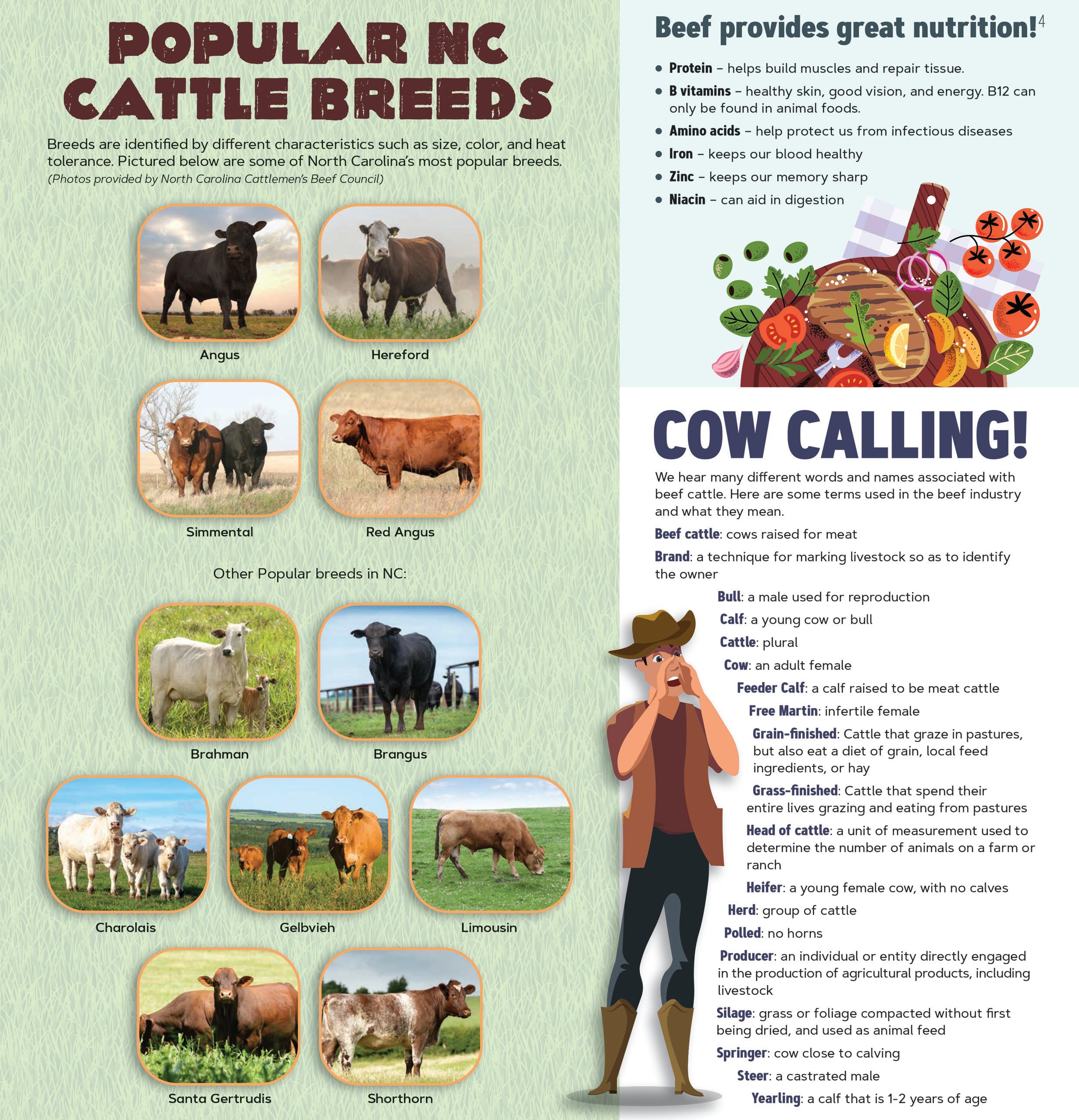
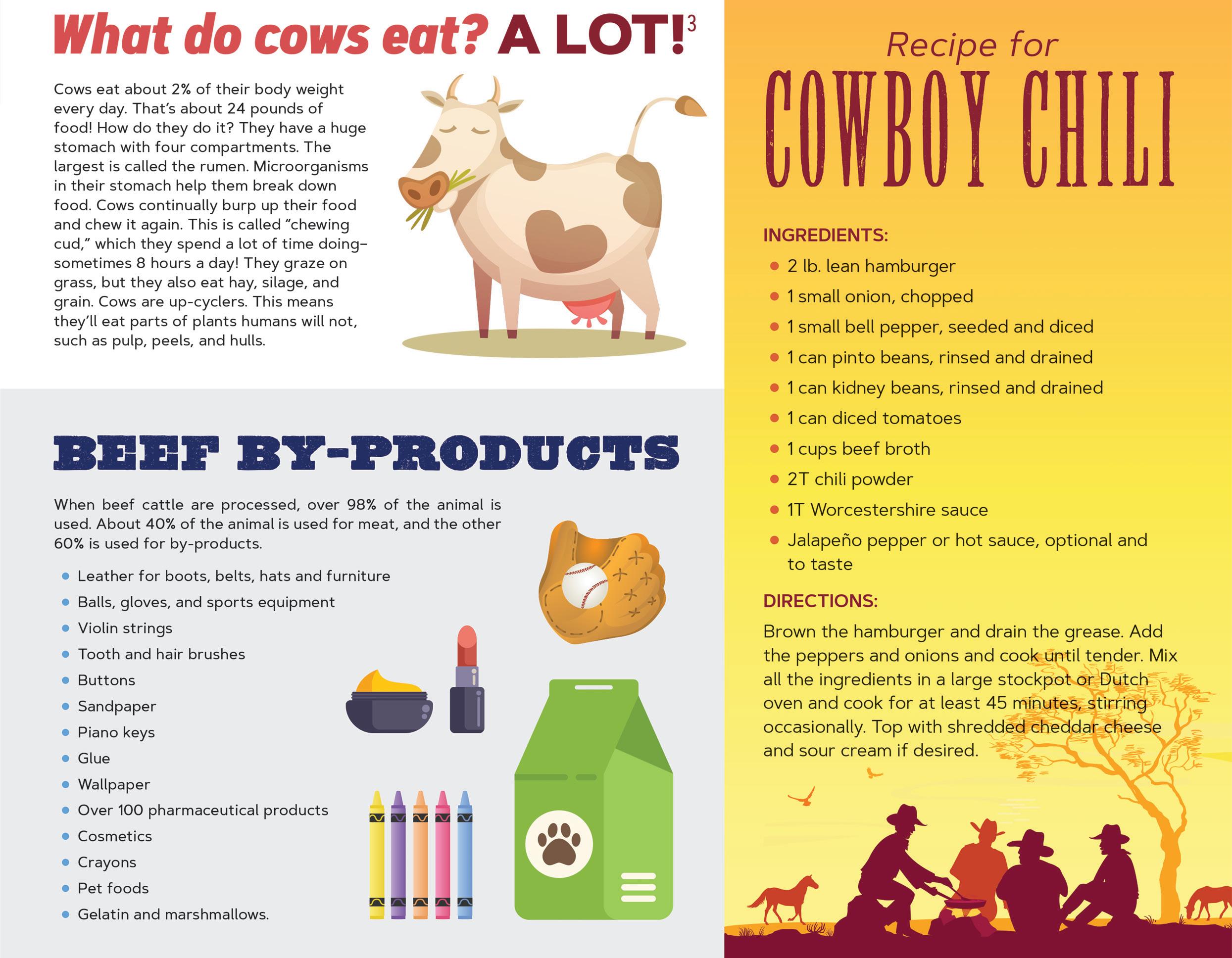
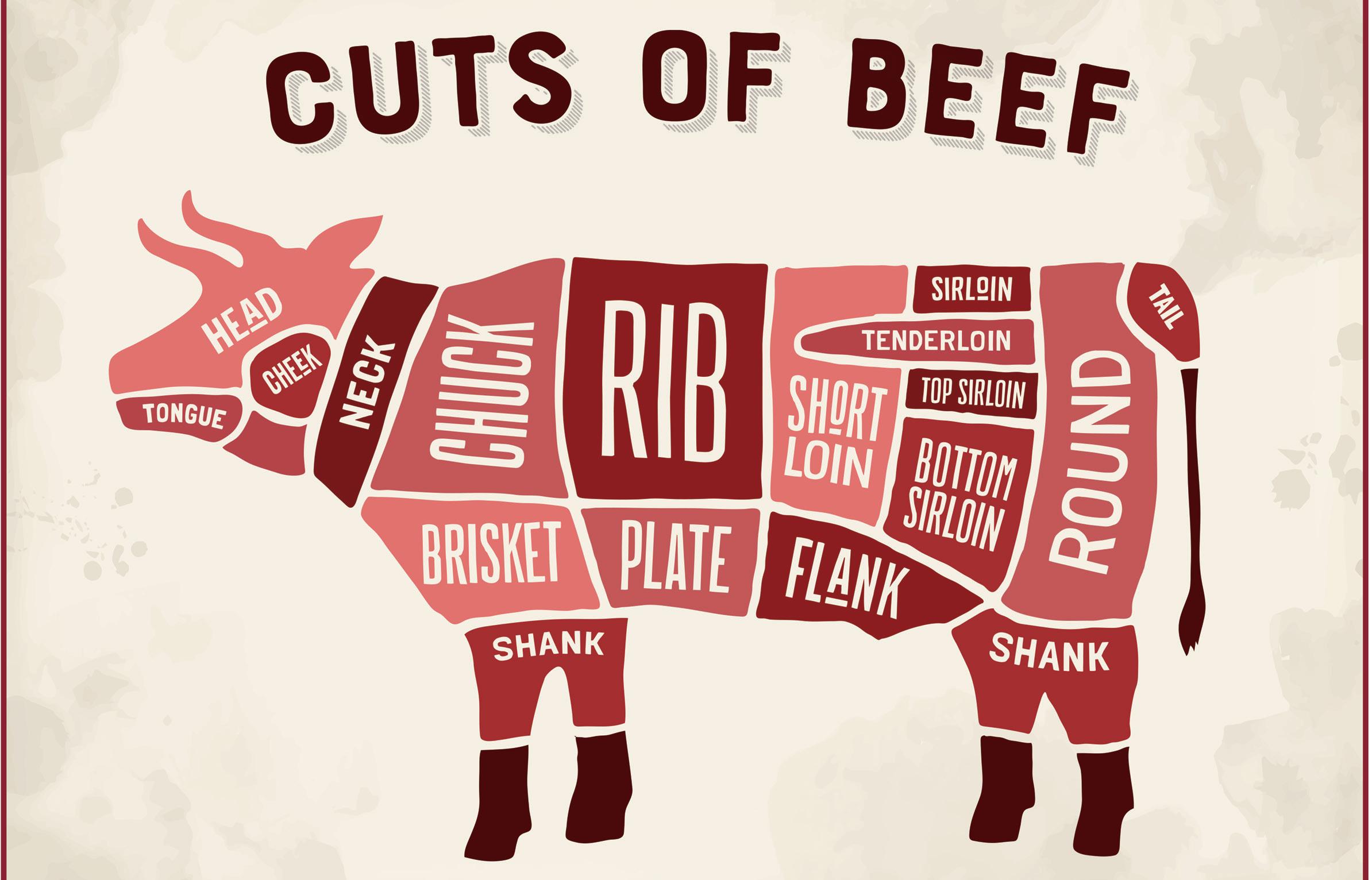

Expanded Hereford Feedout Program. The American Hereford Association (AHA) is expanding its popular Hereford Feedout Program to provide Hereford breeders and commercial users of Hereford genetics more opportunities to discover the feedlot and carcass performance of their genetics.
“Growing interest led us to expand from one feedout each year to two, beginning with the first fall program in 2023,” explains Trey Befort, AHA director of commercial programs. “The added feeding period enables us to accommodate producers’ whose calving and weaning seasons prevented them from participating as much as they wanted with a single feeding period.”
The Hereford Feedout Program offers producers an opportunity to send a few head or entire pens to HRC Feed Yards in Scott City, Kan., where the cattle are fed. Participants receive ongoing updates about how their cattle are performing while on feed. They then receive a collective summary of all cattle enrolled in the program to see how their cattle performed relative to the entire group.
Currently, 94 participants from 22 states are feeding more than 1,400 head of Hereford and Hereford influenced feeder cattle at HRC Feed Yards. The numbers encompass the Hereford Feedout Program* and the National Junior Hereford Association (NJHA) Fed Steer Shootout.**
“Every year, we see increased interest in these programs from our members and their customers because of the value they find in benchmarking feedlot and carcass performance in their programs and then tracking subsequent performance relative to their benchmark,” Befort says.
“These programs provide value to those who have never fed their cattle before and those who do so on a routine basis,”
explains Bill Goehring, Libertyville, Iowa, AHA president — a Hereford breeder, commercial cow/calf producer, and sale barn owner and manager. “These programs are a convenient, cost effective way for Hereford seedstock producers and their commercial customers to identify how their genetics perform in the feedlot and the packinghouse. The data also adds increasing accuracy to the breed’s genetic evaluation.”
Cattle from the Hereford Feedout Program are harvested by National Beef Packing Company, the licensed beef processor for Certified Hereford Beef (CHB). Cattle in the program are candidates for CHB and are marketed on the U.S. Premium Beef Grid, ultimately providing producers access to industry leading marketing options.
“Everyone involved in the beef industry has a role in feeding the world,” says Lee Mayo, HRC Feed Yards general manager. “If we can teach breeders and have them take ownership and responsibility for the end product, I am really excited to see the progress of the Hereford breed over the next 50 years.”
Those interested in the fall program are encouraged to enroll by May 1. Delivery to HRC Feed Yards will take place June 10–14. For more information, visit hereford.org/genetics/breedimprovement/feedout-program
*Hereford Feedout Program — participants enroll a minimum of five head of same sex (steer or heifer) cattle for feeding within a designated delivery period; participants can enroll whole pen groups outside the designated delivery period.

**NJHA Fed Steer Shootout — participants enroll individual steers or pens of three steers.
Even Leadership is Bigger in Texas as Hereford Juniors Build and Expand Their Skills. There were 21 National Junior Hereford Association (NJHA)
members selected to accompany six NJHA Board of Directors at the second Building On Leadership Development (BOLD) Conference, Desdemona, Tex., on March 23-26. This elite leadership retreat was hosted at Hi Point Ranch, owned by Gary and Kathy Buchholz of GKB Cattle.

The NJHA Board of Directors created BOLD for college aged junior Hereford members seeking opportunities to expand their leadership skills. BOLD is geared toward college and career focused junior members, providing them with a personalized learning experience focused on improving their leadership, providing career opportunities, and cultivating lifelong relationships.
“From the moment I got there, I was laughing and having fun with my peers, but I’ve also been challenged to think of what I want my future to look like and how to achieve it,” said Lauren Jones, BOLD conference attendee.
This conference has quickly become a new staple of the NJHA, as juniors leave empowered for their future. “While I always hope that our juniors take what they learn to heart and apply it to their daily lives, there is one thing I hope they remember: never compare yourself and your situation to those around you,” Tar Tut, NJHA Leadership Chair said. “During a roundtable with Terri Barber, Elanco Animal Health, she shared that comparison is the thief of joy. That struck a chord with me, and I hope our juniors continue to run their own race, at their own pace.”
Junior members spent the first evening participating in team building activities, as well as learning about Certified Hereford Beef (CHB). Representatives from CHB were there with the juniors and taught them how to cut their own steaks and prepare for proper grilling techniques. On day two, they were welcomed by Gary and Kathy Buchholz to Hi Point Ranch, followed by an inspirational message from keynote speaker Kelly Barnes and workshops designed and hosted by the NJHA Board of Directors leadership team. These sessions focused on who you are as a
leader, the type of leader you want to be, and the legacy you want to leave.
The final day started with panel conversations hosting different career professionals from GKB Cattle, Elanco Animal Health, Priefert, and the American Hereford Association (AHA). From there, juniors participated in mock interviews and resume reviews to help prepare them for their future careers. Tours of the different GKB Cattle operations were held on both days, exposing attendees to different aspects of the industry.
BOLD is an annual leadership opportunity and is scheduled for April 4–7, 2024. Junior members ages 14–22 looking to expand their leadership skills are invited to attend the 2023 Faces of Leadership Conference scheduled for July 23-26 in Columbus, Ohio. Registration will open in May.
About the National Junior Hereford Association. NJHA is one of the largest, strongest, and most active junior cattle programs in the country. Over the years, members of this association have gone on to earn international and domestic respect as models for youth organizational success. The NJHA, through its extensive educational programs, continues to lay the foundation for the beef industry’s future leaders. The traditions of the past, coupled with the energy of today’s board of directors, have created a progressive approach to further develop a meaningful and educational association focus.
About the American Hereford Association. AHA, with headquarters in Kansas City, Mo., is one of the largest U.S. beef breed associations. The not-for-profit organization, along with its subsidiaries — Certified Hereford Beef (CHB) LLC, Hereford Publications Inc. (HPI), and American Beef Records Association (ABRA) — provides programs and services for its members and their customers while promoting the Hereford breed and supporting education, youth, and research.
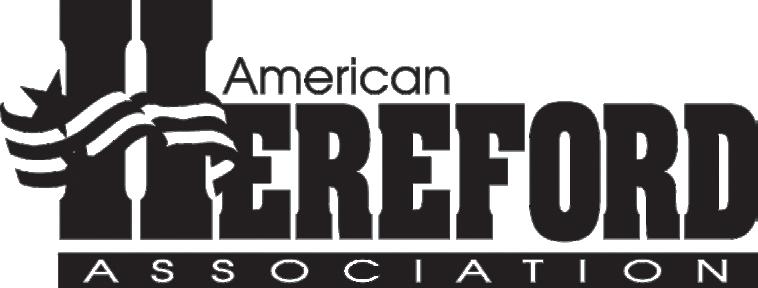
4B FARMS, LLC
Shelby, NC
Bryson, Wren, Beau, Belle, Bonnie & Bennet Westbrook 980-230-4868 brysonw@thewestbrookco.com

4K RANCH
Nelson, VA
Rick & Linda Kern 919-272-6124 4kranch@bellsouth.net
AWC CATTLE COMPANY
Winston-Salem, NC
Andie & Wes Carpenter 336-970-1655
jcarpenter@alphagraphics.com www.windmillacresfarms.com

BLINSON
POLLED HEREFORDS
Lenoir, NC
Keith & Peggy Blinson - 828-310-4526
Bryan & Beth Blinson - 919-422-9108
DOUBLE J FARM
Traphill, NC • Earlysville, VA John Wheeler 910-489-0024 doublejfarmllc@yahoo.com www.doublejfarmllc.com
FIVE J’S BEEF & CATTLE COMPANY
Clayton, NC Jody & Angela Standley
Kim Prestwood (Manager) 828-320-7317 - Kim jodystandley@gmail.com
GRASSY CREEK FARM
Bullock, NC Scott, Pam, Hailee, Lillee, & Elizabeth Bissett 919-482-1176 Bissettsp1@gmail.com
HEREFORD HILLS
Greensboro, NC
Bill Kirkman III 336-382-9635 ST Genetics Representative

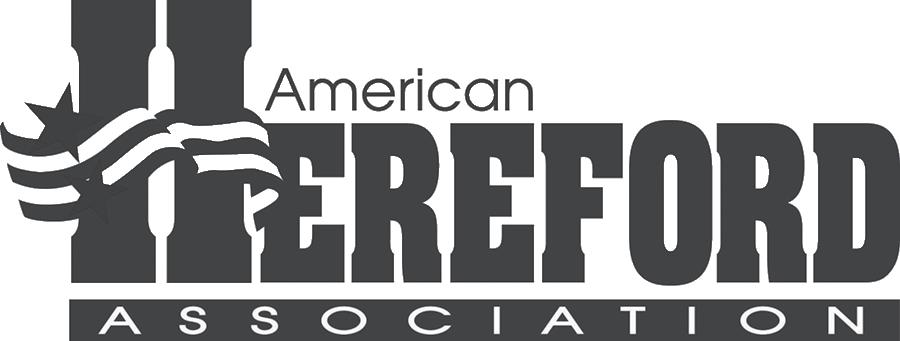

Classic
***NEW DATES for 2023***
May 12 - NCHA Annual Banquet
May 13 - N.C. Hereford Classic Sale

***NEW LOCATION***
Shuffler Farm Sale Facility
444 Union Grove Road • Union Grove, NC
N.C. Herefor d Juniors will be hosting a hamburger fundraiser before the sale - $10/plate.
LOOKABILL FAMILY LIVESTOCK
Lexington, NC
Reggie, Patty, Tyler & Noah Lookabill 336-240-2142 rlookabill6015@gmail.com
McCOY CATTLE FARM Cove City, NC Myron & Charlie McCoy 252-229-4602 mccoycattlefarms@gmail.com
MITCHEM’S FARM 3C Vale, NC Wayne, Crystal, Regan & Jordan Mitchem 704-472-4369 mitchemsfarm@bellsouth.net
NORTH PINO LAND & CATTLE COMPANY Mocksville, NC Kevin Robinson 336-940-2547 kevrob1@aol.com
P and J FARMS Monroe, NC Andy Smith 704-400-3436 pandjfarmsherefords@gmail.com
QUAIL RIDGE FARM Rutherfordton, NC Mark Brewer 828-329-2074 markbrewer65@gmail.com
TAYLOR’S MILL FARM Zebulon, NC J. Brent Creech 919-801-7561 tmfherefords@icloud.com
TERRACE FARM Lexington, NC Jim, Linda & Chad Davis 336-247-1554 jgdavis101@yahoo.com
TRIPLETT POLLED HEREFORDS Statesville, NC James Triplett 704-902-2250 triplettmarble@bellsouth.net
W&A HEREFORD FARM Providence, NC George, Tammy, William, & Andy Ward 434-251-3637 gwwardjr@comcast.net
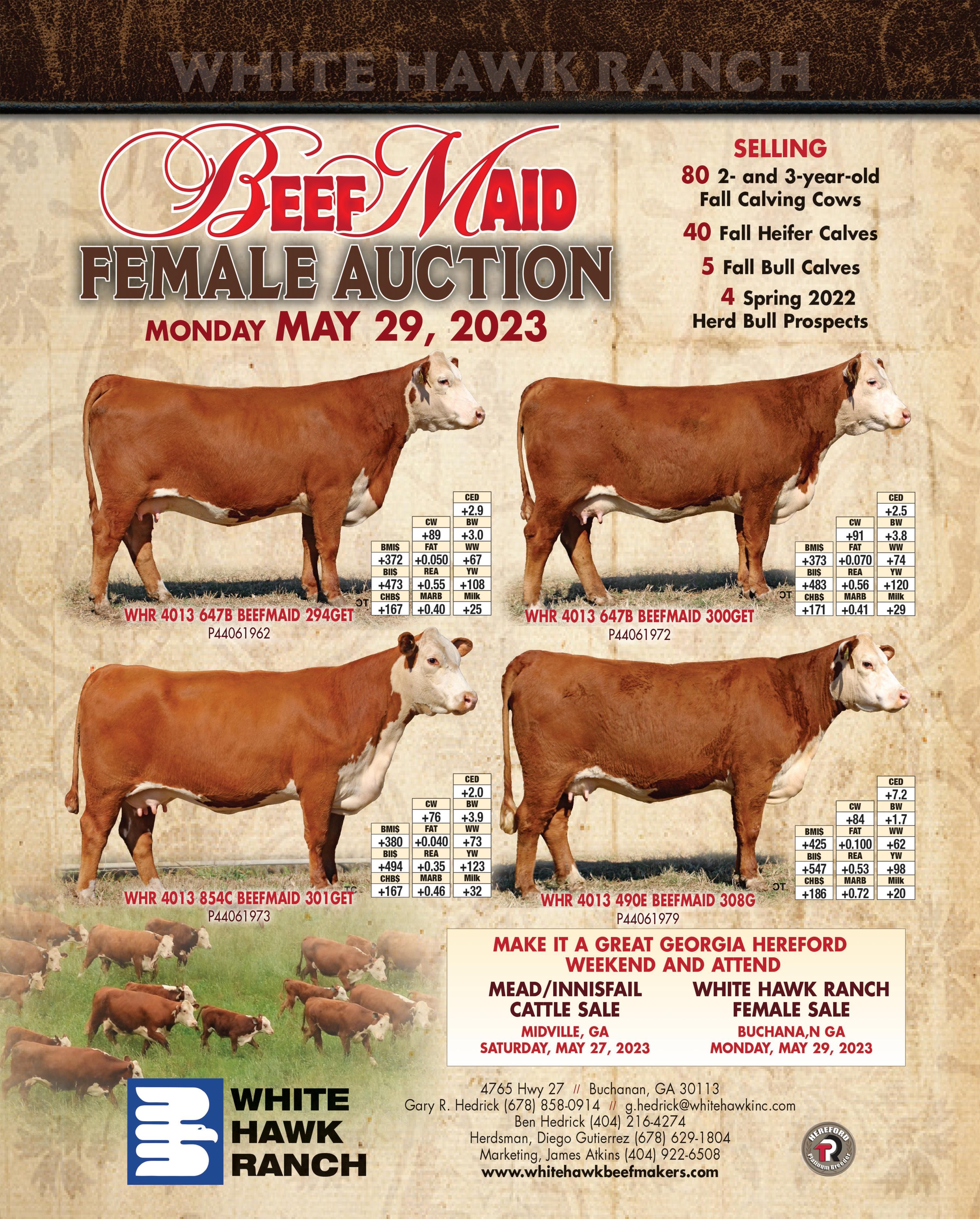


Grand Total 418
In 2007, the NCCA Membership Committee passed a resolution to recognize all NEW members, defined as someone who has never been a member or has rejoined after a break in membership, in The Carolina Cattle Connection. Below are NCCA’s new members for the last month:
Out-of-State
Robert Hoffman
– Roundstone Native Seed – Kentucky
Alamance County
Renee McPherson – McPherson Farms
Matthew Ross
Alexander County
Carson Gilleland – Rocking G Livestock
Ethan Sprinkle – Sprinkle Farm
Ashe County
Allison Brown – Quesenberry Farms
Beaufort County
Madison Boyd
Brunswick County
Pearly Vereen – Vereen Nursery
Buncombe County
Lily Aho
Coleman Amory-Pinkerton
Ellen Angelo
Michael Atkinson
Lucynda Ball
Cristina Baltenco
Eva Benne
Corie Bennett
Mila Blakeney
Emily Booth
Laney Branks
Kara Breedlove
Jamie Bryson
Kaia Chitwood-Rivers
Kennedy Cole
Brian Cortes-Arroyo
Kara Dodson
Christian Rangel Foxworth
Elijah Frisby – A.C. Reynolds High School
Mason Garey
Isaac Golden
Aiden Green
Ave Harmon
Ashton Hensley
Cassidy Hensley
Gabe Hensley
Makayla Nicole Hensley
Wyatt Hinker
Kaleigh Holdredge
Ethan Honeycutt
Ivy John
Addison Johnson
Emily Kuhl-Anderson
Dylan Lawson
Rebekah Lusk
Sara Manley – Goodson Farm
Kursten McCoy
Rowan McNabb-Friedmann
Bryson Mosemaw
Breon Newburn
Jack Nygaard
Kadence Penley
Amanda Powell
Alexis Ramsey
Luke Ramsey
Jaiden Reid
Ernesto Reyes
Ali Jo Rice
Peyton O. Rice
Kierra Ripley
Bianca Sophia Rodriguez
Mike Rossi
Clay Shook – C Bar Lazy S
Ryan Silver
Makenzie Smith
Addison Sprinkle
Nick Stone
Naomi Taylor
Jacob Tompkins
Brianna Treadway
Miya Waldrup
Keira Ward
Kayden Williams
Natalie Wilton
Cabarrus County
Christopher Conser
Jared Porter – Porter Farms
Caswell County
David A. Ross – Ross Farm
Catawba County
Jeff Dean – Deans Summit Farm
Gene A. Hollar
Andrew Rector– Naked Creek Cattle Co.
Chatham County
James Hodgeman II – JLR Cattle
Cleveland County
Elmore’s Feed & Seed Inc.
Justin Beam – Beam Livestock
Davidson County
Connie Jacobs – The Jacobs Family Farms
William Leatherman
Duplin County
John Bell
Jordan Brock – Jordan B. Watson
Durham County
Sierra Everhart – Menagerie Farms
Franklin County
Stephanie & Jason Hall – Happy Hen Farm
Graham Harris – Harris Brothers
Gaston County
Melvin & Suzanne Kiser – Kiser Farms
Carl Long III – The Farm at Crowders Creek
Granville County
David Melhado – Heartland Farm
Guilford County
Frank Meade – Friendly Farm
Halifax County
Cooper Aycock – Aycock Ag
Leroy Butts
Mike Cox
Cabot Crawley – Cabot Lee Crawley Farms
Bobby Isles – Islea Farms
Bryan Isles – BSI Farms
Charlene Jones
Justin Taylor Pike – JTP Farms LLC
Charles Ray Vaughan Jr. – BSI Farms
Joseph Zachary White – Fitts Farm
Harnett County
Tanner Rhyne – R&B Farms
Iredell County
Shane & Renee Hill
Austin Rash
Bill Walker
Johnston County
Scott Barbour – Du-Bar Ranch
Kaylee Gabriel
Gary Price
James T. Vinson
Lee County B & B Farms
Thomas Cameron – Cameron Family Farm
Moore County
Dr. Beau Cooksey – Baldwin Family Farms
Northampton County
Robert L. Jones Jr.
Perquimans County
A. Willis Proctor
Person County
Williams Farms of Denny Store
Pitt County
Josh Coward – Coward Cattle Co.
Randolph County
Jason Austin – Austin Farms
Rockingham County
Kylie Akers
Giovanni Alvarez
Hannah Boyd
Hadyn Cummings
Max Daniels
Samuel Daniels
Emma Davis
Shayne Dickerson
Carley Fain
Caleb Forsell
Jala Hairston
Karson Hill
Nathaniel Huffman
Abby Julian
Aaliyah Kirby
Lauren Montgomery
Delylah Morton
Aries Ortiz
Hayden Pinnix
Scott Riley Purgason
Autumn Robinson
Aiden Self
Wesley Elliott Sharp – Wamees Farm
Kylee Talbott
Kiersten West
Rowan County
Shane Manuel
Rutherford County
Richard Dee Cole
Robert G. Moore – Laurel Creek Farm
Sampson County
Dustin Johnson – Dustin Johnson Farms
Christopher White – McCullen Livestock
Stokes County
Kevin Jones – Jones Family Farm
Surry County
James W. Gilley
Mike A. Johnson
Transylvania County
Jerry Pridmore – Laurel Creek Farm
Union County
Heather Christenberry & James Clontz – The Crown Jewel Farm
Trent Hinson
Wake County
Sabryna Gromley
Ilena Hall
Watauga County
Joe McNeil
Wayne County
Sabrina Blackmon
Wilkes County
Kent McNeil
Wilson County
Beverly Boyette – Boyette Acres
Rob Boyette – Boyette Acres
Emma Vick
The three pronged approach to beef sustainability — environmental, economic, and social — often focuses most on the pillar of environmental stewardship. In the beef industry, much attention is given to the environmental impacts associated with beef production practices. However, highlighting the benefits that beef production can impart to the ecosystem can help the industry develop a more complete picture of beef’s environmental footprint.
Many companies have set environmental sustainability goals that project a targeted reduction in their carbon emissions. In order to reach these goals, the practice of purchasing carbon credits from suppliers to help offset emissions through a carbon marketplace is becoming more common and popular.
What are carbon credits? Carbon credits are permits that each represent one metric ton of carbon dioxide (CO2) or the equivalent amount (CO2 eq) of a different greenhouse gas (GHG) that is removed from the atmosphere.
The term “carbon offset” is commonly interchanged with the phrase “carbon credit,” but they vary slightly in meaning. Carbon offsetting is the purchase of carbon credits to compensate for emissions that have been created by a business or lifestyle. A carbon offset is a reduction in GHG emissions that compensates for emissions occurring elsewhere in the supply chain.

Each GHG has a different global warming potential (GWP), which allows for comparisons to be made between the global warming impacts of various gases relative to CO2. The GWP measures how much energy the emissions of one ton of a GHG will absorb over a given time frame (i.e., 100 years) in relation to one ton of CO2 (EPA, 2022)
According to the Intergovernmental Panel on Climate Change (IPCC,2021):
• Methane (CH4) has a GWP of 27–30 times higher than CO2 over a 100 year timescale
• Nitrous oxide (N 2O) has a GWP 273 times higher than CO2 over a 100 year timescale
The average American generates 16 metric tons of CO 2 eq annually, which is enough to fill more than three and a half Olympic sized swimming pools (Tso, 2020). These emissions come from driving cars, utilizing electricity and gas in homes, food systems, and other day-today activities.
What are carbon markets? Carbon markets are economic trading systems that support the buying and selling of carbon credits. Carbon markets provide monetary incentives for credit producers to adopt approved carbon reducing practices, while credit purchasers utilize the offsets to reach their carbon emission goals.
Carbon markets can be split into two categories: compliance and voluntary.
Compliance markets - Carbon markets are created as the result of regulatory requirements or national, regional, or international policies.
Cap-and-trade systems are traditional examples of mandatory programs in which regulated businesses are issued GHG emission allowances or permits that add up to a total maximum or a capped amount. Companies that exceed their permitted emissions allowance must buy permits from others with available permits for sale, or they will face penalties (UNDP, 2022) . Carbon offsets may be used as a compliance option for some regulated entities (Stubbs et al., 2021)
In the U.S., California is the only state with a cap-and-trade market, which was established in 2013 and targets the state’s electric power plants, industrial plants, and fuel distributors. The state has a goal of lowering its emissions below the levels seen in 1990 by 2030. Entities that are required to comply with California’s program can use offsets to satisfy four percent of their obligation, which includes agricultural offsets from livestock manure management projects, rice cultivation projects, and forest management projects (Stubbs et al., 2021)
The European Union launched the first international cap-and-trade or emissions trading system (ETS) in 2005. In 2021, China launched the world’s largest ETS, leading the way for the development of other national and subnational ETS (UNDP, 2022)
Voluntary markets - Currently, most carbon market programs are voluntary markets, which include the buying and selling of carbon credits on a voluntary basis outside of a regulatory framework (e.g., corporate sustainability reporting).
Transactions involving credits can occur directly between participants and buyers or can be mediated by other parties or programs. Sellers of carbon credits are typically farmers and ranchers, and they are paid for generating carbon credits by adopting management practices that meet specific criteria for carbon emissions reduction or sequestration (e.g., no-till,


cover crops, crop rotation, anaerobic digesters, grazing management, manure management, reforestation, etc.). Sellers are usually paid on a per-acre or per-ton basis of carbon sequestered (Shockley and Snell, 2021) . The monetary compensation for carbon credits varies widely based on the practice and program, averaging between $10–20 per credit (Stubbs et al., 2021).
There are a handful of voluntary carbon markets in operation, including programs established by Bayer, Ecosystem Services Market Consortium, Nori, Verra, Gold Standard, and several others. Since voluntary markets remain unchecked by regulators and do not have caps on how many tons of emissions can be offset, there are several organizations that set standards and that validate carbon credits based on those standards. Verra, for example, has set a widely used carbon credit validation standard — called Verified Carbon Standard — that is based
on accounting methodologies specific to the project type, independent auditing, and a registry system (Thompson and Miranda, 2021) . Other programs, such as Nori, follow a similar process using practices that qualify under their methodology and a third party verifier. The eligibility for voluntary programs, approved practices, verification processes, and compensation of these voluntary markets differ widely.
The voluntary carbon market options for agriculture continue to emerge and evolve, and pilot projects and reduction practices continue to be assessed. There is much to learn about carbon sequestration, monetizing production practices based on GHG emissions reductions, and accurately measuring carbon emissions from different industry sectors. As many programs currently focus on crop and forest production practices, there is room for beef production practices to enter the market.
Proper nutrition through all stages of gestation is vital not only for the dam but for the developing calf. Knowing the when and how of utilizing trace minerals will give your calves the head start they need in life.
Building a strong foundation in the cow herd, heifer development, or purebred program starts with genetics but can also be affected by management and nutrition. Reproductive failures are often tied to suboptimal nutrition and can impact not only the individual animal but their offspring’s well being too. This is referred to as maternal or fetal programming and pertains to the impact of the nutritional and health status of the mother during pregnancy and the subsequent impact on the health and productivity of her calf.
Fetal programming - Maternal nutrition can impact the fetus and
potentially alter development, not just in utero but later in life as well. Compromised nutrition during gestation can result in low birth weight, increased pre-weaning mortalities, and poor growth rates. When we talk about maternal nutrition, the focus has traditionally been on the last trimester of gestation since this is the time period when the fetus grows more rapidly, taxing the cow’s energy and mineral reserves. Therefore, we see most nutritional strategies built around that 90 or even 60 days prior to calving. But what about the impact of maternal nutrition during early and midgestation?
A recent publication discussed the importance of proper nutrition throughout all phases of gestation, and the impact nutrition can have beyond just looking at pregnancy percentages. In another study where early gestation cows were fed either 100 percent or 55 percent of
their nutrient requirements, there were no differences between calf body weight and gain, but lung and trachea weights of calves born to nutrient restricted dams were significantly less, which can potentially impact how these calves would react to respiratory challenges.
Nutrient restriction during midgestation has also been shown to impact ovary and luteal tissue size and mass, which can directly impact the heifer’s reproductive efficiency later in life. The nutritional status of the cow during late gestation (six to nine months) has been shown to impact calf muscle fiber formation, which can impact birth weight, weaning weight, and even carcass weight at harvest.
Reproductive performance in ruminants is highly dependent on their nutritional status. Trace minerals, especially, are involved in the synthesis of reproductive hormones, reduction
of free radicals, improvement of the uterine microenvironment for embryonic implantation, and fetal growth and development. Considering that reproductive organs develop for the most part during early gestation, it is easy to see just how much of an impact the dam’s nutritional and especially trace mineral status can have on fetal development and future performance.
Need for trace mineral supplementation - Feeds and forages vary in trace mineral concentration. (Variations exist among species and seasonally.)
Supplemental copper, zinc, manganese, and selenium are needed to optimize the herd’s trace mineral status, which is fundamental for immunity, health, reproductive efficiency, and growth.
Supplemental trace minerals are thus provided to bridge the gap between the amount available through forages and the

cow’s nutritional requirements. Still, forms of trace minerals (inorganic or organic) used to supplement can have a significant impact on how the herd responds to the chosen trace mineral program.
Inorganic versus organic - Inorganic trace minerals (including sulfates, oxides, chlorides, and hydroxides) are typically inexpensive byproducts of other industrial processes and are often fed in excess to avoid deficiencies. However, with lower relative bioavailability, animals do not necessarily benefit from over supplementation. These high levels of inorganic trace minerals are often linked to mineral-to-mineral antagonisms (which can lead to mineral imbalances), higher degree of vitamin degradation, and higher levels of excretion into the environment.
Organic trace minerals (for example, proteinates and selenium yeast) are closer to the natural form in which animals would find trace minerals in nature; we, therefore, see better absorption and utilization, which means higher bioavailability and fewer dietary interactions so that organic trace minerals can typically be supplemented at lower levels.
Benefits of organic trace minerals - Advantages of organic trace minerals have been well documented and include reduced days to first service, fewer days open and increased pregnancy rates, fewer days open and fewer services, improved ovarian activity, earlier estrus and conception, and decreased embryonic mortality.
This comes as no surprise given the impact trace mineral source can have not only on overall trace mineral status but on gene expressions linked to reproductive performance as well, as
demonstrated in a nutrigenomics study when comparing proteinated organic trace minerals to inorganic sources. In that study, researchers evaluated the effect of replacing inorganic trace minerals with organic (proteinated trace minerals and selenium yeast) on gene expression levels in replacement heifers. Results indicated that trace mineral source impacted 580 differentially expressed genes related to reproductive performance, including dendritic cell maturation, relaxin hormone signaling, Gaq signaling, the function of smooth muscle tissues, and thrombin signaling, all of which play essential roles in early pregnancy, indicating that organic trace mineral supplementation can potentially benefit reproductive performance, including improved regulation of the estrous cycle, shorter calving intervals, and improved implantation rates.
So how do organic trace minerals affect fertility parameters in successive generations? In a recent beef study, the response of Angus and Brangus cows and their calves to either inorganic (ING) or organic (ORG) trace mineral sources was evaluated. For cows supplemented with ORG 90 days pre-calving throughout heifer developmental period (year one), heifer calves reached puberty nine days earlier and were confirmed pregnant eight days earlier than heifers from the ING supplemented cows.
The results for year two, where cows were supplemented for the entire year, and calves were thus exposed to ORG supplementation from conception throughout the heifer development period (year two), the heifers from cows supplemented with ORG reached puberty 41 days earlier and were confirmed
pregnant 18 days earlier than heifers from ING supplemented cows.
Trace mineral source and supplementation have thus had a direct effect on fertility parameters in successive generations (i.e., fetal programming effect). Year round supplementation with a high quality trace mineral program can have a tremendous impact on both the individual animal and her female offspring’s reproductive efficiency as measured by age at puberty, age at calving, and lifetime performance.
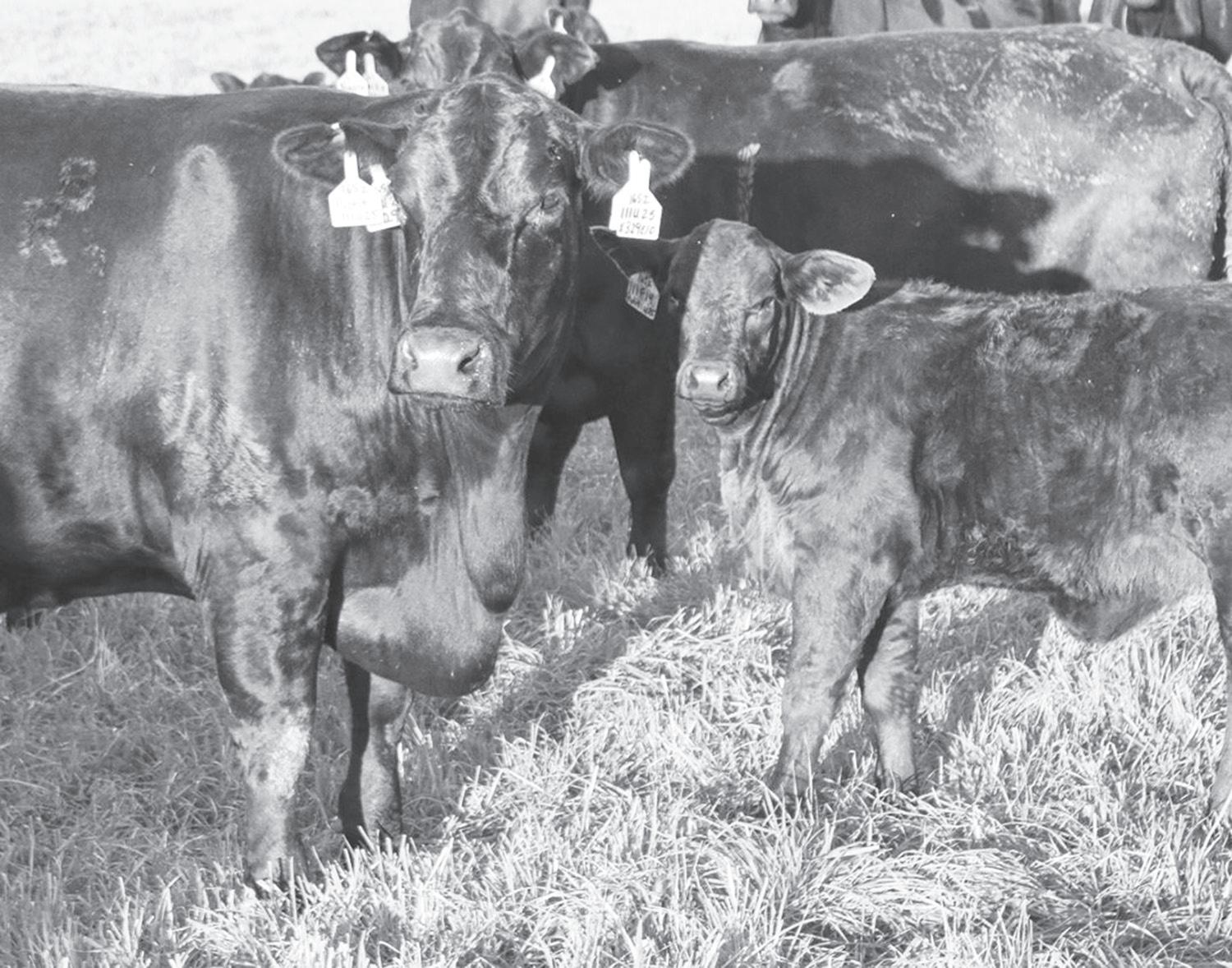
Optimizing trace mineral status and reproductive efficiency is especially important in purebred herds and operations focusing on embryos: When looking at follicular dynamics and embryo quality in beef cows, researchers have reported that supplementation with organic trace minerals results not only in increased diameter of ovulatory follicles but also leads to improved in-vitro maturation and embryo cleavage. This is
significant, as early embryo cleavage is a strong biological indicator of embryo potential and is often used as a measure of embryo quality.
Implications - Organic trace minerals, especially in the proteinated form, can thus potentially benefit reproductive performance, including improved regulation of the estrus cycle, shorter calving intervals, and improved implantation rates, as well as reproductive efficiency in successive generations. When developing one’s own or acquiring replacement females, emphasis should thus not only be on genetics but nutritional predisposition should also be taken into consideration. Given the potential return on investment associated with organic trace minerals in terms of health, reproductive efficiency, and gains, year round supplementation is not only an economically feasible choice but one that impacts future performance and profitability directly.
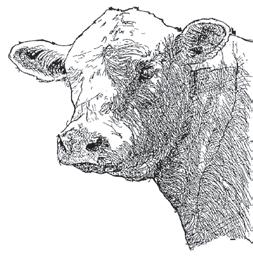
I will start off with the bad news first. Mike King passed away on March 25. The family has sold all his cattle, so Nubbin Ridge Charolais is no longer in business. We will all miss Mike, as he was in the Charolais business for many, many years. Please keep his family in your prayers.
I hope you were able to attend the Appalachian Classic sale in Knoxville, Tennessee. Right now, we are all busy getting cattle ready for the sale, but when you read this, it will be all over with.
If you are down this way, stop in and see the new member of Webb Charolais. Lot 54, which I named Atomic Mass, will be here for all to see. He will be arriving from DeBruycker Charolais as soon as it stops snowing there. I learned a lot from this sale. I learned to cast my phone to
the big screen TV, and we watched the sale in the comfort of the TV room. Lots of people wanted my bull, but Dennis Adams was able to outbid them. After the sale, I learned how to send a wire transfer to pay for him. I had never done either of those things, so it was a real learning experience. Never think old people won’t figure out these new technical things to do. We are never too old to learn. I will post a picture of the new member of the farm when he gets here.
I had a great phone conversation with Clint Rusk at the AICA. If you ever need a question answered, give him a call.
Not much else is going on except Wayne Bennett just got back from Ireland. He has got some funny stories, so if you see him or talk to him on the phone, ask him about the trip.

You shouldn’t have to have a gun held to your head to take advantage of the expert A.I., superior genetics, the best in purebreds and outstanding farm supplies featured in the Classifieds in this issue!
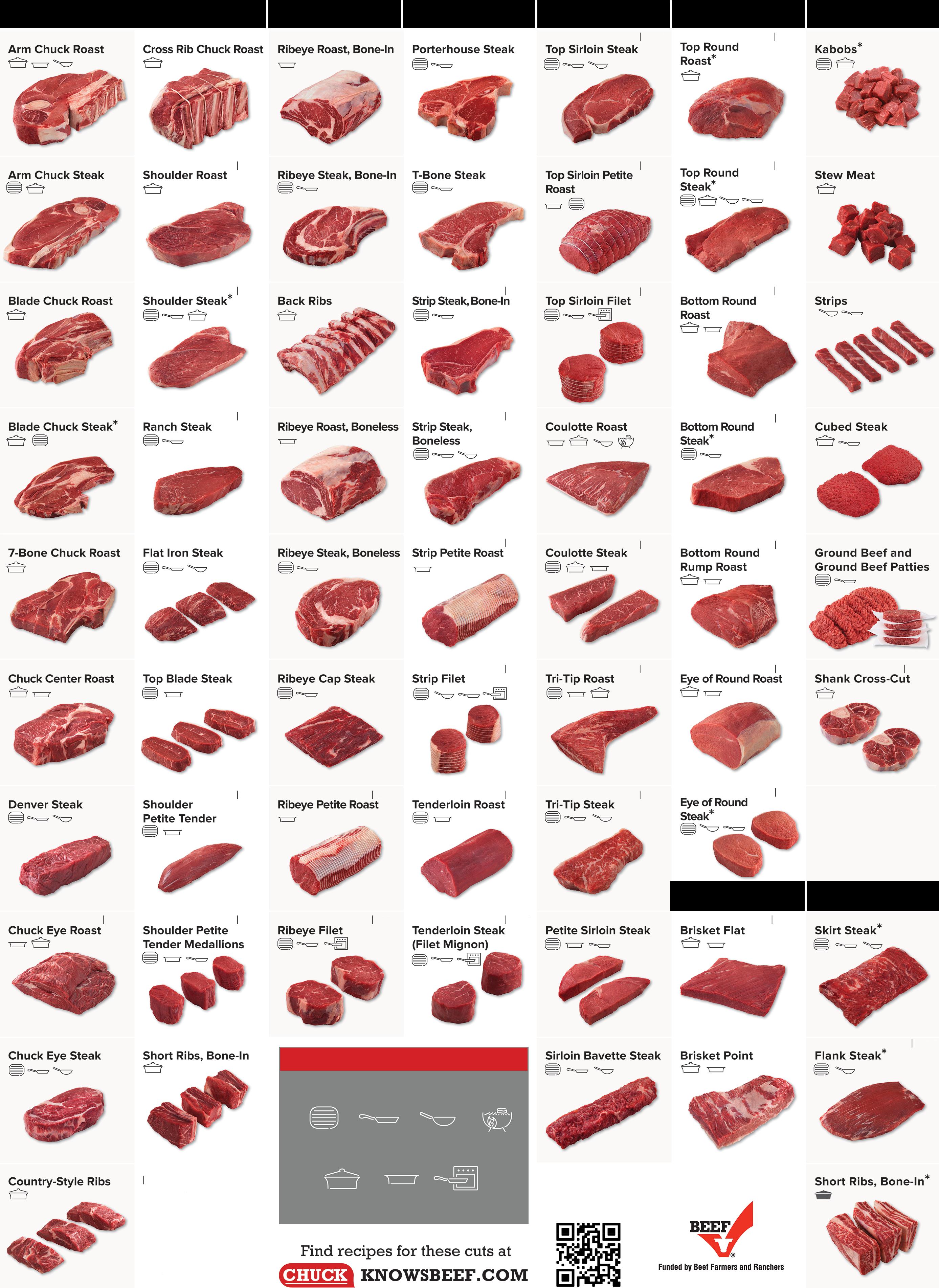

My family has been farming and ranching outside of Corinne, Utah, since 1900 – that’s 123 years when you do the math. Today, J.Y. Ferry & Son, Inc. is a farming, feeding, ranching, and wetlands/ wildlife operation. My brother Ben, my son Joel, and I jointly manage our land resources with a cooperative and sustainable approach.
Holistic synergy is what we seek on a daily basis. We’ve always believed that the land itself is the greatest resource any farming or ranching operation has. And as a member of the Cattlemen’s Beef Board (CBB) and co-chair of the Beef Checkoff’s Consumer Trust Committee, I know that consumers are very concerned with beef’s environmental impact. As a beef producer, I also know I must do my part to let those consumers know how much we care about our land, our animals, and our environmental responsibility.
Our property is literally where agriculture, wetlands, and wildlife habitat proactively intersect. We farm and graze our cattle on a 150,000 acre footprint. Our cattle feed on phragmites, a locally invasive wetlands plant. The grazing in wetlands helps manage the plant’s population and prevents it from crowding out other beneficial plant life that is so critical to wetland wildlife. The cows are eating these plants, which are inedible to humans, and turning them into high quality beef. Furthermore, the grazing strategy brings the phragmites spread under control without the use of expensive chemical sprays.
We’ve also taken numerous measures to improve water efficiency throughout our operation. We do everything we can to be sustainable – something people who buy all their food at the supermarket don’t always have the opportunity to see. And I’m certainly not the only beef producer who takes these types of measures.
The Checkoff funded Meat Demand Monitor surveys 2,000 people monthly on their meat preferences and views. Taste, freshness, price, and safety remain consumers’ most important considerations when purchasing proteins. And while the climate positive trend is a movement
that beef producers like me know all too well, these are the true factors consumers continue to find more important than beef’s environmental impact. Still, the Beef Checkoff is committed to providing education and correcting misinformation about beef and the environment while gaining consumers’ confidence.
The first step is investing in extensive, science backed research. The Beef Checkoff continuously funds third party, objective research projects that prove the beef industry’s environmental responsibility. Through this research, we can provide science validated sustainability indicators that benchmark the industry’s current status and provide a path forward toward continuous improvement. By taking an objective, scientific approach, this program helps create a sustainable beef product for a growing world population while also building consumer confidence in beef.
From there, we try to stay ahead of issues that impact consumer perceptions through a two pronged effort of education and outreach. Our ultimate goal is to connect and engage with people before false or misguided information about beef production practices spreads. Then, we can share the facts that our research has uncovered. Here are just a few examples of what we’ve been doing to educate and inform others about beef production:
Developing educational units for middle and high schools - By connecting with young minds, the Checkoff can educate tomorrow’s beef consumers today. Educational units focus specifically on greenhouse gases and cattle, as well as general beef production and genetics.
Hosting On The Farm STEM events - The Beef Checkoff funds annual educator immersion events designed to bring inner city teachers to real, working farms to learn about beef production. In 2022, the educators who participated in the tour shared their experiences with more than 70,000 urban students.
Taking part in New York City Climate Week - Beef was front and center in September 2022 during Climate Week, the largest global climate event.
Checkoff funded Beef. It’s What’s For Dinner. hosted a webinar on beef being an ultimate climate smart food and shared the truth behind emissions.
Collaborating with the Beef Expert Network - The 22 influencers who make up the Checkoff’s Beef Expert Network are all passionate about sharing beef’s story and connecting with their audiences to address misinformation surrounding beef.
Sharing information via digital campaigns - Checkoff funded digital campaigns on Connect TV, YouTube, websites, and social platforms encourage consumers to “rethink the ranch.” Real beef producers share their beef stories and how they care for their cattle and land.
Most cattle operations are far removed from the mainstream of today’s society. We, producers, are most comfortable on our ranches and farms doing what we do best, supporting our livelihoods and our families as we feed the world. But as full time environmentalists, we must speak up when it comes to topics like beef’s impact on land, water, and air. Unless we share our own true stories, others will control the narrative. First and foremost, we must take extreme care of our land and our cattle. Then, it’s our responsibility to tell others about our efforts. Learn more about facts about beef and the environment at beefresearch.org
Deere supports new documentary film “Odd Hours, No Pay, Cool Hat.” Film highlights diverse stories of rural volunteer firefighters. John Deere and the National Volunteer Fire Council (NVFC) have joined forces to support the new documentary film “Odd Hours, No Pay, Cool Hat.”
The film highlights diverse stories of rural volunteer firefighters from across the country and paints a portrait of these brave individuals who serve their communities. The film will soon be released nationally, and producers hope those who watch it will be inspired to sign up to be volunteer firefighters through the NVFC’s “Make Me a Firefighter” campaign.
Film trailer:
• Exeter Nebraska Sneak Peek (vimeo.com/818625191/0f83aa19ab)
Film teasers:
• How do you keep a town alive (vimeo.com/809989447/26edcb78a9)
• Turn someone’s day right side up (vimeo.com/809989495/d49f74094c)
• Chew gum and walk (vimeo.com/809989535/5dc9564869)
Of the 1.1 million firefighters in the U.S. today, more than 700,000 are volunteers who provide a vital service to rural communities across the country. These volunteers answer the call and are among the first responders to arrive on the scene of grain bin and other structure fires, brush fires, vehicle accidents, hazardous chemical spills, and other accidents.
Many volunteers are farmers, ranchers, contractors, loggers, John Deere
employees, or John Deere dealership employees. Nate Clark, global director for corporate social responsibility at John Deere and president of the John Deere Foundation, said John Deere employees recorded more than 13,000 hours in 2022 volunteering as firefighters and emergency responders.
“John Deere and our employees recognize the importance of volunteer firefighters and emergency responders in communities across the country,” Clark said. “Some of the individuals featured in the film are John Deere customers and many John Deere dealers provided financial support for the film’s distribution. All John Deere dealers will be able to use the film free of charge to help local recruitment efforts of volunteer firefighters.”
For more information, visit www. JohnDeere.com or contact your local John Deere dealer.
About John Deere. Deere & Company is a global leader in the delivery of agricultural, turf, construction, and forestry equipment. We help our customers push the boundaries of what’s possible in ways that are more productive and sustainable to help life leap forward. Our technology enabled products, including John Deere Autonomous 8R Tractor, See & Spray™, and E-Power Backhoe, are just some of the ways we help meet the world’s increasing need for food, shelter, and infrastructure. Deere & Company also provides financial services through John Deere Financial.
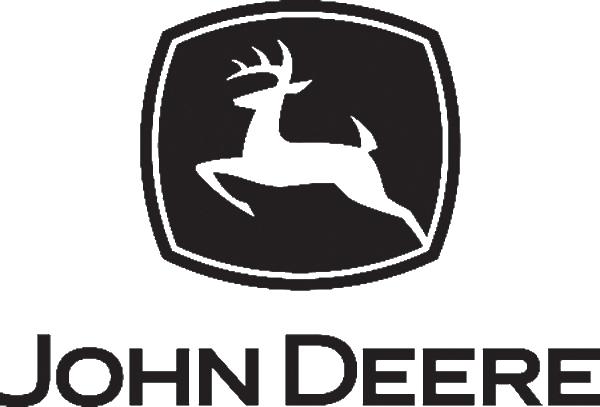
Two Veterinarians Discuss GFI No. 263. The U.S. Food and Drug Administration (FDA) Guidance for Industry (GFI) No. 263 goes into effect in June 2023, transitioning 91 livestock antibiotics, previously available over the counter (OTC), to prescription status. Some manufacturers may transition before this timeframe; thus, to help producers get ahead of the changes to come, Valley Vet Supply Technical Service Veterinarians Lacey Fahrmeier, DVM, and Tony Hawkins, DVM, joined in conversation to help producers navigate the changes ahead.
Understanding GFI NO. 263
Dr. Hawkins - “GFI No. 263 provides guidance for the manufacturers of these antibiotics currently considered OTC. When we say ‘OTC,’ that means you do not need a prescription from a veterinarian to buy it. With GFI No. 263,
those over-the-counter antibiotics are transitioning to a prescription status, and there is a long list of antibiotics that are affected.”
Dr. Fahrmeier - “The intent of this guidance is to try to maintain those antibiotics that are important for human medicine use from being used incorrectly and having microbes develop resistance to those antibiotics. The FDA didn’t do it out of spite or to make things more inconvenient for people. In a lot of ways, I think some good could come out of this guidance.”
Affected Medications
Dr. Fahrmeier - “In general, GFI No. 263 is affecting the injectable OTC antibiotics that livestock producers typically use – those including gentamicin, lincomycin, oxytetracycline, and penicillin, as well as the oral drugs like sulfamethazine and tylosin, among
others.”
Dr. Hawkins - “Your bolus type of medications, like sustained release boluses and tetracycline boluses – very common medications people are used to buying OTC – and mastitis medications, including tubes that you infuse into the mammary glands – are also going to be prescription status.”
Common Misconceptions
Dr. Fahrmeier - “One of the misconceptions is that producers will have to buy medications straight from the veterinarian. They won’t have to buy these antibiotics from their veterinarian, but they will need a valid veterinarianclient-patient relationship (VCPR), and prescription, to purchase them.
The new Guidance does not affect your parasiticides. At this point in time, only antimicrobials are affected.”
Dr. Hawkins - “Vaccines are also not included in this Guidance so they will remain OTC right now. I don’t foresee vaccines and dewormers becoming prescription status. I think that would be too crippling for the industry.”
Dr. Fahrmeier - “There is a misconception out there that medications are going to be restricted, as far as how
much you can buy. Medications will still be very accessible – it’s just going to require that prescription, so you’re going to need a valid VCPR. Don’t panic, because you will still have full access to the medications that you need; it’s just going to require a couple more steps.”
Meaning and Value of a VCPR
Dr. Hawkins - “A VCPR means you, as a producer (and your patients, being your animals), have a current relationship established with your veterinarian. One question I’ve received from my clients is, ‘Does this mean you’re going to have to come out and examine every patient before I can give an injection of antibiotics?’ Typically, it’s understood that an examination or farm visit within the last 12 months is what constitutes as a current VCPR. Speak with your veterinarian about what he or she might require to maintain that VCPR.
If you do not have a veterinarian, or a relationship with a veterinarian, now is the time to start working on that. Find a veterinarian in your area that you’re comfortable with and start building that relationship, getting those farm visits so that there is that valid VCPR. Don’t wait until you need an antibiotic injection right
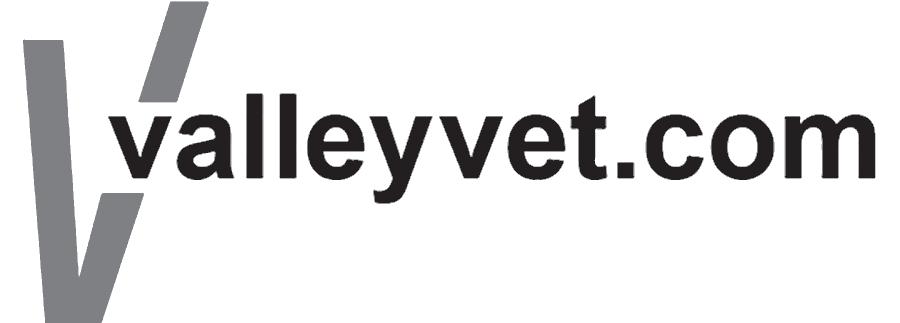
HARDROCK BEEF CATTLE
Ronnie & Donna Holman 4613 Hickory Nut Ridge Road • Granite Falls, NC 828-302-8659 ronnie@hardrockbeefcattle.com
JK RED ANGUS
Jeff Banfield & Madison Adams 331 Tee Jay Farm Road • Aberdeen, NC 910-315-3821 jkredangus@gmail.com
LANGDON RED ANGUS & SIMMENTAL John & Eileen Langdon 7728 Raleigh Road • Benson, NC 919-796-5010 johnlangdon5@gmail.com
ROGERS CATTLE COMPANY
Johnny & Sharon Rogers 945 Woodsdale Road • Roxboro, NC 336-504-7268 rccbeef@gmail.com
PRESNELL RED ANGUS
Jonathan & Jacob Presnell 368 Whitaker Road • Shelby, NC 704-473-2627 (Jonathan) • 704-616-8775 (Jacob)
BULL HILL RANCH
Jim & Alvina Meeks • Raymond Prescott, Manager 1986 Trinity Church Road • Gray Court, SC 864-682-3900 • 864-682-2828 bullhill2@mindspring.com
COUNTRY BOY FARMS
Contact these RAAC members to learn more about Red Angus genetics and how they can fit into your herd. Cole
David Miller 316 Key Road • Edgefield, SC 706-840-3709

now to then call that veterinarian and say, ‘Can you get it to me?’ Their hands are probably going to be tied. It’s not that they don’t want to help you, but they legally can’t without a VCPR.”
Dr. Fahrmeier - “Getting on that veterinarian’s list for a farm call – if you don’t feel like you have a strong relationship with a veterinarian in your area currently – is a great idea. Because there are fewer of us mixed practice veterinarians in the country, we’re covering a bigger and bigger radius all the time. Right now, with everything happening in spring for a mixed practitioner, including calving season, bull testing, and more, it may be three weeks before they can make a farm visit to get a working knowledge of your operation and the challenges that you’re facing so that they can make the best recommendations possible.
I don’t think you should look at the VCPR requirement as a negative but more as an opportunity to make some improvements in your operation and as another set of eyes. When we have those good conversations about what issues you are having and the medications you need, that leads to more productive conversations, such as maybe if you just changed a simple management practice or something in your herd health protocol as far as vaccines go, you might mitigate the need for antibiotics completely and really reduce your morbidity and costs involved. You may find out that just by describing the clinical signs of the animal you’re wanting to treat, the old standby treatment that you had been using maybe isn’t the best one out there. We may be able to guide you toward a newer antibiotic you weren’t aware of or maybe a change in dosage or frequency based on new research results to have the best outcomes.
We’re happy to come help with an emergency, but probably even more valuably, is that we can help you prevent disease altogether and maybe avoid those emergencies – saving you money in the long run and increasing the performance of your overall operation.”
Dr. Hawkins - “Valley Vet tries to make it as easy as possible for you or your veterinarian to call in a prescription or send in a prescription. As the client, you can actually go online and order the medication, and then Valley Vet will just send that prescription authorization directly to your veterinarian.”
Dr. Hawkins - “To minimize the use of antibiotics, really work on your preventative health protocols. By using vaccines and dewormers, you can help
minimize sickness, which is a win-win for everybody. Speak with your veterinarian about minimizing disease risks your herd might experience to prevent those from happening.”
Dr. Fahrmeier - “Minimizing sickness may just involve some management changes. Calving season is top of mind for all of us this time of year, and of course scours issues in baby calves. A lot of the time, those scours issues can be mitigated by improving your environment, keeping the age of those calves that are living together a little tighter, and getting them on clean ground. Oftentimes, antibiotics are not necessarily the solution for the problem, so having that discussion with your vet and brainstorming on how can we do better with an issue from both a management and health protocol perspective could decrease the need for antibiotics, save you some money, and increase the survivability of those calves.”
Continue learning at ValleyVet.com, and speak with your veterinarian to learn more about readying your operation for GFI No. 263.
About the vets. Lacey Fahrmeier, DVM, is a graduate of Kansas State University’s College of Veterinary Medicine. In addition to her role on the Valley Vet Supply Technical Service veterinary team, Dr. Fahrmeier is a practicing veterinarian and owner at a Southern Montana veterinary clinic, serving animals small and large. She places special interest in large animal reproduction and bovine lameness.
Tony Hawkins, DVM, attended Kansas State University’s College of Veterinary Medicine. In addition to his role on the Technical Service veterinary team at Valley Vet Supply, Dr. Hawkins owns a mixed practice veterinary clinic in Northeast Kansas and is greatly involved in cattle health, including processing and obstetrical work, as well as providing hands-on care for horses and pets through wellness appointments and surgery.
About Valley Vet Supply. Valley Vet Supply was founded in 1985 by veterinarians to provide customers with the very best animal health solutions. Building on over half a century of experience in veterinary medicine, Valley Vet Supply serves equine, pet, and livestock owners with thousands of products and medications. With an in-house pharmacy licensed in all 50 states and verified through the National Association of Boards of Pharmacy (NABP), Valley Vet Supply is the dedicated source for all things horse, livestock, and pet. For more information, please visit ValleyVet.com
This is an exciting time for fall calving seedstock producers. Bull calves are being weaned, processed, and evaluated for their value as breeding cattle. The N.C. BCIP Bull Testing program offers producers the opportunity to evaluate their cattle for post weaning performance. Now is the time to review the 2023 Rules and Regulations for this program to determine if your cattle would meet the requirements. Nomination forms will be mailed to previous consignors or are available online at beef.ces.ncsu.edu/ beef-bull-test. This year’s nomination forms have been updated to make data submission easier. If you wish to consign a bull(s) to the Butner Bull Test and/or the Waynesville Bull Test and have not received the information, please contact your county extension livestock agent or call Johnny Rogers at 336-504-7268 to

request the information.
The table below lists the 2023 Bull Testing Schedule. Study it carefully to make sure your bulls are on schedule to meet testing regulations. The 2023 health protocol for bulls is being reviewed. For updates, please refer to the NCSU Beef Portal at beef.ces.ncsu.edu/beef-bull-test

Bulls will need to have an 840 HDX Electronic Identification tag when they are delivered to the bull test. Bull development costs will be higher this year due to commodity markets and rising input costs. N.C. BCIP will make every effort to control costs without affecting bull performance.
If you have questions, please call Johnny Rogers at the N.C. BCIP office at 919-515-4027 or 336-504-7268. We look forward to working with you and having another successful season in 2023.
May 24 May 10
June 14
June 13
July 5
July 17 & 18
September 12
October 10
September 13
November 6 & 7
December 15, 2023
May 31
May 31
June 21
July 5 & 6
August 30
September 27
August 31
October 24 & 25
December 3, 2023
NCBA Calls for Continued Ban on Paraguayan Beef Imports. The National Cattlemen’s Beef Association (NCBA) is calling on the U.S. Department of Agriculture’s (USDA) Secretary Tom Vilsack to continue blocking Paraguay from importing beef to the U.S. in response to USDA releasing a proposed rule that would grant access to Paraguayan beef imports.
“USDA’s proposed rule to allow Paraguayan beef imports into the U.S. is based on nine-year-old data and site visits that occurred in 2008 and 2014. Paraguay has a history of outbreaks of foot-andmouth disease (FMD), and we cannot jeopardize the safety of U.S. consumers and the health of our U.S. cattle herd with outdated information,” said NCBA Executive Director of Government Affairs Kent Bacus. “The United States has the highest animal health and food safety standards in the world because we rely on the most up-to-date information and the highest science based standards. USDA should not proceed with this application until a thorough review can be conducted with current information that demonstrates Paraguay’s equivalence in animal health and food safety standards.”
NCBA Slams FDA Commissioner’s Comments on Cell Cultured Meat. Recently, NCBA Vice President of Government Affairs Ethan Lane slammed Food and Drug Administration (FDA) Commissioner Robert Califf’s comments regarding cell cultured meat that he made during a hearing on the FDA’s fiscal year 2024 budget request:
“By his own admission, the FDA’s role is to ensure food safety, but Commissioner Califf’s comments today indicate that he intends to bring his agency into climate and environmental discussions while promoting cell cultured meat. This viewpoint is extremely disappointing to America’s cattle producers whose stewardship of the land already does more to protect our environment than fake meat production ever will. We appreciate Congresswoman Letlow shining a light on these concerning issues at FDA and hope that Commissioner Califf will reverse course and coordinate with the U.S. Department of Agriculture on the regulation of these cell cultured substitutes.”
Background - FDA Commissioner
Robert Califf testified before the House Appropriations Subcommittee on Agriculture, Rural Development, Food and Drug Administration, and Related Agencies. During the hearing, Representative Julia Letlow (R-La.) asked the Commissioner how the agency plans to coordinate with the USDA on premarket consultation for reviewing cell cultured chicken products. In his answer, Commissioner Califf referenced climate change and the need for additional cell cultured research as a way to mitigate the impact of climate change.
Under a memorandum of understanding signed in 2019, USDA and FDA have joint jurisdiction over fake meat products, with USDA taking the lead on enforcing accurate labeling and food safety. This memorandum was supported by NCBA because of USDA’s expertise in food inspections and labeling.
When FDA announced its second pre-market consultation for cell cultured chicken last week, the agency said that it is “ready to work with additional firms that are developing cultured animal cell food” and “will issue guidance to assist firms that intend to produce human food made from cultured animal cells.” These statements are highly concerning and indicate FDA’s desire to promote additional cell cultured meat products.
NCBA Grateful for Senate Passage of Resolution to Stop WOTUS Rule. Urges President Biden to Sign Resolution and End WOTUS Rule. Recently, NCBA President Todd Wilkinson released a statement commending the U.S. Senate for passing a resolution to stop the Biden administration’s latest Waters of the U.S. (WOTUS) rule:
“The bipartisan passage of this resolution sends a clear message to the Biden administration that this is not how Congress intended to implement the Clean Water Act. Now, President Biden has a choice: he can sign the resolution and pull back the unlawfully vague WOTUS rule, or he can veto it and turn his back on rural America. I am especially proud of my fellow cattle producers from across the country speaking up to make our voices heard. Together, we wrote more than 1,900 letters to senators calling for a vote on this resolution. Our advocacy made a crucial impact.”
U.S. Cattle Producers Support

Senate Legislation to Repeal Death Tax. The National Cattlemen’s Beef Association strongly supports legislation introduced recently by Senator John Thune (R-S.D.) to repeal the federal estate tax, commonly referred to as the Death Tax.
“No cattle producer should ever be forced to sell their family’s farm or ranch to pay a tax bill due to the death of a family member. Repealing the Death Tax is a commonsense way to keep the farm or ranch in the family,” said NCBA President and South Dakota cattle producer Todd Wilkinson. “As a land based, capital intensive industry, most cattle producing families are asset rich and cash poor, with few options to pay off tax liabilities. It is unacceptable that some families are forced to sell off land, farm equipment, parts of the operation, or the entire ranch to pay the estate tax. We need a tax code that promotes the continuation of family owned businesses instead of breaking them up.”
Ensuring a farm or ranch can be passed to children or grandchildren is a priority for family owned farms, ranches,
and agricultural businesses. It is critically important that producers and business owners have permanent relief from the Death Tax. Current Death Tax relief is set to expire at the end of 2025, and it is vital that Congress takes immediate action to provide permanent relief for agricultural families. NCBA is committed to working with Senator Thune and members of the Senate and House, those who support American cattlemen and women and rural communities to kill the Death Tax.
NCBA Statement Correcting Internet Falsehoods About mRNA Vaccines in Cattle. Recently, NCBA released a statement in regard to false information circulating on social media about the use of mRNA vaccines in cattle:
“There are no current mRNA vaccines licensed for use in beef cattle in the United States. Cattle farmers and ranchers do vaccinate cattle to treat and prevent many diseases, but presently none of these vaccines include mRNA technology.”
NCBA Highlights Federal Injunction Stopping WOTUS Rule
This is to serve as an open call for nominations for the 2024 Clemson University Extension Bull Test. The deadline for all nominations is July 1. Priority for consignments will be given to those who have consigned in the past two years, then open to new instate consignors and, lastly, new out of state consignors. These due dates for consignments are outlined on the Clemson University Extension Bull Test website. You will also find the rules and regulations for nomination there for the upcoming test. We had an impressive 112 day test and sale average this past year. Without a doubt, we witnessed history being made as prices were strong with heavy repeat buyers across the board. Bulls this year sold into seven states. Quality genetics are in demand! We look forward to the 2024 test!
We will again be utilizing our GrowSafe 6000 feed system to measure individual intake and calculate relative feed efficiency of individual bulls. With the cost of feed and other inputs, buyers are now starting to pay attention to the more efficient bulls that not only gain well but eat less to get the job done.
In deciding which bulls to nominate, please make sure you evaluate all consignments for structural correctness and screen for disposition on the farm. Please make sure that your consignments meet and surpass all requirements for performance and that their genetic profile is competitive within your respective breed. Updated rules and regulations and nomination forms are being updated and will be available at www.clemson.edu/ extension/bulltest/clemson/index.html
Some of the rules have been slightly updated, or new requirements have been added. Make sure you read all requirements before nominating and do it early. We look forward to another great year for sure, and the market is moving upward. If any questions, please let me know. I can’t emphasize enough that I anticipate the interest in consigning will be up. Mark the deadline dates on your calendar so you don’t miss them. It is hard to get bulls entered after the deadlines have passed. We are looking forward to the 2024 test, which will kick off on August 1, 2023. Please feel free to contact me with any questions at smdws@clemson.edu
in 24 States. With Previous Injunction Secured by NCBA, WOTUS Rule is Paused in 26 States. Recently, NCBA praised the decision by a judge in the U.S. District Court for the District of North Dakota to grant a preliminary injunction stopping the Biden administration’s “Waters of the U.S.” (WOTUS) rule from taking effect in 24 states. Combined with a previous ruling in the Southern District of Texas, 26 states across the country are protected from the Biden WOTUS rule.
“Once again, the courts have affirmed that the Biden administration’s WOTUS rule is overreaching and harmful to America’s beef farmers and ranchers,” said Todd Wilkinson. “Cattle producers in 26 states now have some additional certainty while this rule is being litigated and we are optimistic that the Supreme Court will provide nationwide clarity on the federal government’s proper jurisdiction over water.”
This injunction was granted thanks to a lawsuit filed by 24 state attorneys general seeking to overturn the WOTUS rule. In total, NCBA and its litigation partners have secured preliminary injunctions in Alabama, Alaska, Arkansas, Florida, Georgia, Idaho, Indiana, Iowa, Kansas, Louisiana, Mississippi, Missouri, Montana, Nebraska, New Hampshire, North Dakota, Ohio, Oklahoma, South Carolina, South Dakota, Tennessee, Texas, Utah, Virginia, West Virginia, and Wyoming. NCBA’s motion for a nationwide injunction is still pending in the North Dakota court.
NCBA Files Comments on USDA Traceability Rule. Emphasizes Importance of Disease Traceability and Protecting the U.S. Cattle Herd. Recently, NCBA filed comments on the USDA proposed rule “Use of Electronic Identification Eartags as Official Identification in Cattle and Bison” to emphasize the importance of electronic animal identification to protect the cattle industry from the threat of a foreign animal disease. USDA’s proposed rule would apply to cattle 18 months or older only when moving interstate.
“An outbreak of a foreign animal disease in the United States, like footand-mouth disease (FMD), would be catastrophic to the cattle industry and our way of life,” said NCBA President Todd Wilkinson, a South Dakota cattle producer. “Traceability is about risk protection and ensuring we have the tools to quickly identify and respond to an outbreak while strengthening consumer trust in our high quality beef. Our comments emphasize the importance of protecting the U.S. cattle herd from the threat of a foreign animal disease while also protecting producers’ private data,
limiting the cost of tagging devices, and operating at the speed of commerce.”
Without a national traceability system in place, the impact of a foreign animal disease outbreak would be magnified. For example, an FMD outbreak in the United States would lead to an immediate stop of all livestock movement for at least 72 hours. Most major export markets would close to U.S. beef, and the estimated economic impact could be as high as $228 billion.
A traceability system supports cattle producers in quickly returning to normal operations after a disease outbreak. Traceability data would allow producers in low risk areas to resume transporting cattle while helping animal health officials stop the spread of disease in high risk areas. A traceability program also helps expedite the return to an FMD free designation, which is beneficial for trading relationships and consumer trust in beef.
Background - As a grassroots organization, NCBA’s perspective on traceability has been developed by cattle producers who serve on the NCBA Traceability Working Group and by grassroots members who voted on traceability policy at the 2023 Cattle Industry Convention. NCBA believes that any traceability system:
• Is industry driven.
- To serve the needs and interests of beef cattle producers.
- In coordination with current and future federal, state, and tribal government animal disease traceability programs.
• Is capable of being managed and overseen by private entities that address animal disease traceability needs of the beef cattle industry in coordination with government, state, and tribal disease tracing mechanisms.
• Maintains producer data privacy.
• Is equitable to all industry sectors.
• Is compatible with common industry practices.
• Operates at the speed of commerce.
• Is credible in domestic and international markets.
• Uses electronic identification devices and electronic data transfer.
About the National Cattlemen’s Beef Association. NCBA has represented America’s cattle producers since 1898, preserving the heritage and strength of the industry through education and public policy. As the largest association of cattle producers, NCBA works to create new markets and increase demand for beef. Efforts are made possible through membership contributions. To join, contact NCBA at 866-BEEF-USA or membership@beef.org

A Milestone for Brangus! With the upload of the April 2023 EPDs, the IBBA database now has over 50,000 genomically tested animals in the database. “This is a milestone,” said Darrel Wilkes, IBBA EVP, “and is a clear illustration of Brangus breeders’ dedication to genetic improvement. Genomic testing, along with a continued commitment to providing all weights and measures, ensures that IBBA’s estimates of genetic merit are the best we can make them. Our commercial bull customers can have the assurance that they’re getting the genetic value that they believe they’re getting when they make the smart choice to purchase a Brangus or Ultrablack bull.”
DNA Sample Failures. At this time, we would like to provide notification regarding Neogen chip failures. Recently, Illumina Chips have been failing at a slightly higher rate than usual. This is roughly an increase from 1-3 percent. This still gives an A+ average for DNA samples that process successfully. However, due to this increase, Neogen and Illumina are working together to audit the process to further determine the root cause related to Chip failures.
Sample failures can occur due to: insufficient quantity of sample, insufficient quality of the sample, or rejection at a lab quality control point. This means results are not available from this sample, and a new sample needs to be submitted for testing with the recommendation of a different sample type. Samples retested due to prior failure status must be properly indicated in the notes section of your DNA order form in Regstr.
As always, the recommendation is to give DNA at 45 days upon arrival at the lab to have parentage results available, but results can always finish sooner, and a majority finish within 30 days. However, if the sample fails and a new submission is needed, 60-90 days would be the process for results. Therefore, do not delay! Turn in your DNA submissions as early as you can before any deadline is on the horizon.
Calling all members who export semen and embryos…Through the IBBA’s partnership with USLGE, we have received a few trade leads from VIV Asia hosted in Thailand earlier this March. These are international customers that are interested in Brangus or, generically, beef cattle.
Inquiries are from breeders, producers, consultants, extensions, and other industry contacts. If you are interested in obtaining a copy of this trade lead list in order to reach out to some potential international contacts, please email Macee Prause at mprause@gobrangus. com requesting this list.
About the International Brangus Breeders Association. The International Brangus Breeders Association, headquartered in San Antonio, Tex., strives to provide the commercial cattle industry, domestically and internationally, with the best genetics possible. Founded in 1949 as the American Brangus Breeders, the organization has since evolved into the IBBA. The IBBA’s purpose is to enable its members to produce quality beef for the commercial cattle industry and its consumers. For more information about IBBA, visit www. gobrangus.com

Y’all have stumbled on the best place to advertise expert A.I., superior genetics, the best in purebreds and outstanding farm supplies. Check the Classifieds in this issue!

Spring is here, and it is a natural time to look at how the year’s fresh start is playing out in each of our lives. For some of you, calving is done, and you are focused on getting every bit of value out of the new calf crop. Many of you are getting tractors and planters ready for field work. Some of you are still praying for rain. Whatever situation you find yourself in, there is probably something you are doing or plan to do that is different from what you have done in the past. Making ourselves better by taking advantage of the many educational opportunities that exist is why the U.S. cattle and beef industry is better today than it was even five years ago. A commitment to continual improvement is required for us to continue to do more with less. USDA’s Economic Research Service reported in January that direct on-farm employment accounted for only 1.3 percent of U.S. employment. We also know that
we lose more and more agricultural land to development every day. If we are going to continue our record of feeding the world, we need to learn new tips, tricks, and methods for raising our cattle.
NCBA is committed to producer education. Our Producer Education team works diligently throughout the year to provide continuing education programs for producers of all ages and all ranges of experience.
One of the highlights of the Cattle Industry Annual Convention is Cattlemen’s College. The number of courses available, presented by top rate speakers and experts, is really hard to fathom unless you have attended them. We always receive feedback from attendees who intend to take what they learned and implement it back home. Once-ayear training, however, is not enough. Throughout the year, our Producer
276-228-5024

Wytheville, Virginia 8 ft Concrete Feed Bunks
U or J Bunks - $200 • Calf Bunks - $150 Water Troughs

Pads
Tanks
Education team hosts the Cattlemen’s Webinar Series. These are typically hour long webinars hosted in the evening on important topics such as managing drought or dealing with stress. Want to get more hands-on educational opportunities? Then you need to participate in a Stockmanship & Stewardship seminar. The 2023 tour covers value added programs, animal health, cattle behavior, and low stress cattle handling demonstrations. If you are concerned that you don’t have the financial resources to attend these training sessions, then you should apply for an NCBA Rancher’s Resilience Grant established by the National Cattlemen’s Foundation and Cargill Protein. Go to ncba.org/producers and search for Rancher’s Resilience Grant to learn how to apply.
When it comes to training and its impact on our industry, nothing does more than the Checkoff funded Beef Quality Assurance (BQA). BQA is the gold standard of producer education and training by showing you the proper way to handle and administer vaccines and other veterinary products, addressing bio-security protocols in your operation, learning how to safely transport cattle, and more. In fact, if you are reading this and
are not BQA certified, go straight to bqa. org and start the training. You can learn at your own pace through the various online learning modules. BQA has been a critical component in improving the quality of animal care and the overall quality of our beef, and it was a key element in turning around the downward beef consumption trend we saw years ago.
You can also find local seminars and field days conducted by your cooperative extension agents. Extension has long been a source of information producers can use to improve their operations, the quality of their herds, and their financial management. In many cases, extension programs are reliant on the wealth of information gleaned from research conducted at our nation’s land grant universities. This research is the foundation of continual improvement, not to mention its role in protecting us from animal diseases or helping us treat them once they manifest themselves. NCBA’s Farm Bill priorities include protecting the funds for agricultural research and information dissemination.
Learning something new each day is a trait I believe is important. NCBA is doing its best to help you do the same.
Beef Quality Assurance (BQA) is a national program that raises consumer confidence by offering proper management techniques and a commitment to quality within every segment of the beef industry.
Join us on May 9 for an evening training on Beef Quality Assurance (BQA). The training will start at 5:30 p.m. with the National Beef Quality Audit and BQA management guidelines. After the classroom session, participants will participate in two more in-depth, hands-on sessions, including a chute side demonstration on general herd health techniques (led by a veterinarian and Lauren Langley) and trailering/transportation (led by Cole Maness). The teaching part of the training will finish by 8:00 p.m. Participants seeking BQA certification will then take a test to become certified, which is good for three years.
Location

Alamance County Cattlemen’s Facility 7351 Beale Rd.
Snow Camp, NC 27349
Registration Fee - $5 per participant (paid at the time of registration either online or by check). If writing a check, please make it payable to “Alamance County” and send to Lauren Langley, 209-C N. Graham-Hopedale Rd. Burlington, NC 27217, with your registration information.
BQA Fee - BQA Certification fee is $15 if you are a member of N.C. Cattlemen’s Association. If not, the fee is $40. Fees will be collected on-site (please bring a check). *Student cost is $15, and that includes a one year membership to N.C. Cattlemen’s Association.*
Register online at go.ncsu.edu/bqa23 by May 7.
Questions? Contact Lauren Langley at 336-570-6740 or lauren_langley@ ncsu.edu
Read more at alamance.ces.ncsu.edu/2023/03/2021-beef-quality-assurancetraining

Thinking Sustainably — How Caring for the Land and High Quality Beef Go Hand In Hand. A celebrity chef and cattle rancher discuss how beef is raised sustainably and share tips for creating flavorful beef dishes. The farm to fork trend is everywhere, and with summer grilling season approaching, the Beef. It’s What’s For Dinner. brand, funded by the Beef Checkoff, is sharing how raising sustainable beef and grilling up a juicy steak are closely connected. Celebrity Chef Lamar Moore and
Rancher John Coleman Locke, owner of J.D. Hudgins Ranch, got together to talk more about sustainability and recipes.
Sixth generation rancher, John Coleman Locke, works every day to sustain the family ranch, as his father and those before them have been doing since 1908. Known for raising purebred Brahman cattle, the Locke family has a saying that if you take care of those Brahman cows, they will take care of you.
“Our controlled grazing has allowed us to quit using herbicides and put more
carbon back into the soil,” said John Coleman Locke. “Since we’ve been doing that the impact we’ve had on the soil has been positive for both the land and the cattle.”
After more than 100 years, the Locke family knows how important it is to care for the land and the cattle. Not only does that care benefit the environment, but it also produces a high quality product for chefs like Lamar Moore. A staple on Moore’s menus, beef is one of his favorite ingredients to cook with, and he’s always looking for ways to learn more about how the food he cooks is raised and grown. “The more I learn, the better I am as a chef,” says Moore.
As the summer grilling season approaches, Moore has recipes and tips for helping everyone up their grilling game. He recommends his Strip Steak Au Poivre and Miso Butter Steak Frites for anyone looking to impress their guests.
“No matter what cut of steak you’re cooking, an instant read thermometer is key to ensuring a perfectly done steak,” said Moore. “You should also try not to flip your steaks as much, one flip should do the trick and will help keep the steak nice and juicy.”
For more beef recipes and to learn more about how farmers and ranchers across the country are raising sustainable beef, visit BeefItsWhatsForDinner.com
About the Beef Checkoff. The Beef Checkoff Program was established as part of the 1985 Farm Bill. The Checkoff assesses $1 per head on the sale of live domestic and imported cattle, in addition to a comparable assessment on imported beef and beef products. States may retain up to 50¢ on the dollar and forward the other 50¢ per head to the Cattlemen’s Beef Promotion and Research Board, which administers the national checkoff program, subject to USDA approval.
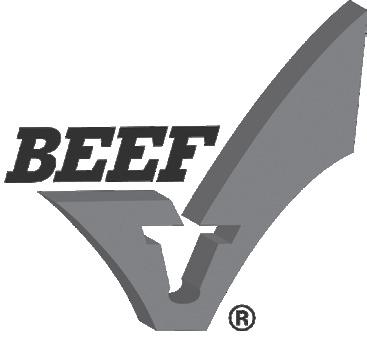
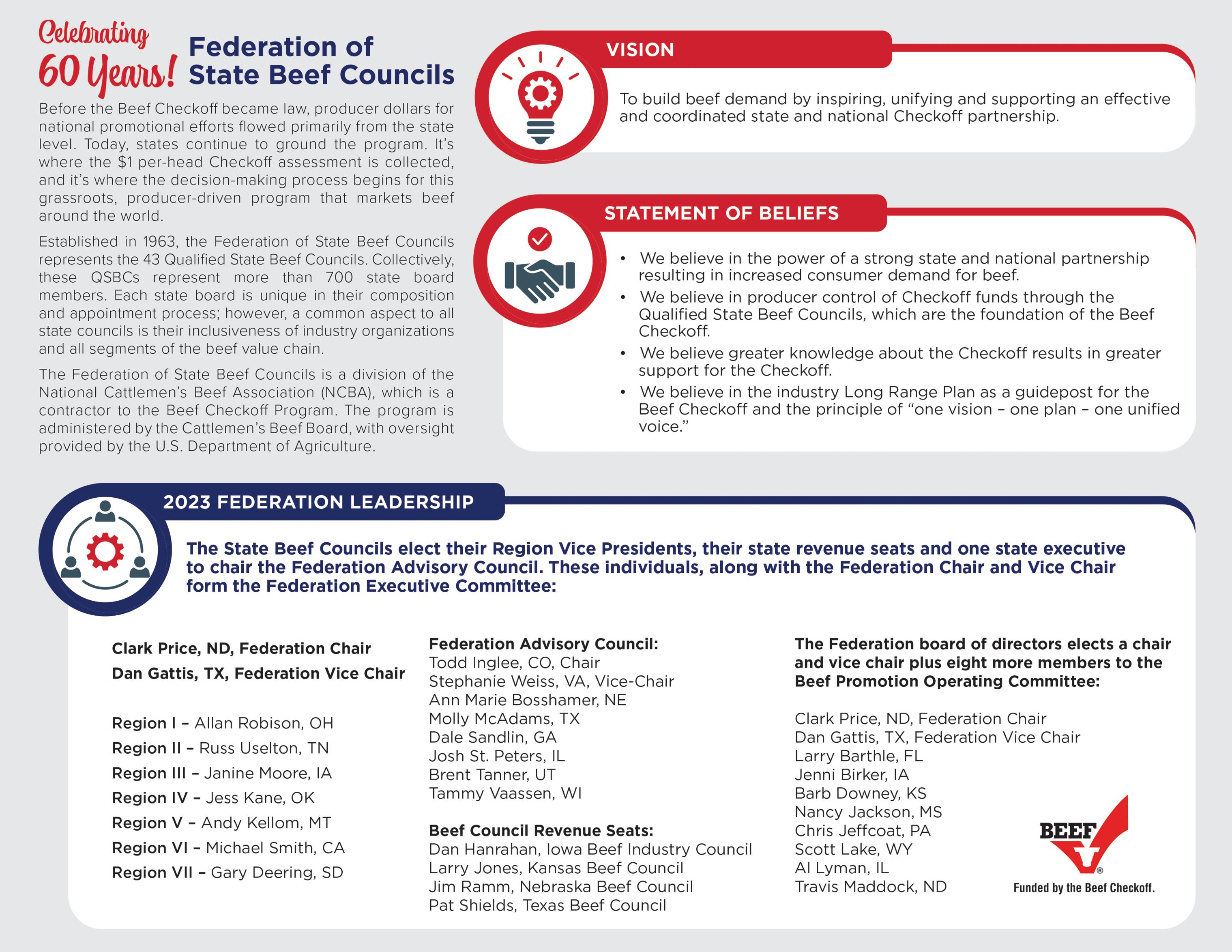
Ranching in the High Desert Country of New Mexico. If you want to stump John Sisk, ask him for his definition of a good rancher. He’ll talk all day about genetics, pasture conditions, weather, weaning weights, breed up, and the rest of the many day-to-day things that occupy a rancher’s mind. But in ranching, with so many things beyond your control, it’s hard sometimes to realize the sum of the parts is often greater than the whole.
John is happy for folks to take a gander over the fences of the Bonita Canyon Ranch in Corona, N.M., where he’s been the manager since 1984. They’ll see happy, contented cows with shiny, black coats.
The cow herd is commercial Angus. Sisk prefers the older genetic lines in the breed because they have a smaller frame size and doability to perform well in rough, rocky terrain.
Ranching in the Rough CountryBonita Canyon Ranch is a grass operation, with the main species being blue grama, sideoats grama, and western wheatgrass. But those grasses have to muscle their way up through rough country that doesn’t get a lot of rain. Riomax tubs help utilize this dry winter grass, allowing him to only feed cake once or twice a week.
At around 6,500 feet in elevation, the
winters are usually cold and windy and sometimes lack precipitation. Because of that, he moved his calving season from January-February to April-May and weans in October. Even with moving to a later calving date, his calves still wean consistently at around 550 pounds. And he’ll buy some yearlings and run them through the summer.
The calves are sold directly off the ranch, often commanding a 30-35¢ per pound premium. “There are no growth hormones in them,” he says. “It’s just what they can do off their mammy, grass, and genetics.”
Beat - Since about 2019, the cattle on the Bonita Canyon Ranch have been on Riomax tubs year around. As this country is lacking in copper, the availability of copper in the tubs seems to help the cattle slick off a little quicker with their hair coat looking shiny, not dull and fuzzy. The old adage “the way cattle look on the outside is a good indicator of what’s happening inside.” Because the
tubs are out yearlong, he knows even the “shy” cow has her needs met.
“Riomax does a good job for us,” he says. “I’ve tried other mineral supplements, and Riomax is very consistent on consumption, not overdoing it which helps the bottom dollar. Their vitamin-mineral package cannot be beaten when compared to other companies.”
Oh, and his definition of a good rancher? “Mostly it’s being a good steward of the land. You do that, and the land will take care of the cattle with minimal input from you.”
That’s a pretty good elevator speech, don’t you think?
About Riomax. Riomax started in a one car garage and today works with countless ranchers all across the United States and Canada. Their mission — To bring profitability back into agriculture. Learn more about their nutritional products for cattle, horses, sheep, and soil at www.riomax.net/products



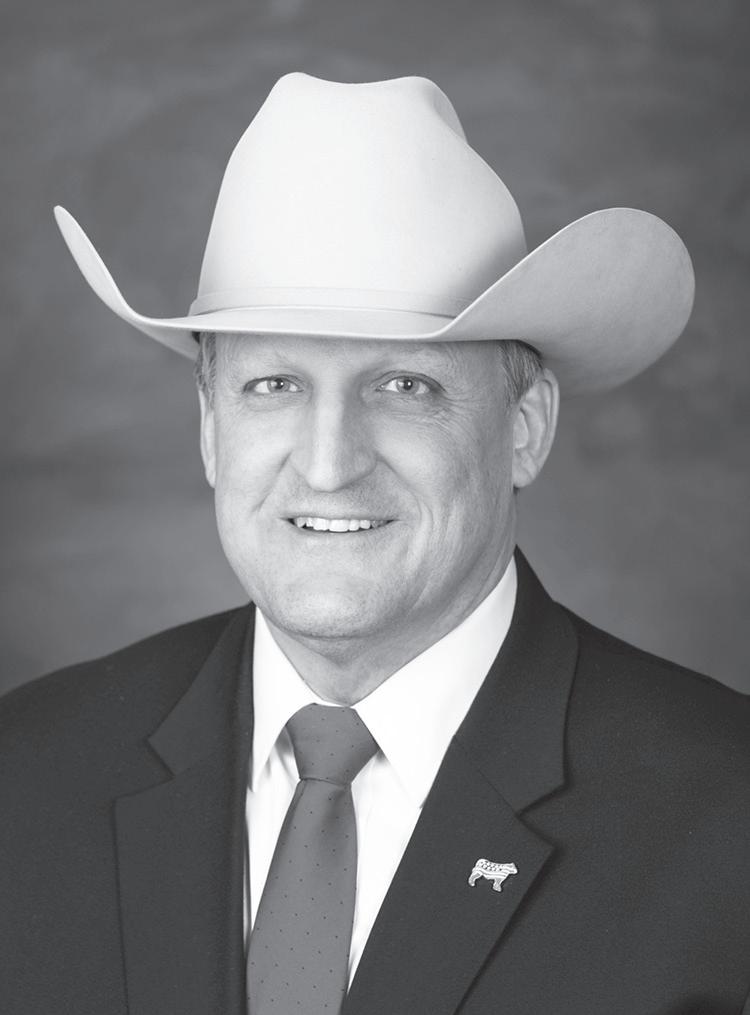 By TODD WILKINSON National Cattlemen’s Beef Association
By TODD WILKINSON National Cattlemen’s Beef Association


As farmers and ranchers, we recognize the multitude of benefits that come from fusing purpose to profit. It’s how we operate sustainable businesses while producing a great product that consumers continue to demand. We impact our business and this industry with how we adopt new ideas and technologies to build sustainable growth.
But sometimes, it feels hard enough to keep up with the current, let alone advance for the future. In business, we can’t do it all. Identifying priorities and focusing on what adds value is critical to every business.
Genetics and marketing have always
been important to my family’s operation. When I first started raising cattle, our focus was on building the best cow herd we could by identifying genetics that would work for our environment and finishing operation. In 2003, BSE threw our industry a curve ball, and we suddenly found ourselves trying to regain export market share. This signaled a change in marketing and the need to include age and source verification on finished cattle to regain access to export markets, so we did this for an economic advantage. Another shift to our business happened when my
son wanted to come back to the ranch. Over the years, Wilkinson Livestock went from a cow/calf and finishing operation to a cow/calf and stocker operation growing cattle for the Prime Pursuits program. An evolving family dynamic actually created value for our business. This move also connected us with breeders using the best genetics and gave us insight into employing the latest cutting edge science.
My involvement in the industry has shown me that things we have always done, conservation and animal handling practices, to be specific, are very valuable across the supply chain, especially to consumers. The opportunity is to continuously improve how we do these things and look for avenues where improvement in these practices adds value.
Continual improvement by all of us is an investment in the future. The way I see it, advancing for the future is two fold in our business. There has to be a level of understanding of what works for our unique business models and what doesn’t. We cannot follow every trend out there. But we also must recognize that our industry is ever evolving because our consumer is ever evolving, and the ways to capture profitability are ever evolving. If we’re not focused on advancing for the future, we’re
missing the boat. With increasing operational costs, efficiency and innovation will dictate success. Operating the same as it was done 50 years ago and being resistant to changing market conditions can be a recipe for disaster. Working together, let us retain the best of the past while embracing those innovations that can best lead us into the future.
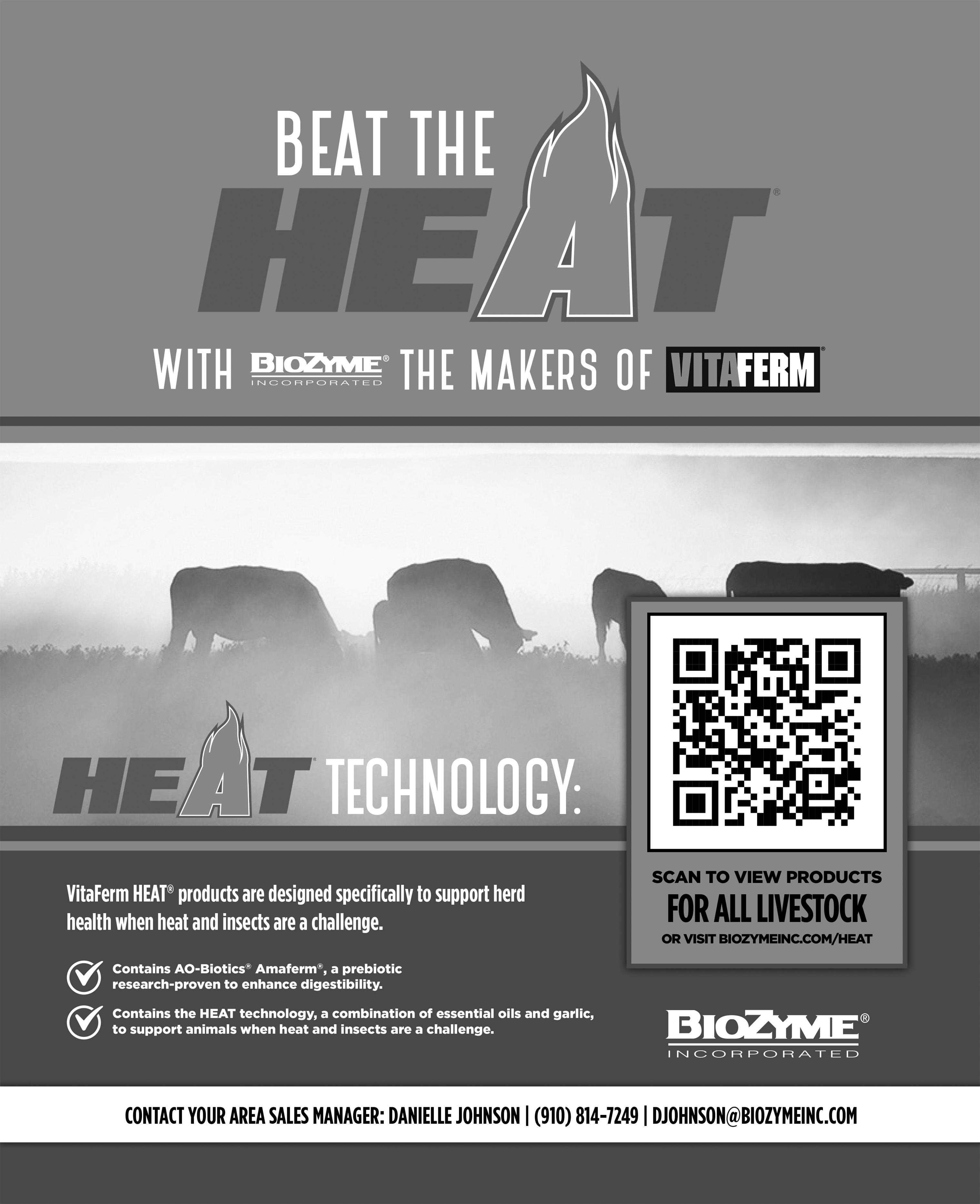
Eating Right is Important for Cattle, Too. Fourth in a Series based on 1980s Ads Featuring BioZyme Founder. Who doesn’t enjoy a properly prepared, balanced meal? For some, an ideal dinner might include a juicy, grilled steak packed with zinc, iron, protein, amino acids, and multiple B vitamins, a green leafy salad filled with fiber, Vitamins A & C, a baked potato that includes potassium, carbohydrates and other important vitamins, and even a bowl of ice cream that provides calcium, riboflavin, and niacin. Your cattle are no different. Eating a healthy, balanced meal is important for their overall health and productivity.
“Eating right. It does for your cattle, what it does for you,” is the headline in one of the 8x10 advertisements from the 1980s for BioZyme’s VitaFerm products. It features the company founder in his suit and tie seated at a table about to dine on the kind of meal previously described. The copy then states, “Like us, cattle need a balanced diet to perform well. They need good food. Plenty of water. And don’t forget vitamins and minerals. That’s where VITA FERM comes in.”
VitaFerm is a line of nutritional supplements for beef cattle that maximize energy and forage utilization for successful production. There are a variety of VitaFerm minerals to fit multiple needs and price points. All VitaFerm products contain AO-Biotics Amaferm, a prebiotic research proven to enhance digestibility. Another line of mineral in the BioZyme family of products that Ehlert would likely be proud of that contains Amaferm is Gain Smart. Gain Smart is a line of vitamin and mineral supplements for stocker cattle that promotes healthy, economic pounds by maximizing the energy and protein available in the diet.
As producers start thinking about turning cows onto pasture and planning their breeding strategies, they need to consider their nutritional plans. Even with extreme amounts of rain and snow across much of the U.S. this winter, the lush, green grass doesn’t always provide everything that cows need. The same can be said for fall born calves soon to be weaned and turned out to pasture.
Chris Cassady, Ph.D., Beef Technical Sales Manager, cautions producers to be mindful of grass tetany when pastures are lush.
“Grass tetany occurs when high potassium and nitrogen levels in the plant interfere with magnesium absorption in
the ruminant, leading to a deficiency. This can and should be easily alleviated by providing a high mag mineral for at least three weeks before turnout on lush forage. Minerals are a tiny component of a transition diet for rebreeding, but can do big things when it comes to achieving your reproductive goals,” Cassady said.
A mineral like VitaFerm Concept•Aid Mag/S contains magnesium to help prevent grass tetany. It also includes organic copper, iodine, and zinc for maximum bioavailability, innate immunity, and hoof health, as well as high levels of Vitamin E to support reproductive tract repair and milk quality, all things important as those cows continue with lactation and prepare for rebreeding.
Other considerations this time of year is making sure that your herd has adequate protein and energy. Just because you have fresh, green pastures doesn’t mean those green grasses have plenty of either. When in doubt, get your forages tested.
“Nearly all of protein in these immature forages is in the degradable form (RDP), meaning the microbes in the rumen quickly break down these proteins to ammonia. Not only can this lead to bloat issues, but if energy is limited, this ammonia can’t be converted into microbial protein and is absorbed directly into the bloodstream. High levels of ammonia in the blood have been linked to reduced reproductive efficiency as well as impaired oxygen carrying capacity. If you see cows panting on a beautiful cool spring day, it could be due to excess protein consumed at a high rate, and could lead to extra stress and embryonic loss, even when you think you’re doing a service to your cows by allowing them to graze knee deep green grass,” Cassady said. “Make sure that your cow diets are at least adequate in energy before concerning yourself over the protein level. Providing a bale of dry hay with average to low protein content can help add fiber and dry matter to their diet, as well as dilute the amount of protein they consume daily.”
Be sure your animals are eating right. You wouldn’t deprive yourself of a balanced meal, so don’t deprive your cattle of one either. Give them adequate water, feed, vitamins, and minerals tied together with Amaferm. Your herd will thank you.
To learn more about either VitaFerm
or Gain Smart or to find a dealer near you, visit www.vitaferm.com
BioZyme Brands Cover all Sectors of the Beef Business. If you are in the cattle business, chances are you’ve likely heard of VitaFerm, and perhaps over time, you’ve mistaken VitaFerm as a company. If you have, you aren’t alone. However, VitaFerm is one of several offerings in the family of brands manufactured by BioZyme Inc.
VitaFerm is a line of nutritional supplements for beef cattle that maximize energy and forage utilization for successful production. VitaFerm is BioZyme’s flagship mineral that was first introduced by company founder Larry Ehlert several decades ago.

Within the last decade, beef cattle product offerings were expanded to
include stockers and weaned calves. The Gain Smart mineral was introduced as a free choice vitamin and mineral supplement for stocker cattle designed to maximize efficient gain. Four formulas exist to give those backgrounding calves in various scenarios options: Gain Smart Stocker, Gain Smart Wheat, Gain Smart Balancer RU 1600, and Gain Smart Stocker HEAT. As their names suggest, they are designed to best complement the diet. Gain Smart Balancer RU 1600 contains rumensin for improved feed efficiency.
The Gain Smart Stocker HEAT is one of many products that contain HEAT
Continued on the next page
Cattle Receipts: 19,778 • Previous Month: 15,730 Feeder supply - 25% steers • 43% heifers • 30% bulls
BioZyme News continued from the previous page technology, a combination of essential oils and garlic to support animals when heat and insects are a challenge.
While the Gain Smart formulas focus specifically on stockers and weaned calves, VitaFerm itself is tailored towards the cow/calf market, thanks in part to the VitaFerm Concept•Aid products created to help promote effective, easy breeding when fed 60 days pre-calving through 60 days post-breeding. Several formulas exist to tailor to individual management scenarios. To find the Concept•Aid formula right for your operation, visit the Concept •Aid Navigator.
In addition to Concept•Aid, VitaFerm offers several other formulas. Cattlemen’s Blend is an all purpose, free choice vitamin and mineral supplement for beef cattle on pasture that supports nutritional health. Cattlemen’s Blend complements a wide variety of forages to ensure nutrient requirements are correctly balanced.
For those trying to conserve spending while still providing adequate vitamins, minerals, and Amaferm to their herd, there is VitaFerm Conserve. Various options of VitaFerm Conserve exist in both a loose mineral and in a tub. All formulas feature a complete but economic vitamin and mineral package.
A complete line of VitaFerm HEAT products is also available. In addition to the HEAT technology, all VitaFerm HEAT products also contain organic copper, iodine, and zinc for maximum
bioavailability, innate immunity, and hoof health. The VitaFerm brand also offers formulas with ClariFly.
“From conception to harvest or conception to rebreeding, BioZyme makes a nutritional product that is right for any scenario. Once you’ve invested in your genetics, you don’t want to gamble on your nutrition. We believe in precision nutrition, where we provide options within a premium line of products that match the exact needs of your animals and your available resources. Maximizing genetic potential through the best nutritional program allows cattle to work for you and your customers,” said Chris Cassady, Ph.D. BioZyme offers nutritional support for every sector of the beef industry. For the seedstock operation, commercial cattle producer, or the backgrounder, there is a complete vitamin and mineral program with Amaferm designed specifically for your scenario. Perhaps you’d like to mix Amaferm into your own ration? You can do that, too. To learn more about Amaferm and the options that are available, visit www.biozymeinc.com
Take your Show Livestock to the Extreme. Spring has arrived, and though it might not feel like it in some regions, soon, the temperatures will be heating up. Flies are one of the nuisances that accompany the heat, and together they can cause unwanted stress on your livestock projects. BioZyme Inc. has created Sure Champ Extreme with ClariFly to help you beat the heat and ward off those pesky flies.
Sure Champ Extreme with ClariFly is a pelleted, daily supplement for show livestock designed to support hoof health, hair coat, and performance when temperatures are above 70ºF. It contains BioZyme’s HEAT technology, a combination of essential oils and garlic, as well as ClariFly to support animals when heat and insects are a challenge.
and stay in top shape when temperatures are elevated. In addition to the ClariFly and HEAT technology, it also contains biotin and zinc to support the skin, hair and hooves, making it an all around great supplement for show livestock.”
ClariFly is known to control up to 96 percent of the fly population in the larval stages. In addition, our HEAT technology supports herd health when heat and insects are a challenge.
To beat the heat, control flies, and help your animals #PreptoWin this spring and summer, give them Sure Champ Extreme with ClariFly. To locate a dealer or learn more, visit www.surechamp.com.
About BioZyme Inc. BioZyme Inc., founded in 1951, develops and
manufactures natural, proprietary products focused on animal nutrition, health, and microbiology. With a continued commitment to research, BioZyme offers a complete line of feed additives and high density, highly available vitamin, mineral, trace mineral, and protein supplements for a variety of animals, including cattle, pigs, poultry, sheep, goats, horses, and dogs. BioZyme brands include AO-Biotics ® , VitaFerm®, Gain Smart®, Vita Charge®, Sure Champ®, Vitalize®, DuraFerm®, and Backyard Boost®. With headquarters in St. Joseph, Missouri, the company reaches a global market of customers that stretches into countries across five continents. For more information about BioZyme, visit www.biozymeinc.com
Feeder supply - 37% steers • 42% heifers • 18% bulls
Have you forgotten something?
Make sure your cattlemen friends are members of your state association!

Sure Champ is no stranger to the show livestock world and has helped livestock exhibitors #preptowin for decades. Beginning in the Spring of 2023, Sure Champ Extreme will see a few changes. Now, all Sure Champ Extreme includes ClariFly, and it is labeled for cattle, pigs, sheep, and goats. The product is available in both a 25 and 40 pound bag, giving users added options.
“In an effort to practice increased sustainability with recyclable packaging, while offering our customers a range of sizes, we made the decision to offer Sure Champ Extreme in two bag sizes,” said Chris Cassady, Ph.D. “Great for at home and on the road, Extreme helps animals adapt to changes in the environment,

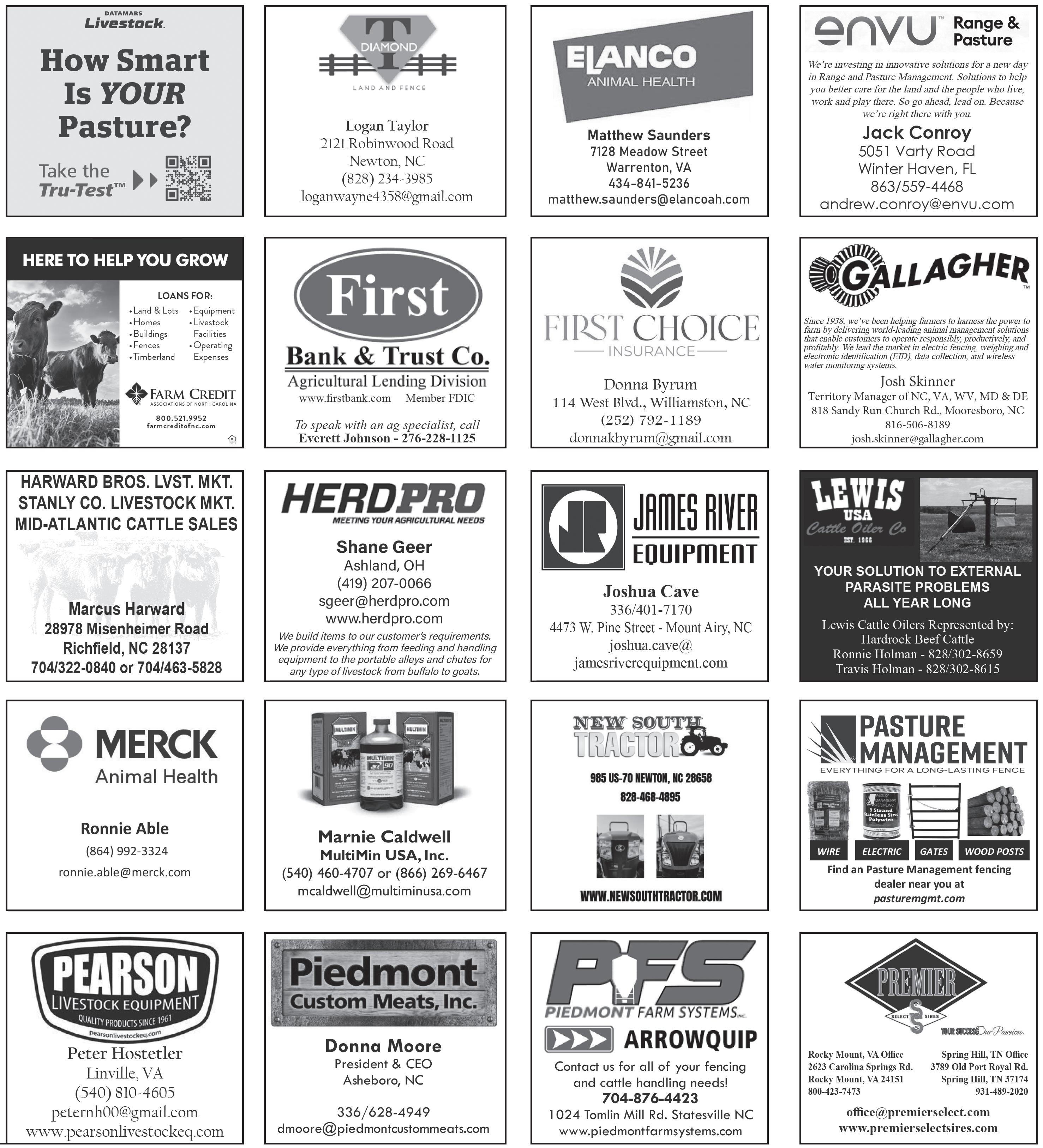
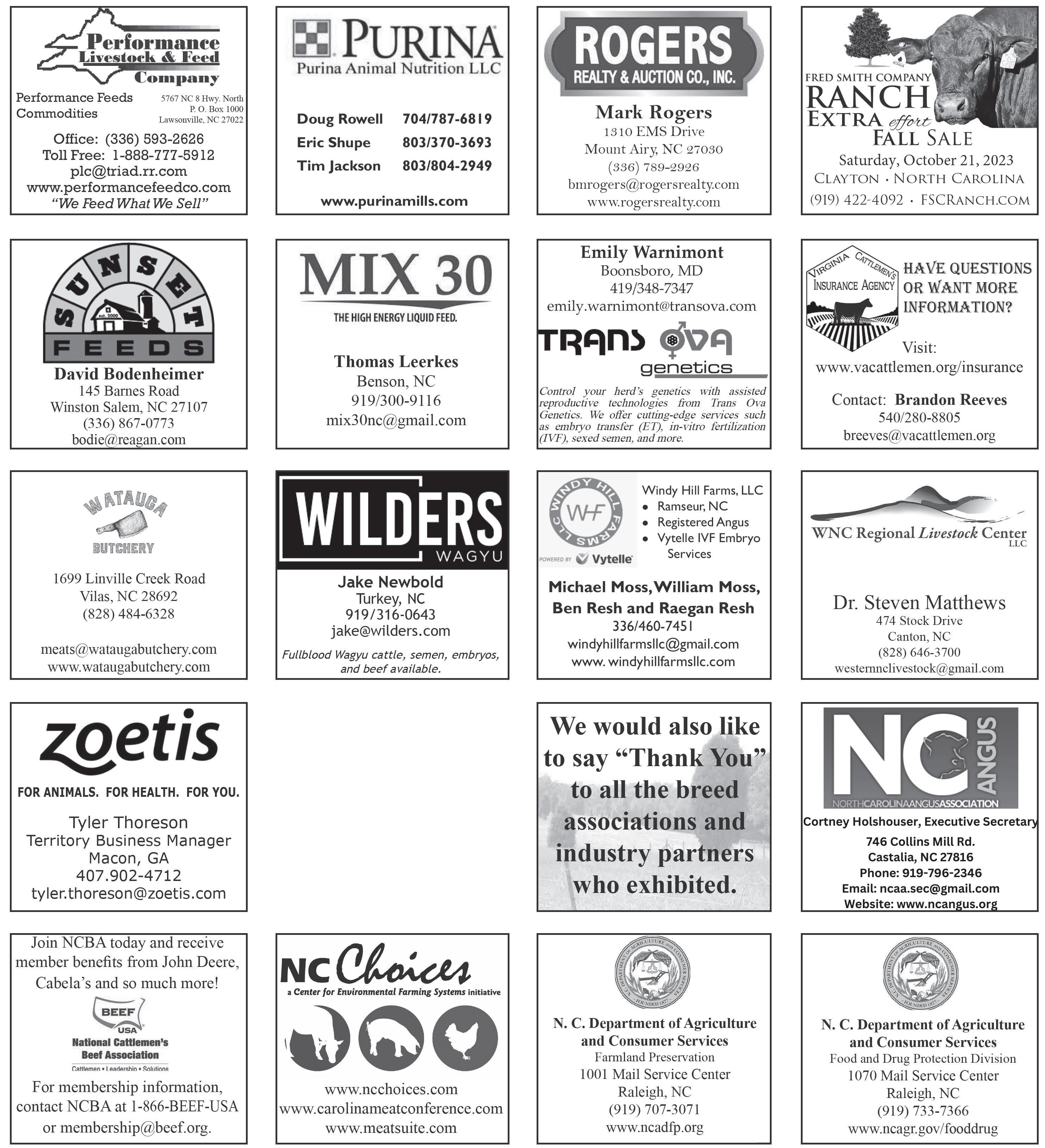
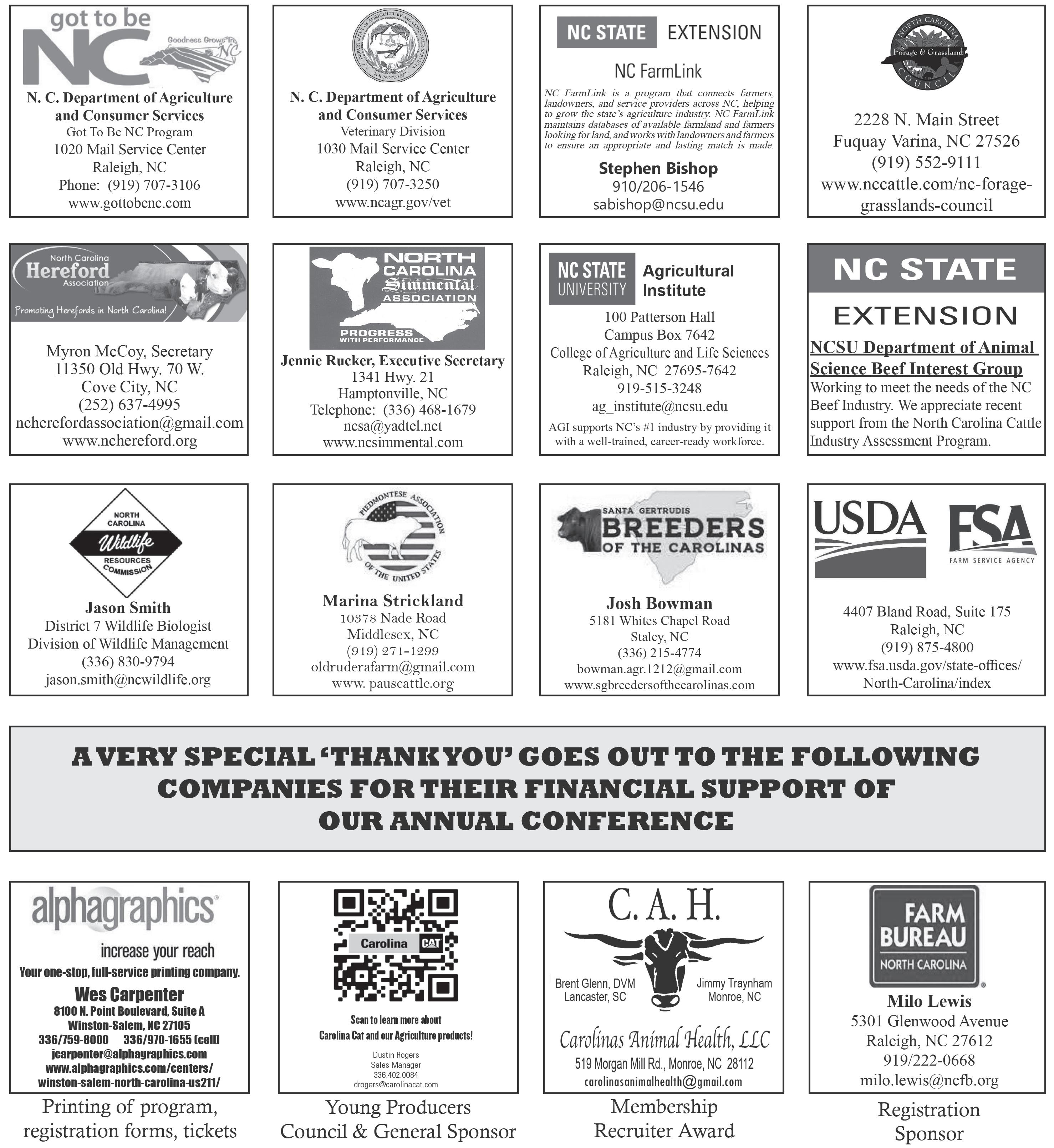

Discover new communication strategies. Learn about corporate social responsibility reporting and how to connect with Generation Z. Connecting with skeptical consumers about animal agriculture is becoming increasingly important as issues like environmental stewardship and animal welfare are topof-mind for customers, investors, and other key groups. The Animal Agriculture Alliance’s 2023 Stakeholders Summit will feature two panels focused on how you can engage the right audiences and communicate effectively. The 2023 Summit is set for May 4-5 in Arlington, Va., and themed “Partners in Progress: Building a Sustainable Future for Animal Ag.”
In a session titled “Telling Your Story: Understanding Corporate Social Responsibility Reporting,” panelists will discuss how the animal agriculture and food communities can both walk the walk and talk the talk when it comes to sustainability. Driving positive conversations with media, investors, and others can be a challenge, and it takes a strategic effort that requires a commitment to invest in key initiatives to make it believable as you tell your story. That’s where corporate social responsibility comes in. A corporate social responsibility platform is good for any organization and essential for those that deal with misinformation and loud adversarial voices. Attendees will walk away with the knowledge of what to do (and what not to do) when crafting their own corporate social responsibility platforms. Led by Marcy Tessman of C.O.nxt, panelists include Cassie Jo Arend of Shiftology, Christina Lood of Zoetis, and Sydney Reese of Prime Pursuits. This panel is sponsored by the National Pork Producers Council.
During the session “Engaging with Consumers: From A to ‘Gen Z,’” attendees will learn how Generation Z is poised to change the face of food. This emerging consumer segment brings a distinct set of values, behaviors, and purchasing power undergirded by pressing questions about the values of those producing our food, production practices, and the impact on people, animals, and the planet. Expert communicator Roxi Beck of The Center for Food Integrity, sustainable seafood educator Emily De Sousa of Seaside
with Emily, and beef rancher Cassidy Johnston of Not Your Average Rancher will explore how to engage “Gen Z” and others effectively based on both research and practice. The session will be moderated by Amanda Lucey, CEO of The Partnership.
“Consumers are craving more information about environmental stewardship, animal welfare, and antibiotic use related to our food choices,” said Emily Solis, manager of communications and content, Animal Agriculture Alliance. “The farm and food communities need to be proactive in engaging with audiences that are hungry to learn more by proudly sharing the work that is already being done along with future goals for continuous improvement. These panels at the upcoming Summit will equip and empower attendees with the tools to do just that.”
Explore agriculture’s sustainability commitments and how we’ll meet them. Learn about supply chain sustainability and the role of technology in the future of agriculture. Sustainability is increasingly rising as a top priority for consumers, investors, and professionals within the food and farming communities, and adopting emerging technologies is one way the animal agriculture community is rising to the challenge of building a sustainable future. The Animal Agriculture Alliance’s 2023 Stakeholders Summit will feature two panels discussing supply chain sustainability and the role of technology in meeting sustainability commitments as part of a robust agenda.
During the session “Supply Chain Sustainability: Practical Lessons from the Field to the Corporate Office,” panelists will discuss how sustainability efforts must include all stakeholders, from farmers to food brands. Led by moderator Sara Crawford, Ph.D. of Sustainable Environmental Consultants, panelists will highlight a collaborative attempt to combine science and data with real change and show the value of having the right partners on the journey. Attendees at any stage of the process can learn valuable lessons on creating and implementing a successful sustainability program, whether they are just starting to set goals or have already set their goals but aren’t sure how to drive positive change. Panelists include Jennifer Simpson of Danone North America,
Angela Anderson of Starbucks, and Matt Fry of Fair Hill Farms.
Adopting emerging technologies is one way the supply chain can meet current and new sustainability commitments. In the session “Technology in Agriculture: Building on Sustainability Progress,” moderator Sarah Little of the North American Meat Institute will lead speakers through a discussion about new developments, including the dairy community’s journey to net zero by 2050, new collaborative initiatives within the feed sector, and what it means to set the standard for sustainable animal breeding. Panelists include Austin Gellings of the Association of Equipment Manufacturers, Paul Davis, Ph.D., of the American Feed Industry Association, and Johan van Arendonk, Ph.D., of Hendrix Genetics.
“No matter where you sit in the food supply chain, we all care about the sustainability of agriculture and the long term health of our planet,” said Emily Solis. “While sustainability efforts are nothing new to the farm and food communities, we’re all looking for new ways to further our progress. These two panels will provide attendees with the tools they need to partner across the supply chain, use new technological resources, and continue mitigating our environmental impact.”
Gain practical solutions to animal rights extremism. Animal agriculture and the food community remain a top target of animal rights extremists. Activism and security experts will share current trends in the animal rights movement and practical solutions to mitigate these potential threats at the Animal Agriculture Alliance’s 2023 Stakeholders Summit.
Animal rights extremists remain hostile to animal agriculture, and their efforts to take meat, dairy, poultry, eggs, and seafood off of our consumers’ plates could undermine food security and our efforts to produce sustainable, affordable food. How can the animal agriculture and food community handle these security threats? In the session “Practical Solutions: Responding to Animal Rights Extremism in 2023,” attendees will hear from three experts as they share the latest trends in activism as well as relevant, real world takeaways to protect yourself and your livelihood from extremists. Panelists include Jason Roesler, an independent security consultant with a background in the fur community; Jim Newman, director of strategic communications, Americans for Medical Progress; and Andrea Bertaglio, campaign manager, European Livestock Voice.
“Far too often, farmers and ranchers and those directly involved in raising and
producing meat, dairy, poultry, eggs, and seafood – and getting them to the end consumer at grocery stores and restaurants – are targeted by animal rights extremists looking to tarnish the reputation of the animal agriculture community,” said Abby Kornegay, manager, issues and engagement, Animal Agriculture Alliance. “I cannot stress enough how important it is to be proactive, rather than reactive, in these situations by implementing practical farm and facility security measures, as well as being prepared to respond to activism from a communications standpoint. This panel of security experts will equip attendees with those recommendations that they can take home and put into place right away.”
Thank you to our 2023 Summit sponsors - Farm Journal, MEAT + POULTRY, Meatingplace, National Pork Producers Council, Watt Global Media, American Feed Industry Association, National Cattlemen’s Beef Association, National Pork Board, Smithfield, United Soybean Board, Dairy MAX, Elanco, Farm Credit, Mountaire Farms, United Egg Producers, American Farm Bureau Federation, American Veal Association, Bayer Crop Science, Cal-Maine Foods, Cobb-Vantress, Inc., Filament Marketing, Kemin, National Chicken Council, Progressive Dairy, Protect the Harvest, Trans Ova Genetics, Tyson, Vivayic, Agricultural Modeling and Training Systems, Edge Dairy Farmer Cooperative, Eggland’s Best, Live Oak Bank, N.C. Farm Bureau, and Sustainable Environmental Consultants.
The Alliance also thanks the following members for their continued support of Summit and other Alliance programs - U.S. Poultry & Egg Association, Zoetis, Aviagen Group, Boehringer Ingelheim, Cargill, C.O.nxt, Dairy Farmers of America, Diamond V, Genus PLC – PIC/ABS, Hendrix Genetics, Hy-Line North America, LLC, Iowa Soybean Association, JBS, Kansas Soybean Commission, Merck Animal Health, Midwest Dairy, National Turkey Federation, Nutrien, Provimi North America, Inc., and Seaboard Foods.
About the Animal Agriculture Alliance. The Alliance safeguards the future of animal agriculture and its value to society by bridging the communication gap between the farm and food communities. We connect key food industry stakeholders to arm them with responses to emerging issues. We engage food chain influencers and promote consumer choice by helping them better understand modern animal agriculture. We protect by exposing those who threaten our nation’s food security with damaging misinformation.

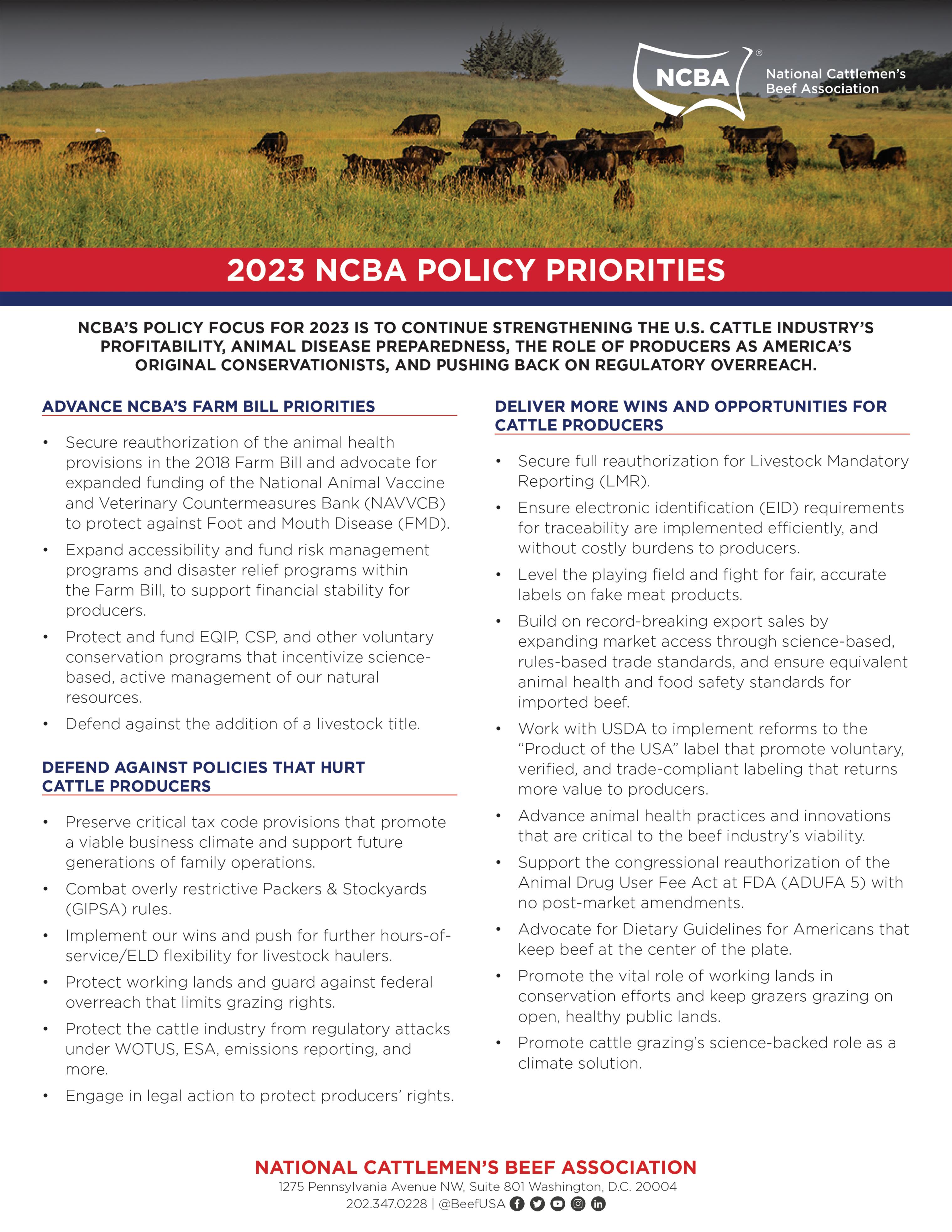


Information is required by (7 CRF 1260.201). Failure to report can result in a fine. Information is held confidential (7 CRF 1260.203).
Today’s Date: ________________
Seller’s Name: ____________________________
Buyer’s Name: ____________________________
Address: Address:
City: ________________ State: ____ Zip: City: ________________ State: ____ Zip: ______
Seller’s Signature: _________________________
Buyer’s Signature: _________________________
Both the seller & the buyer are responsible for making sure that the $1.50 per head assessment is collected and remitted to the Beef Promotion & Research Board.
Total Number of Cattle Sold: ___________________ x $1.50 Per Head = $
Date of Sale: __________________ Person remitting assessment form: Seller o Buyer o
* State of Origin of Cattle:
* If the cattle purch ased came from another state within the last 30 days, indicate from which state the cattle were purchased.
SOUTH CAROLINA BEEF COUNCIL
P.O. Box 11280

Columbia, SC 29211
According to the Paperwork Reduction Act of 1995, an agency may not conduct or sponsor, and a person is not required to respond to a collection of information unless it displays a valid OMB control number. The valid OMB control number for this information collection is 0581-0093. The time required to complete this information collection is estimated to average 1.8 minutes per response, including the time for reviewing instructions, searching existing data sources, gathering and maintaining the data needed, and completing and reviewing the collection of information.
The U.S. Department of Agriculture (USDA) prohibits discrimination in all its programs and activities on the basis of race, color, national origin, gender, religion, age, disbility, sexual orientation, marital or family status, political beliefs, parental status, or protected genetic information. (Not all prohibited bases apply to all programs.) Persons with disabilities who require alternative means for communication of program information (Braille, large print, audiotape, etc.) should contact USDA’s TARGET Center at 202-720-2600 (voice and TDD).
To file a complaint of discrimination, write USDA, Director, Office of Civil Rights, Room 326-W, Whitten Building, 14 th and Independence Avenue SW, Washington, DC 20250-9410 or call 202-720-5964 (voice and TDD). USDA is an equal opportunity provider and employer.
Expand Options for Packing Capacity. National livestock groups have come together to support Congressional efforts to expand opportunities for industry to invest in meat packing capacity. The American Farm Bureau Federation, American Sheep Industry Association, Livestock Marketing Association, National Cattlemen’s Beef Association, National Pork Producers Council, and the U.S. Cattlemen’s Association sent a letter to the Chairpeople and Ranking Members of the Senate and House Agriculture Committees expressing the groups’ support of legislation to allow livestock market owners and operators to own or invest in small or regional livestock packing facilities.
The bipartisan legislation, the Expanding Local Meat Processing Act (S. 813), was reintroduced by Senators Ben Ray Lujan (D-N.M.) and Joni Ernst (R-Iowa) recently. This is the Senate companion to the Amplifying Processing of Livestock in the United States (APLUS) Act (H.R.530), being led by U.S. Representatives Mark Alford (RMo.), Jimmy Panetta (D-Ca.), and Dusty Johnson (R-S.D.). If enacted, these bills would direct the Secretary of Agriculture to update a regulatory prohibition under the Packers and Stockyards Act which bars livestock auction owners from owning or investing in packers.
“This is an antiquated rule that does not fit with the current, transparent method of selling livestock at an open auction where sellers can view the transaction either in person or by streaming the auction online,” the letter states.
The bills would allow for investment in the packing industry at local and regional levels by those active in the livestock marketing business.
“We appreciate our partners, both on Capitol Hill and at fellow livestock groups, fighting for opportunities to enhance participation in livestock packing,” said Mark Barnett, LMA President and owner of KentuckyTennessee Livestock Market. “Livestock auction markets, like mine, are in the competition business. Allowing livestock auction owners to invest in small and regional packers could enhance competition, which equates to needed additional profit for producers who are
being squeezed by high inputs and low margins.”
If you have questions about this legislation, please get in touch with Chelsea Good, Vice President of Government and Industry Affairs & Legal, at cgood@lmaweb.com or 816305-9540.
Economic impact study shows livestock auctions are growing in importance for rural vitality; $2 million in total value added dollars to community. A 2023 economic impact study, which updated a study from 2017, found that livestock auction markets continue to be important for the growth and vitality of rural communities. The study of an average, fixed facility livestock auction market revealed that the market provides approximately $2 million in total value added dollars to its local community. This result is up from $1 million identified in the 2017 Livestock Marketing Association (LMA) Economic Impact Report.
The case livestock auction market, located in a rural Missouri town with a population of less than 5,000, sells all classes of cattle in a weekly sale. The auction market was selected as a representative example of LMA memberlivestock auctions based on the type of operation, gross sales of livestock, rural location of the market, and population of the city. LMA represents 85 percent of the livestock auction markets in the United States, with cattle being the largest per head species sold through livestock auction markets annually (32 million head, per 2020 USDA P&S Annual Report data).
Key findings also revealed that the market studied provides 17 jobs, generating $888,000 in labor income for the community’s economy. Additionally, the market contributes $447,000 in local taxes and $108,000 in federal taxes. Of the total value added number, contributions were also made by the onsite café, which further provides labor income and state, local, and federal taxes.
“Livestock auction markets today remain critical to helping our rural communities continue to thrive,” said Kristen Parman, LMA Vice President of Membership Services. They generate a competitive sale environment which results in cash for local livestock producers. That cash equals dollars spent
in town and investments back into their businesses and operations.”
In collaboration with LMA, the study was completed by Decision Innovation Solutions in Urbandale, Iowa.
About the Livestock Marketing Association. The Livestock Marketing Association (LMA), headquartered in Overland Park, Kan., is North America’s leading national trade association

dedicated to serving its members in the open and competitive auction method of marketing livestock. Founded in 1947, LMA has more than 800 member businesses across the U.S. and Canada and remains invested in both the livestock and livestock marketing industries through support, representation, and communication efforts. For more information, visit www.LMAWeb.com
Lower the anxiety — simple pasture tips for 2023. Four fundamentals of pasture recovery. Springtime brings a wealth of cattle and pasture management tasks. Truth be told: It can be overwhelming. And we’ve had all winter to think about what we’d like to do differently this year, right? So where to start?
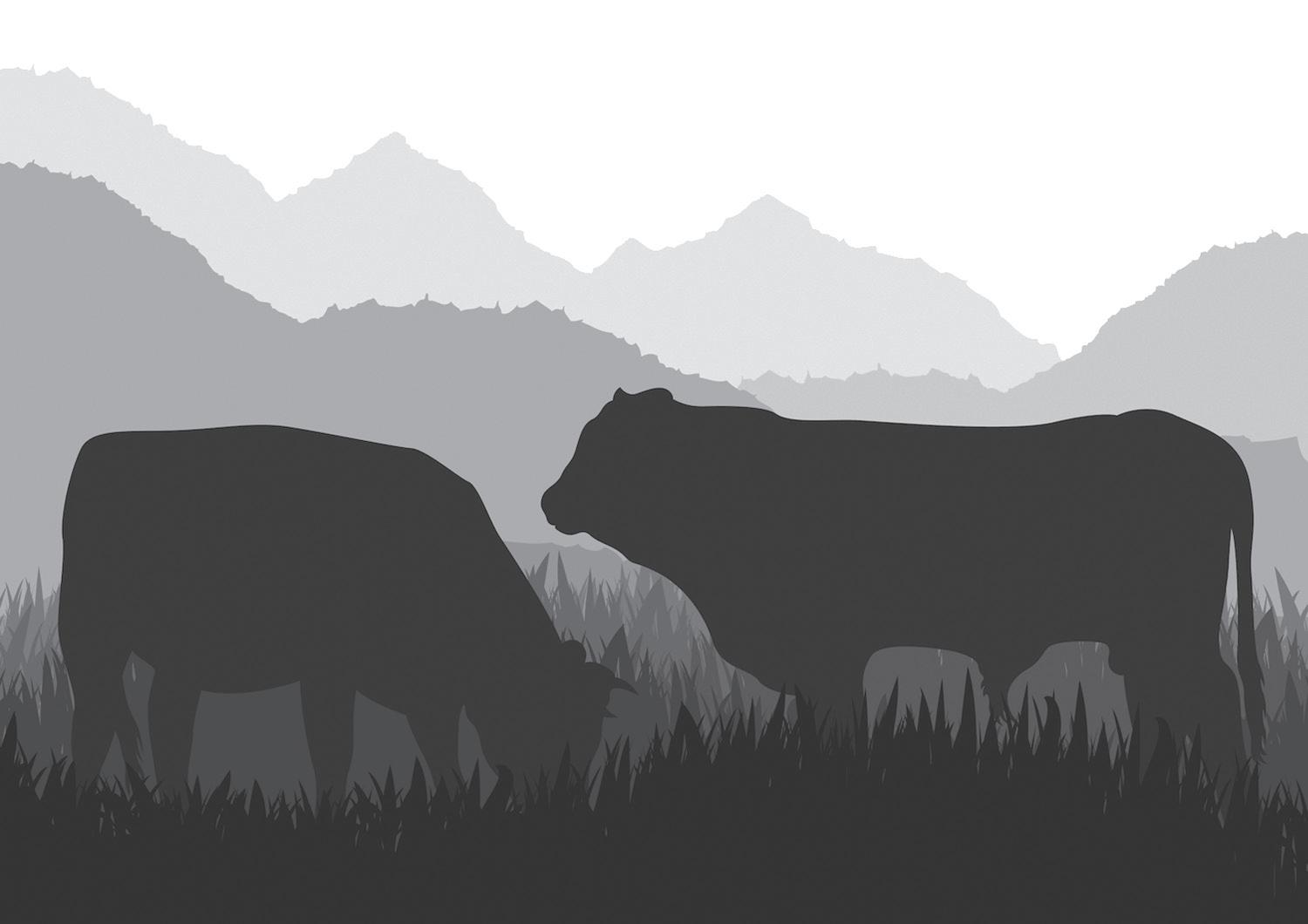
Jeff Clark, Range & Pasture market development specialist for Corteva Agriscience, suggests producers shorten their to do list and concentrate on fundamental factors of pasture management.

1. Soil health - Soil fertility is your “engine.” Take soil samples. And then follow the soil sample recommendations! Invest in pastures and empower grasses to fuel your cattle.
2. Weed management - Identify weed problems in the spring or summer and how they affect investment. Do not use a “shotgun approach.” Instead, concentrate on the top culprits.
a. Take care of your hayfields first.
b. Then move to grazing pastures.
3. Grazing management - Don’t stress pastures by overgrazing and risk killing the roots. The plant can only grow
what the root can provide.
4. Watch stocking rate - Although it’s not always an easy decision, take advantage of higher cattle prices to cull underperforming animals more tightly. Return the money to invest in pasture improvement programs.
About Corteva. Corteva, Inc. is a publicly traded, global pure play agriculture company that combines industry leading innovation, high touch customer engagement, and operational execution to profitably deliver solutions for the world’s most pressing agriculture challenges. Corteva generates advantaged market preference through its unique distribution strategy, together with its balanced and globally diverse mix of seed, crop protection, and digital products and services. With some of the most recognized brands in agriculture and a technology pipeline well positioned to drive growth, the company is committed to maximizing productivity for farmers while working with stakeholders throughout the food system as it fulfills its promise to enrich the lives of those who produce and those who consume, ensuring progress for generations to come. More information can be found at www.corteva.com

Alltech ONE World Tour announces spring European stops in Budapest and Dublin. Dates and locations have been announced for the spring European leg of the Alltech ONE World Tour, a series of exciting international events that bring the ideas and inspiration of Alltech’s annual ONE Conference to the world. The first stops are in Budapest, Hungary, on May 22-23 and Dublin, Ireland, on June 19-20.
The Alltech ONE Conference has been held in Lexington, Kentucky, home of Alltech’s global headquarters, for the past 38 years. In 2023, the global leader in agriculture is bringing the conference to its partners, customers, suppliers, and friends across the globe, providing the opportunity for more people than ever to experience the power of ONE.
The Alltech ONE World Tour will explore collaborative solutions to the greatest challenges facing the agri-food industry, uniting changemakers and thought leaders to examine regional and local market trends in agriculture, business, health, and nutrition.
“As our customers and partners continue to face many challenges and uncertainties, we determined that 2023 would be dedicated to meeting them
in their market,” said Dr. Mark Lyons, president and CEO. “This special edition of the ONE will endeavor to deliver global expertise to locally relevant issues. In the midst of economic and political uncertainties that fuel regionalization, this ONE reflects the responsibility we have as a global company to be a connector of people and ideas, ever advancing our purpose of Working Together for a Planet of Plenty.”
The Alltech ONE World Tour will continue with stops in Canada, the U.S., Asia, South America, and the Middle East.
For more information and to register for an Alltech ONE World Tour stop, visit one.alltech.com.
Alltech feed division announces new leadership roles. Alltech is pleased to announce new leadership roles within the Alltech feed division. Scot Harold will assume commercial leadership as executive vice president, Feed & Premix, and Brian Gier will join the company as vice president of sales for Hubbard Feeds.
“As we position the business for future growth, we continue to evolve and work together across all parts of our business to best serve our customers,” said Mike Castle, chief operating officer at Alltech. “Scot and Brian will bring leadership and experience that will enable us to capitalize on opportunities within our feed business to continue to develop species alignment and leverage the strengths of our team.”
Harold joined Alltech in 2020 as the director of sales for Ridley Feed Ingredients, part of the Alltech feed division. He will work with the leadership team to develop and implement strategy for the growth of the feed business while strengthening alignment across the feed, premix, and specialty ingredients teams.
Prior to joining Alltech, Harold served as Cargill Animal Nutrition’s national sales leader for both the Dealer & Multi-Store Ag Retailer segments.
Alltech welcomes Gier to the team from Purina Mills, where he served as vice president of sales. He was responsible for overseeing the company’s commercial livestock strategy, as well as the lifestyle portfolio, and was instrumental in the success of the coop segment, including several joint ventures. Gier’s wealth of experience in the feed industry will contribute to enhanced customer success.
For more information about Alltech,
visit alltech.com. About Alltech. Founded in 1980 by Irish entrepreneur and scientist Dr. Pearse Lyons, Alltech delivers smarter, more sustainable solutions for agriculture. Our diverse portfolio of products and services improves the health and performance of plants and animals, resulting in better nutrition for all and a decreased environmental impact.
We are a global leader in the agriculture industry. Our team produces specialty ingredients, premix supplements, feed, and biologicals backed by science and an unparalleled platform of services.
Strengthened by more than 40 years of scientific research, we carry forward a legacy of innovation and a unique culture that views challenges through an
entrepreneurial lens. As a private, family owned company, we adapt quickly to our customers’ needs and focus on advanced innovation.
We believe agriculture has the greatest potential to shape the future of our planet. Our more than 5,000 talented team members worldwide share our purpose of Working Together for a Planet of Plenty™. Together, we can provide nutrition for all, revitalize local economies, and replenish the planet’s natural resources.
Headquartered just outside of Lexington, Ken., Alltech serves customers in more than 120 countries, has five bioscience centers, and operates more than 80 manufacturing facilities across the globe. For more information, visit www.alltech.com
Vytelle Closes $20 Million in Series B Funding to Accelerate Genetic Progress in Cattle. Vytelle, a precision livestock company, has raised $20 million in Series B funding to accelerate genetic progress in cattle. With this new investment, Vytelle will continue to expand its global operations while delivering the most accessible, reliable, and predictable reproductive technology available to customers today.
The investment was led by Forage Capital Partners, a Calgary based growth equity fund that invests across the entire food and agriculture value chain. New investor Mountain Group Partners joins current investors, Grosvenor Food and Ag Tech, Open Prairie, Fulcrum Global Capital, Serra Ventures, and KC Rise to complete the round.
Forage Capital Partners Jim Taylor said, “Vytelle has proven their ability to scale and deliver consistent results for the benefit of cattle producers aiming to accelerate genetic progress around the world. We are impressed with Vytelle’s track record of growth and delivery and are excited about what the future will bring.”
Vytelle’s integrated technology platform combines Vytelle ADVANCE, a breakthrough in-vitro fertilization (IVF) technology, with Vytelle SENSE, an animal performance data capture system, and Vytelle INSIGHT, an artificial intelligence based genetic analytics

engine.
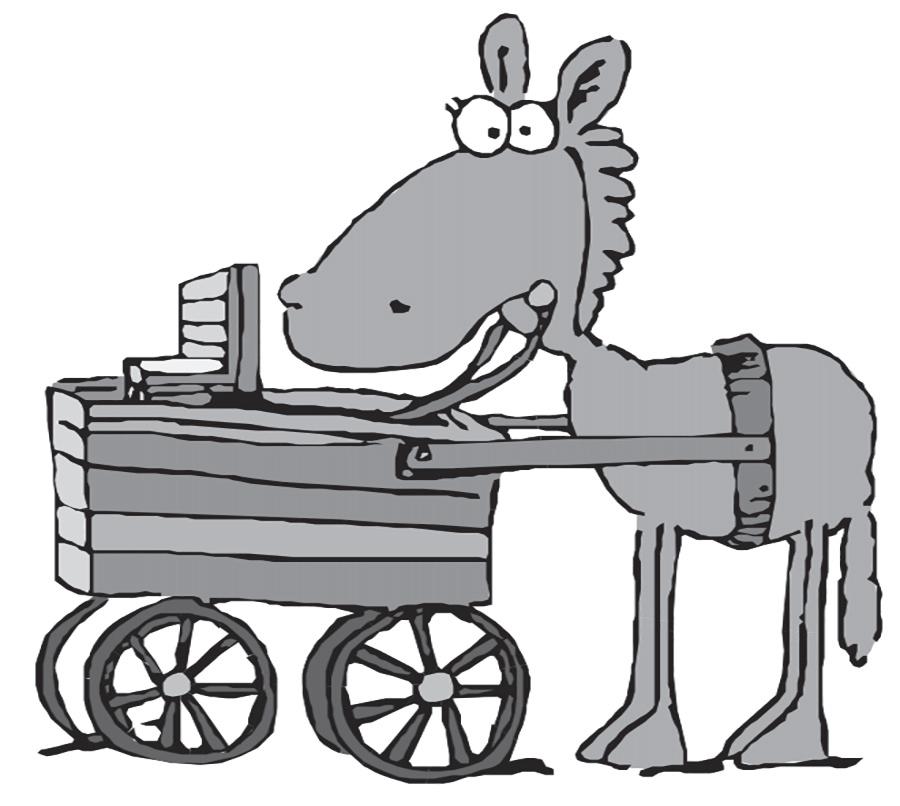
As the fastest growing advanced reproduction company, Vytelle is easily accessible to more than 50 percent of the United States cow herd. Combining this footprint with Vytelle’s curation of the world’s largest multibreed efficiency database provides the infrastructure to impact bovine genetic progress rapidly. Progressive cattle producers can use the technology to multiply the impact of elite livestock productivity and profitability, sustainably delivering more protein with fewer inputs.

“We are delighted to have secured this new investment; this is indicative of strong market interest in our products and services. Our mission is clear, and we are grateful for the support of our investors who join us on our journey to ensure meat and milk are viable food choices for future generations,” said Kerryann Kocher, CEO of Vytelle.
About Vytelle. Vytelle is a precision livestock company reshaping how cattle producers worldwide optimize their herds. Through Vytelle’s integrated technology platform, generations of genetic gains can be made in just a few years. This allows producers to sustainably deliver more protein with fewer inputs, helping to ensure meat and milk are viable, competitive food choices for future generations. For more information about Vytelle, please visit www.vytelle.com.
Don’t put your cart before your horse...advertise that sale ahead of time! You’ll see positive results.







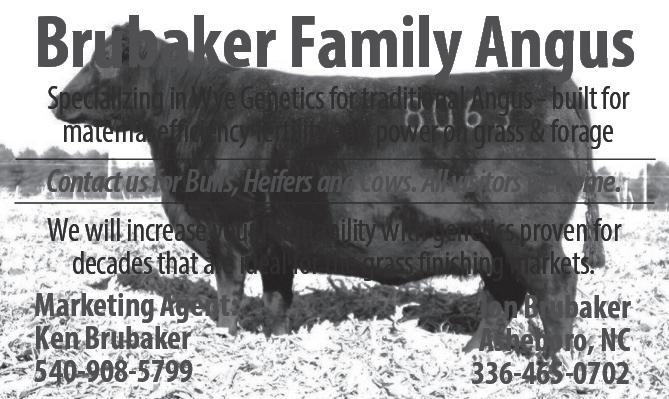
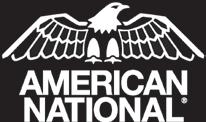
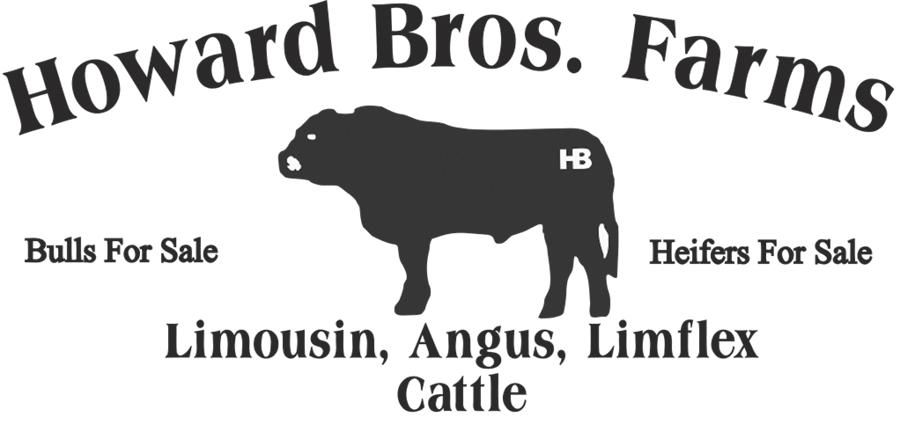













ANGUS
May 6 — Whitestone Farm 30th Annual Pasture Performance Tested Angus Bull & Female Sale, Aldie, Va.
May 20 — Shuffler Farm Performance
Legends Female Sale
May 28 — High Ridge Farms Dispersal Sale, Albemarle, N.C.
Sep. 30 — Biltmore Angus Field Day & Fall Sale, Asheville, N.C.
Nov. 4 — Barnett Angus Ranches
4th Annual Bull Sale, Washington, Ga.
Nov. 4 — SimAngus Solution
15th Annual Sale, Burlington, N.C.
Nov. 18 — Southeast Bull Expo & Sale, Asheboro, N.C.
Dec. 1 — Knoll Crest Farm Total
Performance Bull Sale, Red House, Va.
Dec. 23 — 48th Annual Union County
Performance Tested Bull Sale, Monroe, N.C.
2024
Jan. 6 — 15th Annual EBS Select Bull & Female Sale, Monroe, N.C.
brahman
Jun. 3 — Carolinas Brahman Breeders Association 43rd Annual Sale, Laurens, S.C.
Charolais
Oct. 12 — JMar Genetics Quality Over
Quantity Charolais Bull & Heifer Sale, via DVAuctions
GELBVIEH
Dec. 1 — Knoll Crest Farm Total
Performance Bull Sale, Red House, Va.
Dec. 23 — 48th Annual Union County
Performance Tested Bull Sale, Monroe, N.C.
May 6 — S.C. Hereford Association & Red Angus Association of the Carolinas
3rd Annual Sale, Pendleton, S.C.
May 12 — N.C. Hereford Association
Annual Banquet, Statesville, N.C.
May 13 — 55th Annual N.C. Hereford
Classic Sale, Union Grove, N.C.
May 29 — White Hawk Ranch Beef Maid
Female Sale, Buchanon, Ga.
Dec. 1 — Knoll Crest Farm Total
Performance Bull Sale, Red House, Va.
RED ANGUS
May 6 — S.C. Hereford Association & Red Angus Association of the Carolinas
3rd Annual Sale, Pendleton, S.C.
santa Gertrudis
May 13 — Santa Gertrudis Breeders of the Carolinas 50th Anniversary Sale, Monroe, N.C.
SIMMENTAL
May 20 — Shuffler Farm Performance
Legends Female Sale
May 28 — High Ridge Farms Dispersal Sale, Albemarle, N.C.
Sep. 1 — N.C. Simmental Association
Social Event, Union Grove, N.C.
Sep. 2 — N.C. Simmental Association
Fall Harvest Sale, Union Grove, N.C.
Oct. 21 — Fred Smith Company Ranch
Extra Effort Fall Sale, Clayton, N.C.
Dec. 23 — 48th Annual Union County Performance Tested Bull Sale, Monroe, N.C.
WAGYU
Sep. 21-29 — American Wagyu Association & World Wagyu Council Conference, San Antonio, Tex.
Nov. 4 — Wilders Wagyu Stay Wild ‘23
Production Sale, Turkey, N.C.
OTHER EVENTS
May 9 — Beef Quality Assurance
Training, Snow Camp, N.C.
May 14-17 — International Grazing Congress, Covington, Ken.
Jun. 3 — Chessie Creek Farm Commercial Bred Heifer Sale, Walterboro, S.C.
Jun. 22 — Graded Feeder Calf Sale, Norwood, N.C.
Jul. 3-5 — Beef Improvement Federation
Symposium, Calgary, Canada
Aug. 3 — Graded Feeder Calf Sale, Norwood, N.C.
Aug. 5-6 — S.C. Junior Beef Round-Up, Clemson, S.C.
Aug. 12-13 — N.C. Junior Beef Round-Up, Fletcher, N.C.
Sep. 28 — Graded Feeder Calf Sale, Norwood, N.C.
Nov. 16 — Graded Feeder Calf Sale, Norwood, N.C.
Livestock market sales
May 1 — Harward Brothers Livestock
Market Weekly Sale, Statesville, N.C.
May 2 — Mid-Atlantic Cattle Sales
Video Auction, via macsvideo.com
May 3 — Stanly County Livestock
Market Weekly Sale, Norwood, N.C.
May 3 — Wilkes Livestock Exchange
Weekly Sale, North Wilkesboro, N.C.
May 8 — Harward Brothers Livestock
Market Weekly Sale, Statesville, N.C.
May 10 — Stanly County Livestock
Market Weekly Sale, Norwood, N.C.
May 10 — Wilkes Livestock Exchange
Weekly Sale, North Wilkesboro, N.C.
May 15 — Harward Brothers Livestock
Market Weekly Sale, Statesville, N.C.
May 16 — Mid-Atlantic Cattle Sales
Video Auction, via macsvideo.com
May 17 — Stanly County Livestock
Market Weekly Sale, Norwood, N.C.
May 17 — Wilkes Livestock Exchange
Weekly Sale, North Wilkesboro, N.C.
May 22 — Harward Brothers Livestock
Market Weekly Sale, Statesville, N.C.
May 24 — Stanly County Livestock
Market Weekly Sale, Norwood, N.C.
May 24 — Wilkes Livestock Exchange
Weekly Sale, North Wilkesboro, N.C.
May 29 — Harward Brothers Livestock
Market Weekly Sale, Statesville, N.C.
May 31 — Stanly County Livestock
Market Weekly Sale, Norwood, N.C.
May 31 — Wilkes Livestock Exchange
Weekly Sale, North Wilkesboro, N.C.
Jun. 5 — Harward Brothers Livestock
Market Weekly Sale, Statesville, N.C.
Jun. 6 — Mid-Atlantic Cattle Sales
Video Auction, via macsvideo.com
Jun. 7 — Stanly County Livestock
Market Weekly Sale, Norwood, N.C.
Jun. 7 — Wilkes Livestock Exchange
Weekly Sale, North Wilkesboro, N.C.
Jun. 12 — Harward Brothers Livestock
Market Weekly Sale, Statesville, N.C.
Jun. 14 — Stanly County Livestock
Market Weekly Sale, Norwood, N.C.
Jun. 14 — Wilkes Livestock Exchange
Weekly Sale, North Wilkesboro, N.C.
Jun. 19 — Harward Brothers Livestock
Market Weekly Sale, Statesville, N.C.
Jun. 20 — Mid-Atlantic Cattle Sales
Video Auction, via macsvideo.com
Jun. 21 — Stanly County Livestock
Market Weekly Sale, Norwood, N.C.
Jun. 21 — Wilkes Livestock Exchange
Weekly Sale, North Wilkesboro, N.C.
Jun. 26 — Harward Brothers Livestock
Market Weekly Sale, Statesville, N.C.
Jun. 28 — Stanly County Livestock
Market Weekly Sale, Norwood, N.C.
Jun. 28 — Wilkes Livestock Exchange
Weekly Sale, North Wilkesboro, N.C.
A husband and wife were driving through Louisiana. As they approached Natchitoches, they started arguing about the pronunciation of the town. They argued back and forth, then they stopped for lunch.
At the counter, the husband asked the blonde waitress, “Before we order, could you please settle an argument for us? Would you please pronounce where we are very slowly?”
She leaned over the counter and said, “Burrr-gerrr Kiiing.”
During an impassioned sermon about death and final judgement, the pastor said forcefully, “Each member of this church is going to die and face judgement.”
Glancing down at the front pew, he noticed a man with a big smile on his face.
The minister repeated his point louder. “Each member of this church is going to die and face judgement!”
The man nodded and smiled even more.
This really got the preacher wound up. He pounded the pulpit emphatically when he came to the ultimatum: “Each member of this church is going to die and face judgement!!!”
Though everyone else in the congregation was looking somber, the
man in front continued to smile.
Finally the preacher stepped off the platform, stood in front of the man and shouted, “I said each member of this church is going to die!”
The man grinned from ear to ear.
After the service was over, the preacher made a beeline for the man. “I don’t get it,” the preacher said in frustration. “Whenever I said, ‘Each member of this church is going to die,’ your smile got bigger. Why?”
“I’m not a member of this church,” the man replied.
An Indian cab driver picked up a Japanese man from a hotel.
Along the way, they saw a Honda motorcycle overtake the taxicab, and the Japanese guy said, “Motorcycle very fast, made in Japan.”
Then a Toyota car overtook the taxicab and the Japanese guy said, “Car very fast, made in Japan.”
When they reached the destination the fare was 1,500 rupees. The Japanese man thought the ride was would only cost 500 rupees. He asked the driver why the ride was so expensive.
The driver said, “Meter very fast, made in Japan.”

